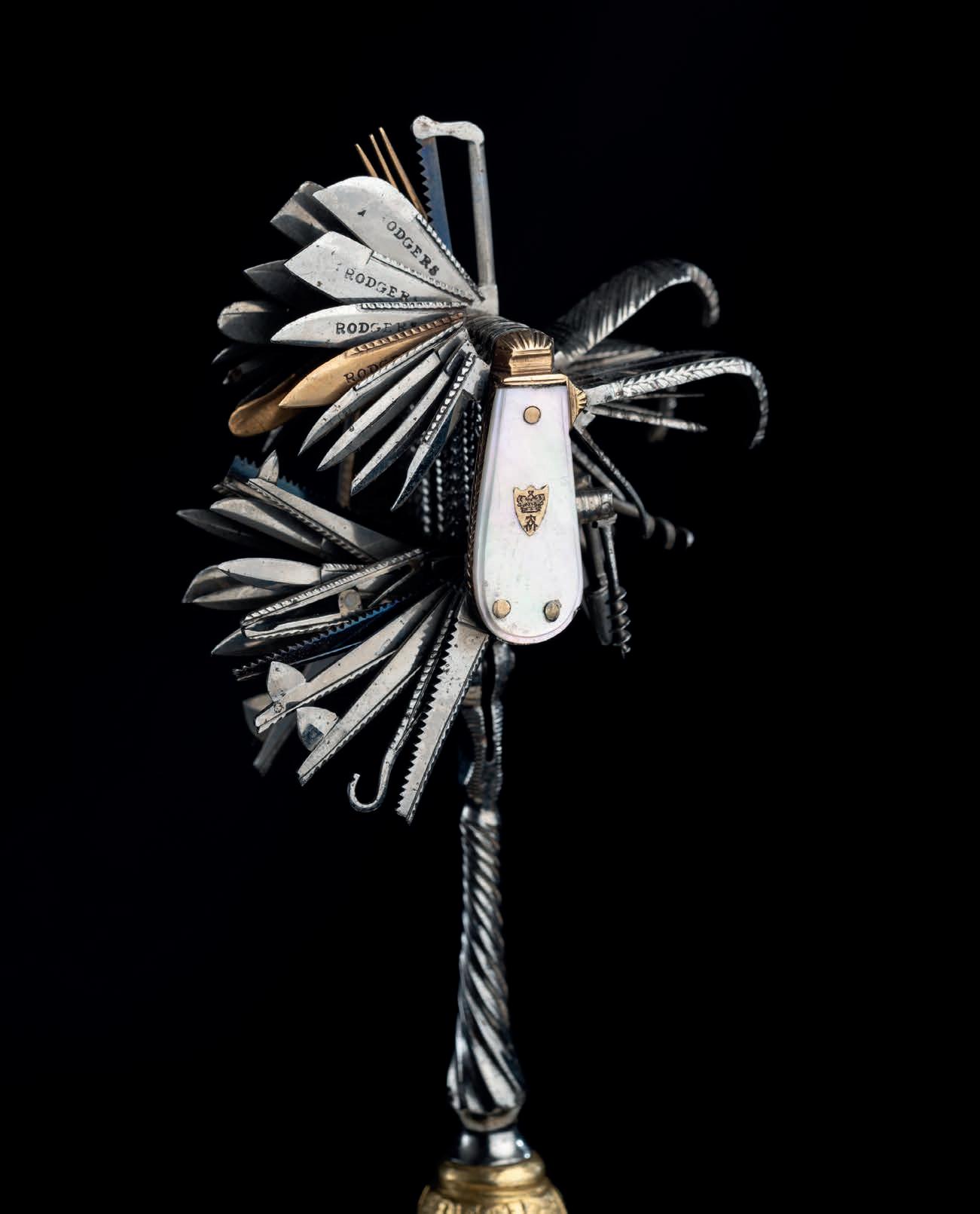Select Bibliography
Bezdek 2009
Culme 1987
Flayderman 2004
Halliday 1986
Hawley, 2023
Hayden-Wright 2008
Southwick 2001
Tweedale 2019
Washer 1974
Winant 1956
Richard Bezdek, Swords of the American Civil War, Boulder 2009
John Culme, The directory of gold and silversmiths jewellers and allied traders 1838-1914 : from the London assay office registers, 1987
Norm Flayderman, The Bowie Knife: Unsheathing an American Legend, 2004
Robert Halliday, ‘The Billy and Charley forgeries’ in The London Archaeologist, Winter 1986
www.hawleysheffieldknives.com accessed January – April 2023
David Hayden-Wright, The Heritage of English Knives, Atglen 2008
Leslie Southwick, London Silver-Hilted Swords: Their Makers, Suppliers and Allied Traders, with Directory, Leeds 2001
Geoffrey Tweedale, Directory of Sheffield Cutlery Manufacturers, 1740-2013, 2019
Richard Washer, Sheffield Bowie and Pocket-knife Makers, 1825-1925, 1974
Lewis Winant, Firearms Curiosa, London 1956
iv
David Hayden-Wright (1936-2006) was born in Christchurch, Hampshire, and lived latterly in a small village in Worcestershire. He served in the 16/5th Queen’s Royal Lancers Cavalry Regiment as a marksman. A keen pistol shot, he developed a profound interest in antique weaponry and registered firearms, assisting authorities on firearms control and working with a number of museums.

Over a period of 40 years, David researched and collected antique knives with a specific focus on Sheffield makers. His timing was fortuitous; as some of the most distinguished manufacturers in Sheffield closed he was able to acquire stock, ledgers and a number of early catalogues (see lots 635, 636, 672, 747 & 748).
His four decades of study and collecting culminated in his meticulously researched and profusely illustrated volume ‘The Heritage of English Knives’, posthumously published by his family in 2008.
The family of David Hayden-Wright are pleased to support the Arms and Armor department of the Metropolitan Museum of Art: a portion of the sale proceeds, and Olympia Auction’s commission, will be given to their acquisition fund.
v

A BRONZE DAGGER IN FANTASTIC MEDIEVAL STYLE, MID-19TH CENTURY
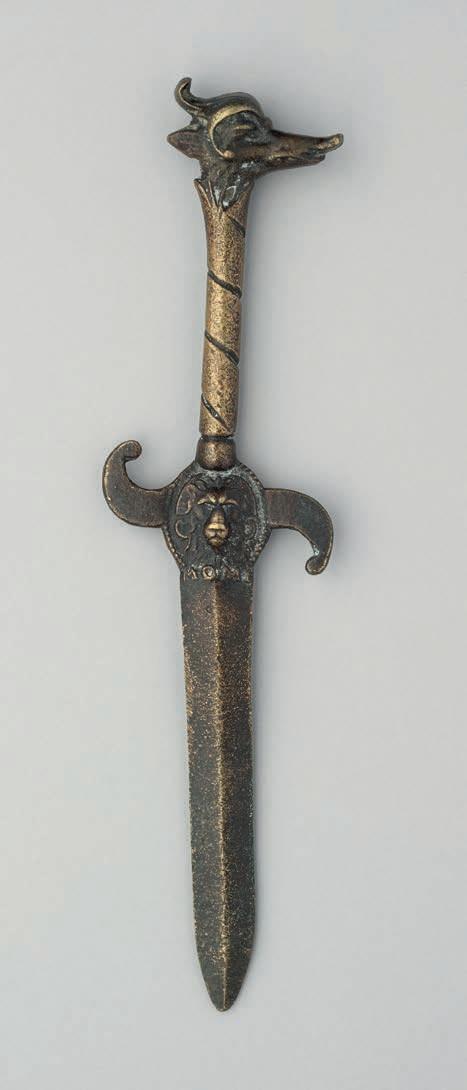
cast in one piece, with tapering double-edged blade of diamondsection, recurved cross-piece with central lion mask boss one face above the spurious date ‘MDMI’ spirally moulded grip and the pommel formed as a gaping monsterhead, 24.3 cm overall

Probably one of the Shadwell Dock Forgeries by Billy Smith and Charley Eaton.
Literature
David Hayden-Wright, The Heritage of English Knives, Atglen, Pennsylvania, 2008, pp. 45-6.
Billies and Charlies, otherwise known as Shadwell Dock Forgeries, were produced in a variety of forms, often as badges, but also as figures, vases, vessels etc., the majority made by the labourers or navigators (navvies) Billy Smith and Charley Eaton. The great public works of the 1840s and 50s had entailed large excavations and dredging operations, which threw up a number of medieval artefacts. Billy and Charley, whilst mudlarking on the Thames, had found a medieval medallion, which they sold for a handsome sum. By 1857, lacking further such finds, the enterprising pair decided to manufacture these objects instead, casting them in a lead copper alloy. The letters usually found on the bases or edges of these pieces make no sense, presumably since the forgers were illiterate. For a year, academics and collectors lapped up these rare pieces, claimed by Billy & Charley to have been found at the construction site of the new Shadwell docks. In 1858 a lecture at the British Archaeological Association condemned them all as forgeries, although in a consequent court case, the eminent scholar Charles Roach Smith pronounced that even the most badly educated forger would not produce such blatantly ridiculous items and that therefore they must be genuine. There continued to be a strong market for the pieces until a couple of years later, when a sceptic uncovered Billy and Charley’s moulds. Billy and Charley escaped prosecution and continued production, but ever increasing awareness of the forgeries meant falling prices, with Charley dying in penury at Tower Hamlets and Billy disappearing from the records by 1871. See Halliday 1986. £100-150
501
501 1
502
AN INDIAN BOWIE KNIFE, T. ARNACHELLUM, CIRCA 1880 with broad single-edged blade formed with a clipped-back reinforced point, stamped by the maker (inverted) on one face, rectangular ricasso, iron guard, chased silver ferule decorated with foliage and silver cap pommel en suite and with a ram’s head on top, in its leather-covered wooden scabbard (losses) with spring retaining clip, 23.5 cm blade
Literature
David Hayden-Wright, The Heritage of English Knives, Atglen, Pennsylvania, 2008, p. 314.
Arnachellum of Salem, Tamil Nadu, was a famous 19th century maker of knives, hunting spears, daggers and cutlery as recorded by Alexander Hunter who wrote in 1875 ‘.....For the last thirty years Arnachellum, of Salem, has perhaps acquired the greatest and the most deserved reputation for the fine quality, as well as the finish, of his knives, hunting-spears, daggers, and tablecutlery. One point in which these have surpassed almost all similar steel-manufactures in Europe, has been their tough hardness, without being brittle.....’ Two other daggers by him are preserved in the Royal Collection (RCIN 38126 and 38127) and another in the Royal Armouries, Leeds, (object no. X388). Egerton stated in 1896 that they had been ‘known for the last fifty years over India.’
£450-550
503
AN INDIAN BOWIE KNIFE, ARNACHELLUM, SALEM, CIRCA 1880 with stout blade formed with a swaged spear point, stamped with the maker’s name on one face and ‘Salem’ at the ricasso, iron hilt comprising guard with rounded quillons and cap pommel, and natural staghorn grip, in its leather-covered wooden scabbard with spring retaining clip, 22.5 cm blade
Literature
David Hayden-Wright, The Heritage of English Knives, Atglen, Pennsylvania, 2008, p. 311.

See footnote to lot 502.
£300-350
504
AN INDIAN BOWIE KNIFE, ARNACHELLUM, SALEM, CIRCA 1880 with stout blade formed with a swaged spear point, stamped with the maker’s name on one face and ‘Salem’, small rectangular ricasso, iron guard with bud-shaped quillons, and natural staghorn grip, in its leather-covered wooden scabbard with spring retaining clip, 17.5 cm blade
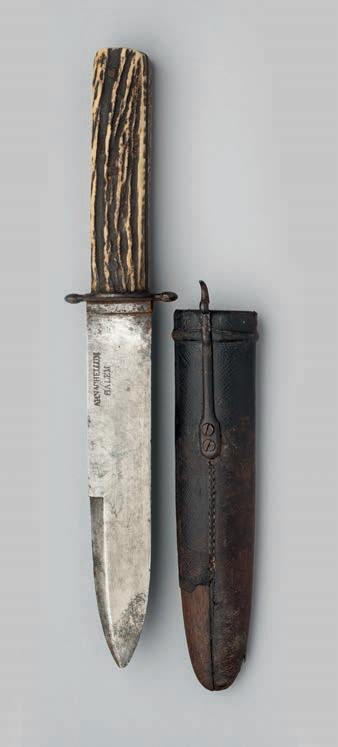


Literature
David Hayden-Wright, The Heritage of English Knives, Atglen, Pennsylvania, 2008, p. 318.
See footnote to lot 502.
£250-300
502
See page iii for Buyer’s Premium and other charges 503 504 2
505
AN INDIAN BOWIE KNIFE, ARNACHELLUM, SALEM, CIRCA 1880 with stout blade formed with a swaged spear point, stamped with the maker’s name and ‘Salem’ on one face, recessed ricasso, iron hilt comprising guard with rounded quillons and chased white metal cap pommel, and natural staghorn grip, in its leathercovered wooden scabbard (spring retaining clip missing, 20.8 cm blade
See footnote to lot 502.

£200-300
506
506
AN INDIAN BOWIE KNIFE, CIRCA 1880, AND TWO FURTHER KNIVES the first with stout blade formed with a swaged clipped point, with traces of the maker’s name, Austin, on one face, recessed ricasso, and natural staghorn grip with an iron ferrule and cap pommel, in its leather-covered wooden scabbard with spring retaining clip; the second with broad blade formed with a swaged point, recessed ricasso, white metal guard and natural staghorn grip, in its leather scabbard; the third with broad blade, recessed ricasso stamped ‘Monarch’, brass guard and cap pommel and pineapple chequered grip, in its scabbard, the first: 19.0 cm blade (3)

£300-350

505
3
507
A RARE INDIAN DAGGER, BODRAJ, AURUNGABAD, SECOND HALF OF THE 19TH CENTURY
with broad double-edged blade, signed rectangular ricasso, iron guard, and natural staghorn scales over milled copper alloy fillets, with five folding elements including fleam, scissors, belt hook and corkscrew and with concealed tweezers (pick missing), in its iron-mounted leather scabbard, 28.5 cm blade
Literature
David Hayden-Wright, The Heritage of English Knives, Atglen, Pennsylvania, 2008, p. 314.
£400-600
508
AN INDIAN HUNTING KNIFE, TREACHER & CO., BOMBAY & POONA, CIRCA 1880-90 with broad single-edged blade formed with a swaged spear-point and filed backedge, etched with the maker’s details on one face, rectangular ricasso, German silver elliptical guard, milled copper alloy fillets, and natural staghorn scales retained by five rivets and with vacant German silver escutcheon, in its German silver mounted leather scabbard with spring retaining clip, 20.0 cm blade
Literature
David Hayden-Wright, The Heritage of English Knives, Atglen, Pennsylvania, 2008, p. 312.

Treacher and Company Limited are recorded as preparers of drugs and pharmaceutical products in Bombay, Salsette Island, Maharashtra, and Poona, India, circa 1870-90.
£250-300
509
AN INDIAN COPY OF A WILKINSON SHAKESPEAR DAGGER, EARLY 20TH CENTURY with broad double-edged blade stamped ‘Boput’ and ‘Nagpure’ (unclear, mis-struck) on one face, iron hilt and chequered grip with button for scabbard release, in its steel-mounted leather-covered scabbard, 26.5 cm blade
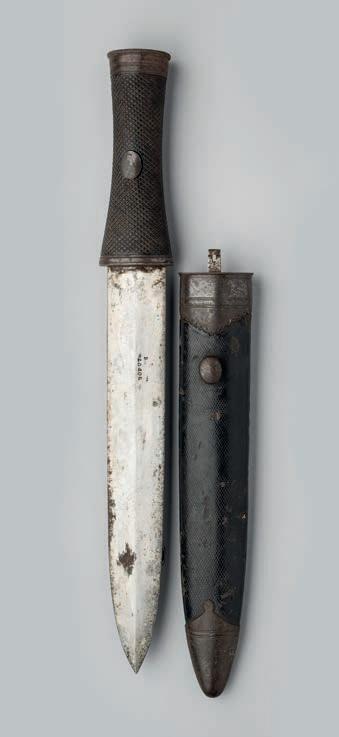
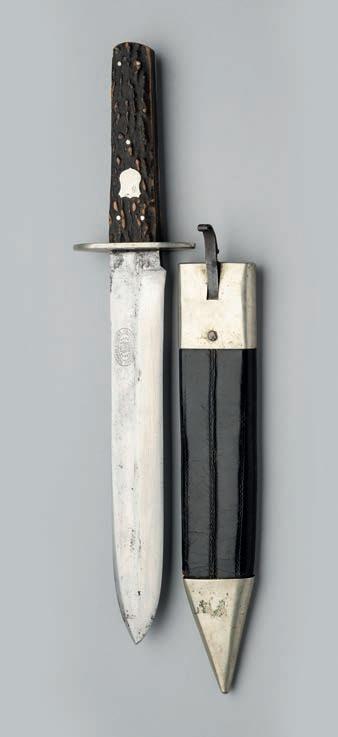

Literature
David Hayden-Wright, The Heritage of English Knives, Atglen, Pennsylvania, 2008, p. 313.
£500-700
See page iii for Buyer’s Premium and other charges
507 508
4
509
510
AN INDIAN DAGGER, SECOND HALF OF THE 19TH CENTURY with broad stout double-edged blade filed with four grooves on the back-edge at the ricasso, iron hilt comprising guard formed of a pair of slightly up-turned quillons, cap pommel and horn gip (cracked), in its iron mounted fabric-covered wooden scabbard, 26.5 cm blade
Literature
David Hayden-Wright, The Heritage of English Knives, Atglen, Pennsylvania, 2008, p. 313.
£250-300
511
TWO INDIAN DAGGERS, LATE 19TH CENTURY
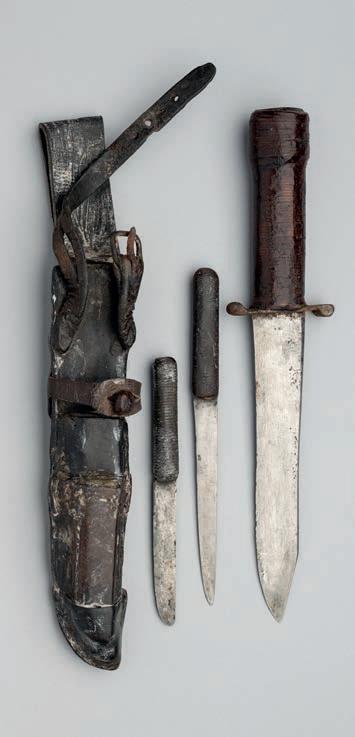
the first with straight blade formed with a clipped-back point, iron guard with globular quillons, and leather-covered grip, in its scabbard with two accompanying knives; the second with single-edged blade with a clipped-back point, copper alloy guard, German silver ferrule, and horn scales in its leather scabbard, the first: 15.0 cm (2)
Literature
David Hayden-Wright, The Heritage of English Knives, Atglen, Pennsylvania, 2008, pp. 310 and 313.

£200-250
512
AN INDIAN BOWIE KNIFE, CIRCA 1880 with stout blade formed with a swaged spear point, iron hilt comprising oval guard, ferrule, and moulded cap pommel, and natural staghorn grip, in its steelmounted leather-covered wooden scabbard with associated corkscrew with staghorn grip, 24.5 cm blade
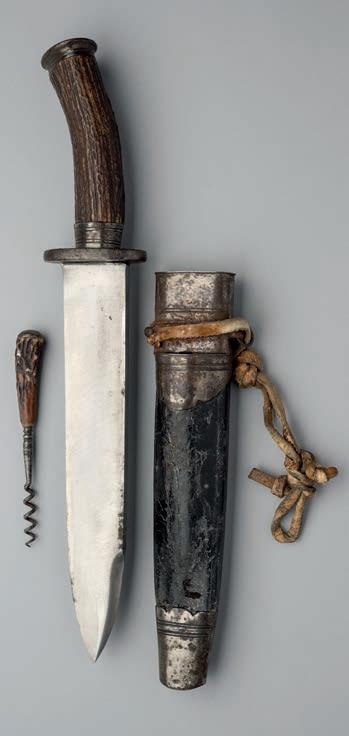

Literature
David Hayden-Wright, The Heritage of English Knives, Atglen, Pennsylvania, 2008, p. 311.
£300-350
510 511 512
5
AN INDIAN BOWIE KNIFE, LATE 19TH CENTURY
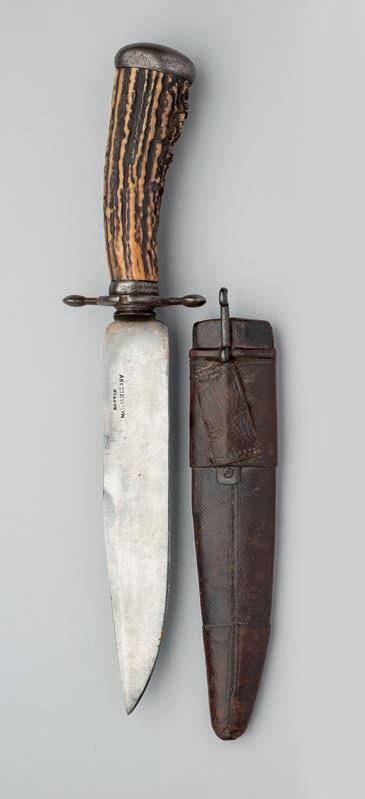


with broad blade formed with a clippedback point, iron military style guard, and pierced pommel, and leather-covered grip, in its steel-mounted leather scabbard with spring retaining clip, 27.3 cm blade

Literature
David Hayden-Wright, The Heritage of English Knives, Atglen, Pennsylvania, 2008, p. 315.
£250-300
AN INDIAN BOWIE KNIFE, LATE 19TH/EARLY 20TH CENTURY
with broad heavy blade formed with a swaged point, recessed rectangular ricasso, oval steel guard, and natural staghorn grip, in its tooled leather scabbard with engraved German silver mounts, 21.0 cm blade
Literature
David Hayden-Wright, The Heritage of English Knives, Atglen, Pennsylvania, 2008, p. 316.
£250-350
AN INDIAN BOWIE KNIFE, 20TH CENTURY with broad blade formed with a swaged point, stamped ‘Austin Madrahozary (?)’ on one face, moulded ricasso, iron guard and domed pommel, natural staghorn grip, in its leather-covered wooden scabbard with spring retaining catch, 21.0 cm blade
Literature
David Hayden-Wright, The Heritage of English Knives, Atglen, Pennsylvania, 2008, p. 316.
£200-300
See page iii for Buyer’s Premium and other charges
513
514
6
515
513
514
515
516
AN INDIAN BOWIE KNIFE, 20TH CENTURY with broad fullered blade double-edged towards the point and stamped ‘Bopot Nagpore’ on one face, moulded ricasso, iron guard, chased German silver cap pommel, and natural staghorn grip, in its steel-mounted leather-covered scabbard with spring retaining catch, 22.5 cm blade
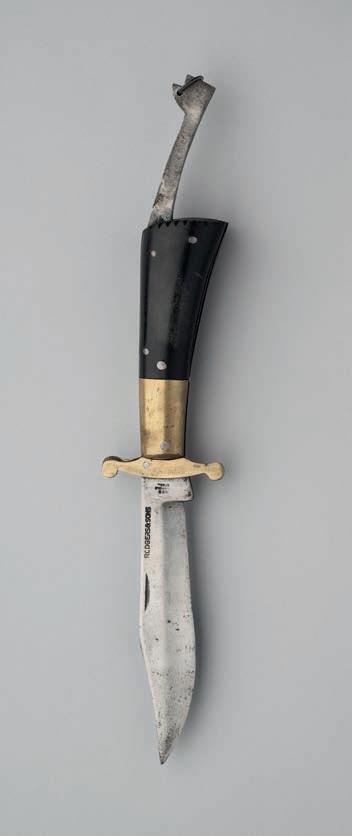

Literature
David Hayden-Wright, The Heritage of English Knives, Atglen, Pennsylvania, 2008, p. 316.
£200-300
517
AN INDIAN BOWIE KNIFE, LATE 19TH/20TH CENTURY
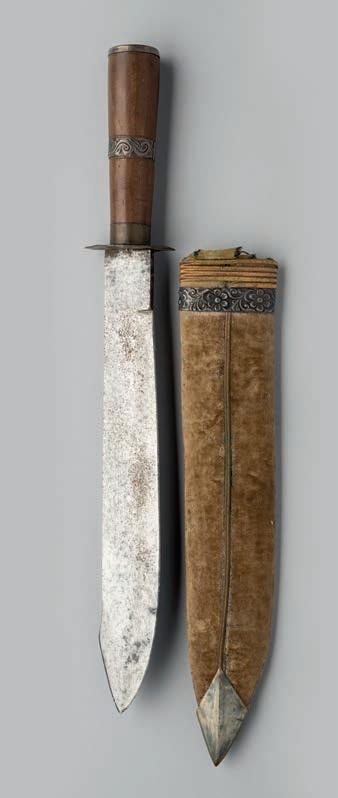
with single-edged blade swelling to a double-edged point, rectangular ricasso, lightweight guard, turned wooden grip with chased silver band in the centre and chased silver cap pommel, in its fabric-covered scabbard with chased silver locket and plain chape, 25.5 cm blade

Literature
David Hayden-Wright, The Heritage of English Knives, Atglen, Pennsylvania, 2008, p. 318.
£250-300
518
AN INDIAN COPY OF A FOLDING KNIFE, RODGERS, 20TH CENTURY with clip-point blade coarsely stamped with imitation maker’s details on the backedge and imitation marks at the forte, pivoting brass guard, and brass-mounted panels, 17.5 cm (closed)
Literature
David Hayden-Wright, The Heritage of English Knives, Atglen, Pennsylvania, 2008, pp. 51.
£80-120
516 517 518
7
A SWEDISH POCKET KNIFE, HEDENGRAN & SONS, LATE 19TH CENTURY with four small folding blades, two signed at the ricasso and one stamped ‘46’, etched blued and gilt iron body decorated with scrolling foliage, the owner’s name ‘M. A Layd’ on one face, the Swedish crowned Royal Arms on the other, and engraved ‘B. Beskow’ in small letters, in its padded leather case


Literature
David Hayden-Wright, The Heritage of English Knives, Atglen, Pennsylvania, 2008, p. 142.
Hedengran is first recorded in 1833 in Eskilstuna Sweden, becoming Hedengran & Sons 1870 -1916.

£300-400
520
A LARGE BELGIAN LOCK KNIFE, WAUTY, NAMUR, LATE 19TH CENTURY with folding blade formed with a curved clipped-back point and stamped by the maker at the ricasso, curved natural staghorn body incorporating a robust spring released by a ring on the back, and vacant German silver escutcheon, 22.2 cm blade
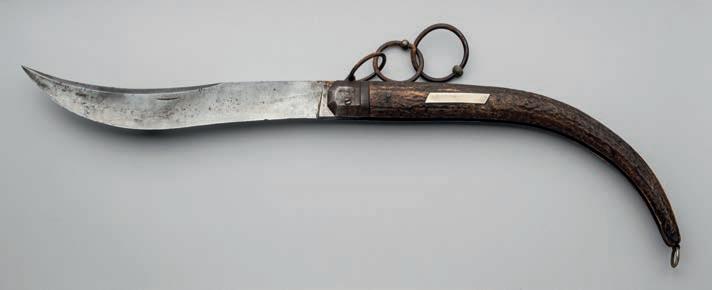
Literature
David Hayden-Wright, The Heritage of English Knives, Atglen, Pennsylvania, 2008, p. 134.
£300-400
521
A SPANISH DECORATED HUNTING DAGGER, TOLEDO, LATE 19TH CENTURY with etched tapering blade of hollowdiamond section, pierced with an elliptical aperture at the forte and inscribed ‘Fabrica de Toledo’, decorated over its surface with four differing hunting vignettes on each face within a strapwork frame on a ground of foliage, slightly recurved iron crosspiece, and natural staghorn grip, in its leather scabbard with decorated locket en suite with the blade (chape missing, light surface rust), 40.0 cm overall
Literature
David Hayden-Wright, The Heritage of English Knives, Atglen, Pennsylvania, 2008, p. 99.
£600-800
519
See page iii for Buyer’s Premium and other charges
521
520
519
8
A LARGE CONTINENTAL MULTI-BLADE PENKNIFE OF EXHBITION TYPE, 20TH CENTURY with over one hundred and thirty folding blades and accessories including awls, borers, saws, corkscrews, tweezers, scissors, comb, fork, magnifying glass, scribes, bodkins, and bradawls, and fitted at each side with a harlequin design scale in contrasting mother-of-pearl and shell, 13.0 cm (closed)
Literature
David Hayden-Wright, The Heritage of English Knives, Atglen, Pennsylvania, 2008, p. 76 £1,500-2,500

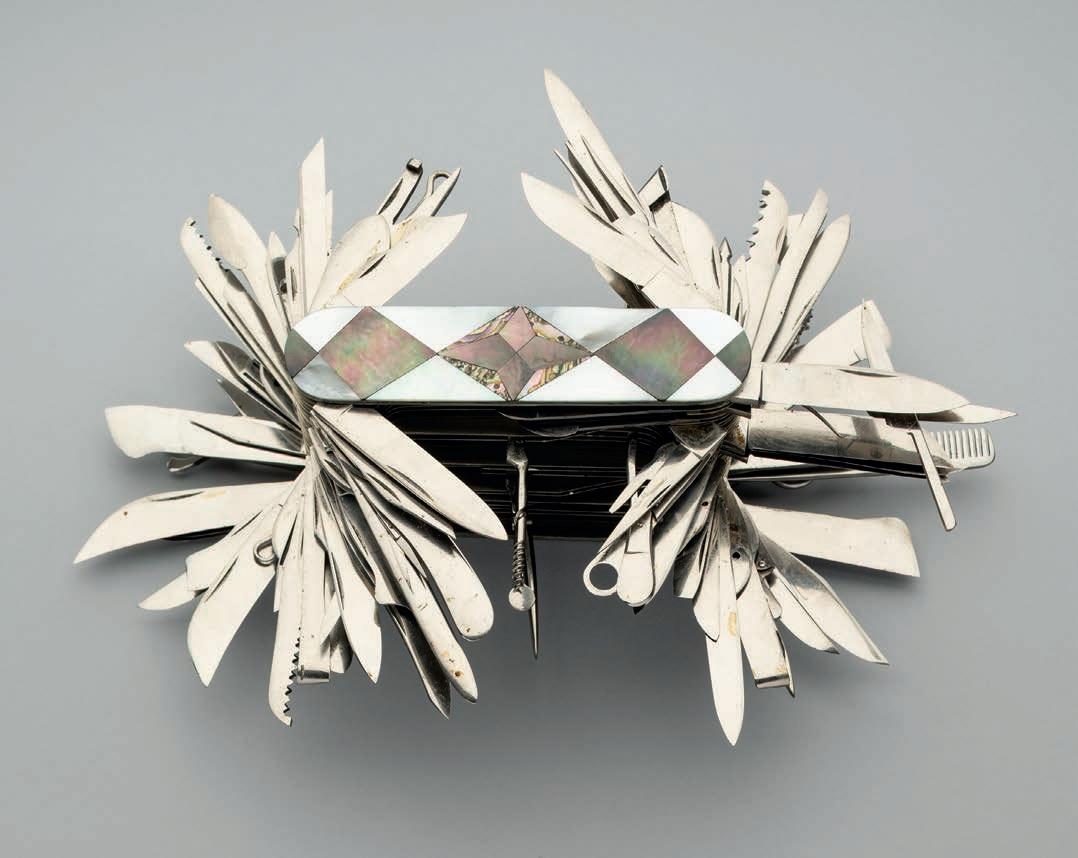
522 522
9
523
AN AMERICAN KORN’S PATENT LOCK KNIFE, CIRCA 1880 with sprung folding locking single-edged blade signed at the ricasso, German silver guard cast with addorsed griffin heads in low relief, one acting as the blade release, and vulcanite grips decorated with foliage and griffins, 14.5 cm (closed)
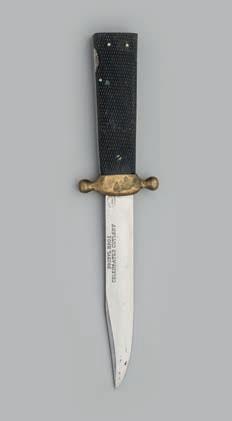
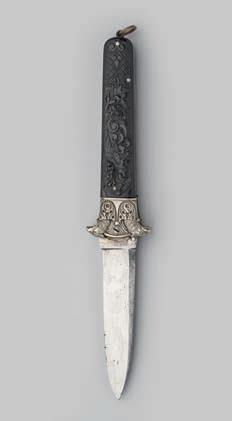
Literature
David Hayden-Wright, The Heritage of English Knives, Atglen, Pennsylvania, 2008, p. 240.
£350-450
~ 524
AN AMERICAN SKINNING KNIFE, ONTARIO KNIFE CO., USA, EARLY 20TH CENTURY, AND SIX FURTHER SKINNING TRADE KNIVES, 20TH CENTURY
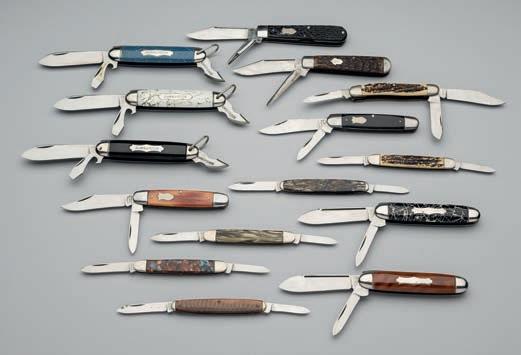
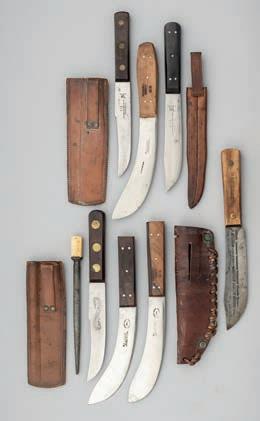
the first with signed blade and hardwood grip stamped ‘Old Hickory’, in its leather scabbard; the second inscribed ‘Bushman’s friend’ in a scroll on the blade, with ivory-mounted steel, in its leather scabbard; the third stamped ‘Lockwood Brothers’ and ‘Pampa’ on the blade, in its leather scabbard stamped en suite; the fourth by the same, in its leather scabbard; three further knives, similar, by I. Wilson, ex Syracuse St., Sheffield, with wooden grips impressed ‘Hudsons Bay Company 1870’, the first: 15.7 cm blade (7)
Literature
David Hayden-Wright, The Heritage of English Knives, Atglen, Pennsylvania, 2008, pp. 245-246.

£350-450
525
A RARE EXTENDING FIGHTING KNIFE, PRIBYL BROTHERS, MID19TH CENTURY
with gravity locked blade stamped ‘Pribyl Bros Celebrated Cutlery’ on the back-edge in a single line and again in a semi-circle, copper alloy cross-piece, chequered scales and associated leather scabbard, 30.0 cm extended
Literature
David Hayden-Wright, The Heritage of English Knives, Atglen, Pennsylvania, 2008, p. 215.
£80-120
526
AN AMERICAN SAFETY AXE, W.L. MARBLE, GLADSTONE, MICHIGAN, EARLY 20TH CENTURY, with burnished wedge-shaped steel head and haft, the latter fitted at the centre with a folding sprung safety arm to enclose the axeblade when not in use, stamped with patent details including the date 1898, fitted at the base on each side with composition grips decorated with a hound in pursuit of a rabbit on one face and with the inscriptions ‘Marble’s Safety Pocket Axe’ and ‘MF’D by W. L. Marbles, Gladstone, Mich’ on the other, 29.0 cm
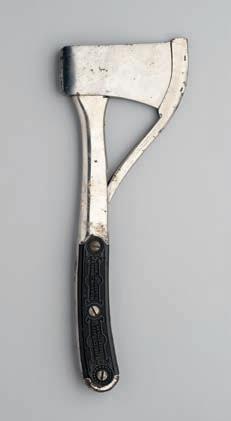
Literature
David Hayden-Wright, The Heritage of English Knives, Atglen, Pennsylvania, 2008, p. 63.
£150-200
527
TEN PENKNIVES, SYRACUSE KNIFE CO., NEW YORK, AND FIVE FURTHER AMERICAN PENKNIVES, 20TH CENTURY the first, second and third with signed main blade, two further folding accessories, stained scales and escutcheon inscribed ‘Scout Knife’; the fourth and fifth with two folding blades and stained scales with vacant escutcheons; the sixth to tenth smaller, with signed main blade and a further smaller folding blade; four penknives by Utica Cutlery Co., New York, and another, Remington, UMC, the first: 9.2 cm (closed) (15)
£150-200
523 524 525 526 See page iii for Buyer’s Premium and other charges 527 10
A RARE AMERICAN BOWIE KNIFE, DUFILHO, NEW ORLEANS, LAST QUARTER OF THE 19TH CENTURY
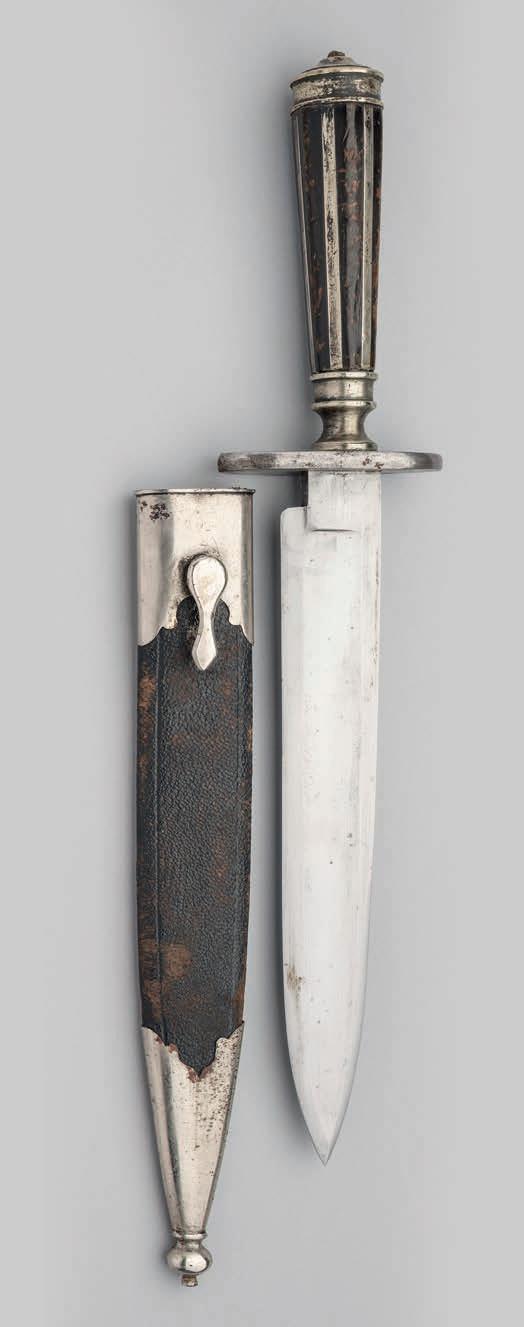
with tapering single-edged blade formed with a false swage and a near full-length broad fuller on each face, recessed rectangular ricasso, thick off-set oval steel guard, turned German silver ferrule and cap pommel, and tapering hardwood grip reinforced with six slender German silver bands, in its leather-covered wooden scabbard with steel mounts comprising chape with moulded terminal and locket with belt stud on the outer face, 22.5 cm blade Literature
David Hayden-Wright, The Heritage of English Knives, Atglen, Pennsylvania, 2008, p. 257.

Alfred H. Dufilho is recorded in Paris circa 1833-53 and New Orleans at 21 Royal Street between Customs House and Canal Streets circa 1853-1907. He worked in partnership with his brother making edged weapons for the Confederacy and surgical instruments. See Bezdek 1994, p. 408.
£1,500-2,000
528
528 11
529
AN IRISH BOWIE KNIFE, O’NEILL & THOMPSON, 7 HENRY STREET, DUBLIN, MID-19TH CENTURY

with straight single-edged blade formed with a clipped-back point, rectangular ricasso struck with the maker’s details, German silver guard, and spirally-fluted horn scales shaped for grip and retained by three rivets over German silver washers, in its leather scabbard with German silver locket and chape, each engraved with lines and the former with a leather loop on the back and the owner’s initials on the front, 22.5 cm blade
Literature
David Hayden-Wright, The Heritage of English Knives, Atglen, Pennsylvania, 2008, p. 279.
Thompson O’Neill & Company are recorded as razor and surgical instrument makers to Her Majesty and the Lord Lieutenant at Henry Street in the Dublin directory of 1862.
£800-1,000
530
A FOLDING DIRK FOR THE AMERICAN MARKET, SHEFFIELD, LATE 19TH CENTURY
with folding locking blade stamped ‘S*H Sheffield’ at the ricasso, German silver pivoting cross-piece, hardwood scales inlaid with mother-of-pearl, and German silver pommel with Federal eagle and shield, 11.0 cm, blade

Literature
David Hayden-Wright, The Heritage of English Knives, Atglen, Pennsylvania, 2008, p. 131.
£350-450
531
A FOLDING BOWIE KNIFE FOR THE AMERICAN MARKET, JOSEPH HOLMES, CIRCA 1870 with robust folding locking blade formed with a clipped-back point, signed ‘Jph Holmes Warranted Cutlery’ at the ricasso, German silver cross-piece (one quillon face missing), German silver pommel cast with foliage and a horse on each face, milled copper alloy fillets, mother-of-pearl scales and vacant German silver escutcheon, 15.3 cm (closed)

Literature
David Hayden-Wright, The Heritage of English Knives, Atglen, Pennsylvania, 2008, p. 240.
£500-700

529 530 531 See page iii for Buyer’s Premium and other charges 12
532
A FOLDING SAW-KNIFE FOR THE AMERICAN MARKET, SECOND HALF OF THE 19TH CENTURY

with long main serrated saw blade with filed back-edge and lifting notch, etched on one face with a bison pursued by four pairs of hounds and an American rifleman, stamped ‘Rough and Ready’ and ‘Sailor’s Companion’ at the forte and stamped ‘Warranted cast steel’ on the ricasso, pruning blade formed and stamped en suite, brass fillets, figured hardwood scales retained by twenty-six iron rivets and set with small German silver plaques including three respectively inscribed ‘W.E. Ward’, ‘Doncaster’ and ‘England’, and complete with its leather carrying case (strap detached), 31.2 cm (closed)
Literature
David Hayden-Wright, The Heritage of English Knives, Atglen, Pennsylvania, 2008, p. 90.
£1,000-1,500
532
~
A BOWIE KNIFE FOR THE AMERICAN MARKET, TILLOTSON & CO., COLUMBIA PLACE, SHEFFIELD; A BOWIE KNIFE, PROBABLY AMERICAN AND ANOTHER, LATE 19TH CENTURY
the first with robust single-edged blade formed with a spear point, stamped ‘The Hunter’s Companion’, and with Federal eagle on one face, recessed rectangular ricasso struck with the maker’s details, thin oval German silver guard, a pair of natural scales, probably narwhal, and vacant escutcheon, in its tooled and gilt leather scabbard; the second with broad blade formed with a clipped-back point and a slender fuller on each face, copper alloy guard, and natural staghorn grip; the third with tapering blade formed with a clipped-back point, German silver guard, natural staghorn grip, and German silver pommel cap, in its German silver scabbard, the first: 19.2 cm (3)
Literature
David Hayden-Wright, The Heritage of English Knives, Atglen, Pennsylvania, 2008, p. 267.


£350-400
534
A BOWIE KNIFE FOR THE AMERICAN MARKET IN MID-19TH CENTURY STYLE, 20TH CENTURY, INSCRIBED TILLOTSON, COLUMBIA PLACE, SHEFFIELD
with single-edged blade with clipped-back point, etched with scrolling foliage and a scroll inscribed ‘Gold Hunter’s Knife’, rectangular ricasso stamped with the maker’s details, German silver guard and pommel, the latter embossed with a reclining lion, and mother-of-pearl scales retained by four rivets, 27.0 cm blade

Literature
David Hayden-Wright, The Heritage of English Knives, Atglen, Pennsylvania, 2008, p. 278.
533
£300-500 533 534 13
535
AN EXCEPTIONAL FOLDING KNIFE DISPLAY FOR EXHIBITION OR SHOWROOM USE, CIRCA 1875-85 with German silver-mounted iron body encased in mother-of-pearl over dark horn plaques, all divided by brass fillets and retained by rivets over brass foliate washers, comprising a large central scalloped boss engraved on each face with elaborate scrolls of foliage enclosing a central flowerhead, with eight equally spaced projections around its circumference with ram’s horn terminal, fitted in each case with a knife formed of a pair of addorsed scrolls, with fourteen folding blades at the outer terminal and the inner with a short stout chisel-head locking into the main body (small chips, minor cracks and losses), 37.0 cm diameter, (opened)

Literature
David Hayden-Wright, The Heritage of English Knives, Atglen, Pennsylvania, 2008, p. 75 £2,000-3,000

See page iii for Buyer’s Premium and other charges 14
535
AN EXCEPTIONAL FOLDING LOCK KNIFE FOR EXHBITION, THIRD QUARTER OF THE 19TH CENTURY, PROBABLY LONDON
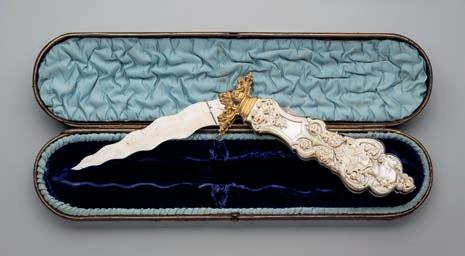
with burnished folding wavy-edged blade of flatteneddiamond section, locked by a shaped burnished spring-catch, gilt-brass cross-piece cast with scrolling foliage and incorporating a pair of acanthus langets, gilt fillets fitted on each face with mother-of-pearl plaques (very small losses), those on the inner face polished flat and those on the outer finely carved with a symmetrical arrangement of delicate scrolling foliage, a stylised display stand charged with the arms of the Worshipful Company of Cutlers surmounted by its crest, an elephant’s head erased, in its original leather-covered case with blue velvet and silk padded lining, 46.2 cm long, (overall)
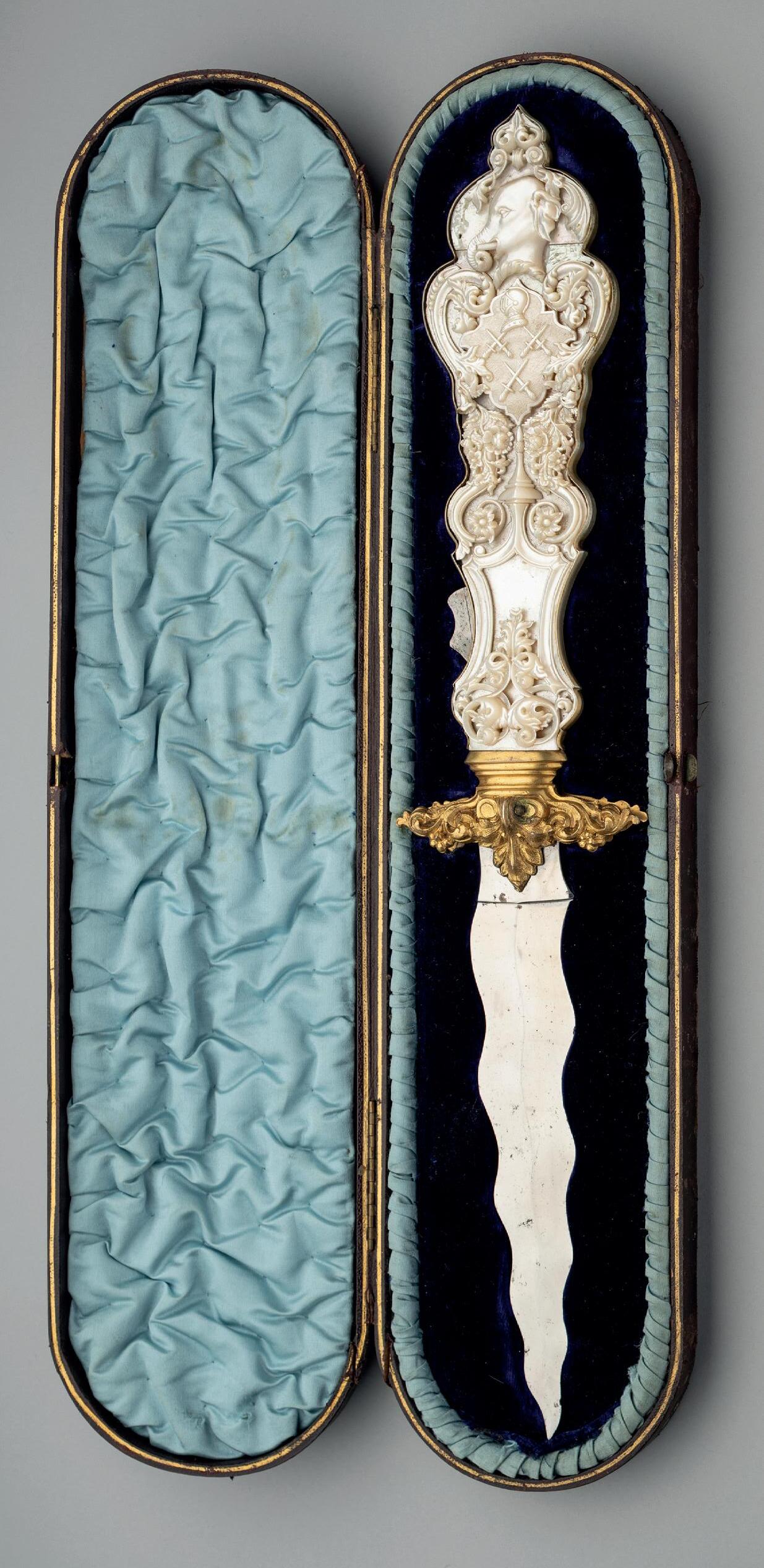
Literature
David Hayden-Wright, The Heritage of English Knives, Atglen, Pennsylvania, 2008, p. 93.

The London Worshipful Company of Cutlers were granted their arms on 17 May 1476 with an alternative crest of an elephant and castle granted in 1622. The Company of Cutlers in Hallamshire received their incorporation in 1624 with the same arms as the London Company but with an augmentation of the fess. The latter company had much of the cutlery trade by the middle of the 18th century though there remained cutlers in London throughout the 19th century. In 1879 there were thirty cutlers recorded working in the city of London and the company held an Exhibition in its Hall, awarding medals for various classes of work. It is likely that the present dagger was submitted for such an exhibition.
£8,000-12,000
536
15
537
A RARE CONTINENTAL MULTI-BLADE KNIFE FOR EXHIBITION, EARLY 20TH CENTURY
with over ninety folding blades and accessories, including main blade stamped ‘FOREIGN’, saws, picks, scissors and corkscrew, fitted at each side with horn scales each retained by five minute screws, and with sliding tweezers and picks top and bottom, 12.0 cm (closed)

Literature
David Hayden-Wright, The Heritage of English Knives, Atglen, Pennsylvania, 2008, p. 80.
£600-800
538
A FINE MOTHER-OF-PEARL MOUNTED PENKNIFE FOR DISPLAY, LATE 19TH/EARLY 20TH CENTURY


with twelve folding blades at each end of differing form, including saws, files, scalpel and spike-tipped, two stamped ‘Sheffield made’, white metal fillets, mother-of-pearl scales, and vacant escutcheon, 8.7 cm (closed)
Literature
David Hayden-Wright, The Heritage of English Knives, Atglen, Pennsylvania, 2008, p. 115.
£300-400
See page iii for Buyer’s Premium and other charges 16
537 538
A MULTI-BLADE PENKNIFE FOR EXHIBITION
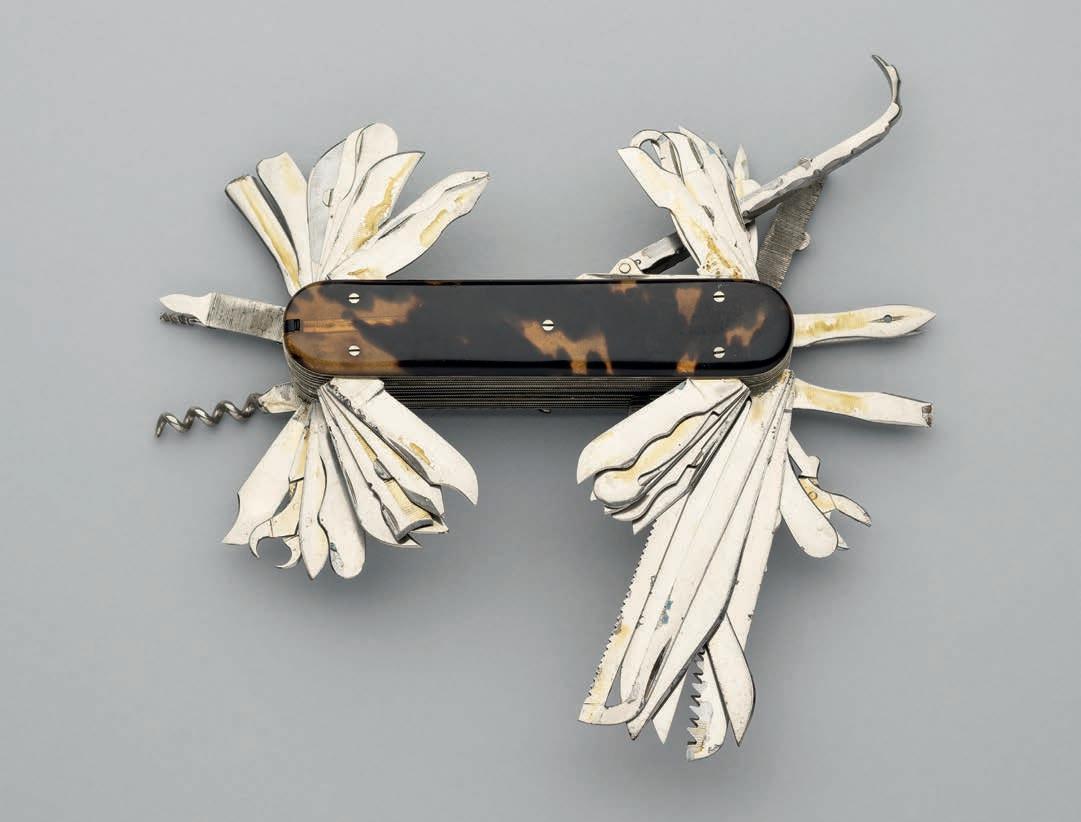
with over one hundred folding blades and accessories including awls, borers, saw, scribes and bodkins, the main blade marked with a pair of crossed spurs at the base, fitted at each side with tortoise shell scales each retained by five minute German silver screws, and fitted with horn pick and German silver tweezers,12.0 cm (closed)
Literature
David Hayden-Wright, The Heritage of English Knives, Atglen, Pennsylvania, 2008, p. 73 £1,400-1,800

539 539
17
540
A FOLDING KNIFE, CIRCA 1860-80 comprising two blades, the larger stamped ‘Hich’ at the ricasso, German silver fillets, filed springs, ebonised scales inlaid with polychrome flowers, and German silver terminals, 16.0 cm (closed)

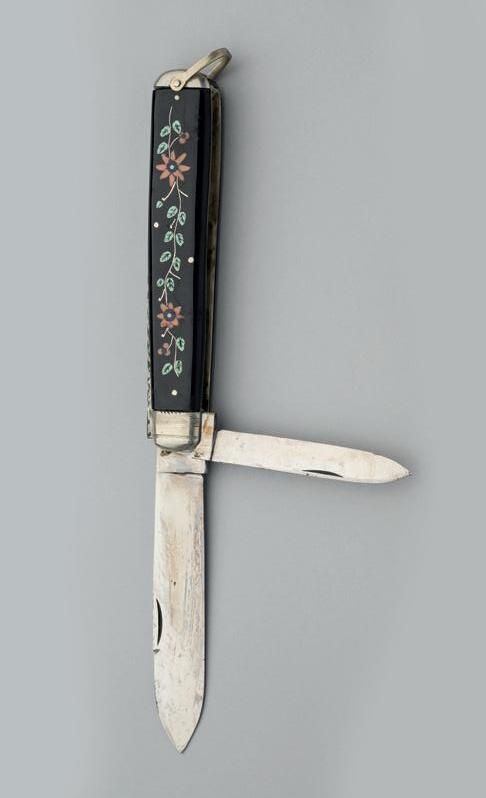
Literature
David Hayden-Wright, The Heritage of English Knives, Atglen, Pennsylvania, 2008, p. 89.
£200-300
541
A HUNTING LOCK KNIFE AND A COMBINED KNIFE AND FORK SET, SECOND HALF OF THE 19TH CENTURY the first with long slender folding locking blade, corkscrew and ‘deer’s foot’ grip with German silver shoe; the second comprising folding knife and fork, iron fillets divided laterally and joined by a pair of studs and keyholes, staghorn grips, in its leather holster, the first: 19.0 cm closed (2)
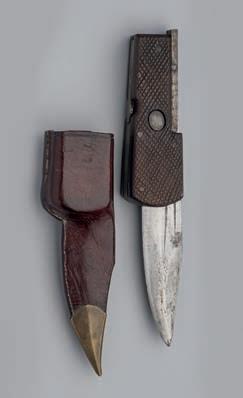

Literature
David Hayden-Wright, The Heritage of English Knives, Atglen, Pennsylvania, 2008, p. 137-138.
£200-300
542
A MILITARY STYLE FOLDING LOCK KNIFE, EARLY 20TH CENTURY probably trench made, with folding locking blade formed with a clipped-back point, a pair of folding double quillons, chequered scales with blade release stud, in its leather scabbard with brass chape, 18.5 cm blade
Literature
David Hayden-Wright, The Heritage of English Knives, Atglen, Pennsylvania, 2008, p. 219.
£200-300
543
A FOLDING LOCK KNIFE, LATE 19TH/20TH CENTURY military style, with folding locking blade formed with a clippedback point, chequered scales with iron release catch, vacant German silver escutcheon, in its leather scabbard with belt loop, 20.0 cm blade

Literature
David Hayden-Wright, The Heritage of English Knives, Atglen, Pennsylvania, 2008, p. 221.
£200-250
544
FIVE KEY KNIVES AND A THREE EATING UTENSILS, 20TH CENTURY
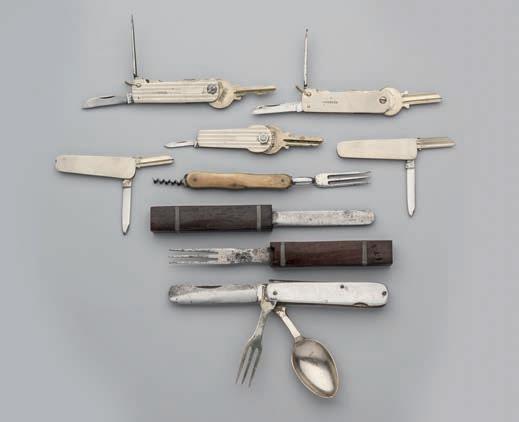
the first two with folding Yale keys, blades and German silver bodies marked ‘RD855048’; the third, fourth and fifth similar, smaller; the sixth a folding fork and corkscrew, with polished horn scales; the seventh a folding spoon, fork and knife, J.W. Cowlishaw, Sheffield; the eighth a splitting knife and fork, with hardwood handles, one marked ‘W. H. Wragg patentee’ and the other ‘Emigrant Knife’ (pitted), the first: 7.2 cm (closed) (8)
Literature
David Hayden-Wright, The Heritage of English Knives, Atglen, Pennsylvania, 2008, p. 174.
£100-150
540 541 542 543 See page iii for Buyer’s Premium and other charges 544 18
545
A HEAVY BOWIE KNIFE, LATE 19TH CENTURY
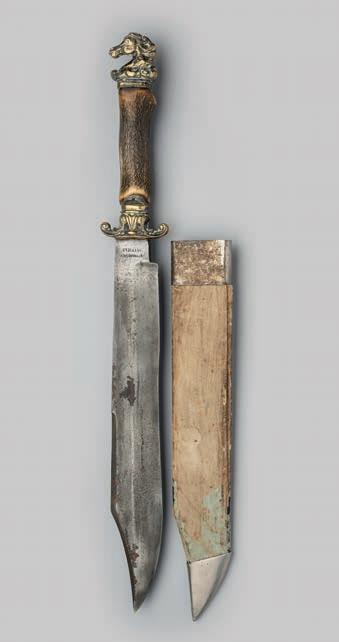

with broad double-edged blade formed with a spear point and a full-length central fuller on each face, large thick russet iron guard, and a pair of natural staghorn scales, in its leather-covered wooden scabbard with large German silver mounts, complete with suspension frog, 24.7 cm blade

Literature
David Hayden-Wright, The Heritage of English Knives, Atglen, Pennsylvania, 2008, p. 294.
£800-1,200
546
A BOWIE KNIFE, UNSIGNED, LAST QUARTER OF THE 19TH CENTURY with tapering single-edged blade, rectangular ricasso, shaped German silver guard with scalloped edge and integral ferrule, vulcanite grips retained by three rivets and decorated with Griffins and scrolling foliage, in its leather-covered wooden scabbard with German locket with decorated belt stud and chape with bulbous terminal, 26.3 cm blade
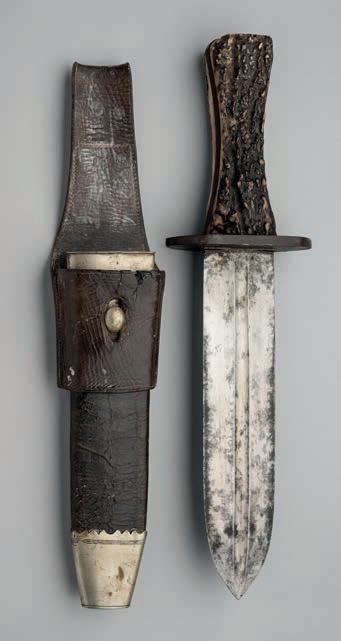
Literature
David Hayden-Wright, The Heritage of English Knives, Atglen, Pennsylvania, 2008, p. 259.
£400-600
547
A BOWIE KNIFE, 20TH CENTURY with broad blade formed with a clippedback point and stamped ’Fenton & Shore’ at the ricasso, cast copper alloy hilt comprising guard with scrolling quillons and horsehead pommel, horn grip, in its scabbard, 35.0 cm blade
Literature
David Hayden-Wright, The Heritage of English Knives, Atglen, Pennsylvania, 2008, p. 302.
£400-600
19
545 546 547
548
A BOWIE KNIFE, LATE 19TH CENTURY with single-edged blade formed with a pronounced clipped-back point, etched with a Federal eagle and inscriptions on one face including ‘America The Land of Freedom’ and ‘The Patriot’s Self Defender’, recessed ricasso stamped ‘Best Quality Rough & Ready’ German silver guard, ferrule and pommel, the latter chased with flowers, and rosewood grip, in its tooled leather scabbard, 19.8 cm blade
£450-550
549
A BOWIE KNIFE IN MID-19TH CENTURY STYLE, 20TH CENTURY with robust blade formed with a pronounced clipped-back point, iron hilt comprising strongly curved tapering quillons, hardwood grip with a scalloped collar at the base, cap pommel and hardwood grip, in its leather scabbard with belt loop, 32.3 cm blade
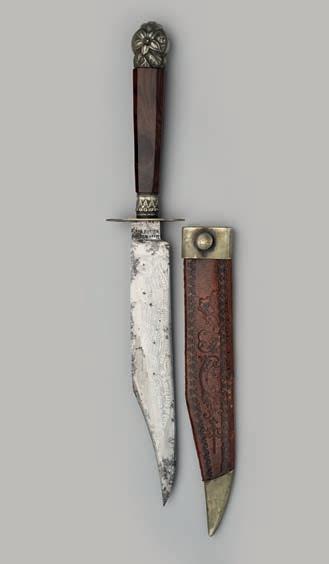
Literature
David Hayden-Wright, The Heritage of English Knives, Atglen, Pennsylvania, 2008, p. 256.

£200-300
550
AN ‘ARKANSAS TOOTHPICK’ KNIFE, 20TH CENTURY with tapering double-edged blade etched with scrolling foliage and a scroll inscribed The Patriot’s Self Defender’, rectangular ricasso stamped ‘W.A.Woolley, Sheffield’ and with tiger bust and arrow mark on the reverse, German silver guard and horn scales, in tooled and gilt leather scabbard, 25.2 cm blade
Literature
David Hayden-Wright, The Heritage of English Knives, Atglen, Pennsylvania, 2008, p. 297.
£200-300
551
A CASED BOWIE KNIFE, SECOND HALF OF THE 20TH CENTURY with broad blade formed with a clipped-back point, stamped ‘Broomhead & Thomas Celebrated American Hunting Knife’ at the ricasso, German silver hit, mother-of-pearl scales, in its engraved German silver scabbard decorated with flowers, foliage and the initials ‘JB’, in a lined and fitted case, 23.8 cm blade



Literature
David Hayden-Wright, The Heritage of English Knives, Atglen, Pennsylvania, 2008, p. 304.
£400-500
548
549
See page iii for Buyer’s Premium and other charges 551 20
550
A FORESTER’S FOLDING SAW, MID-19TH CENTURY with large unmarked folding blade formed with a serrated edge, iron body and bolster, and four natural staghorn scales, 32.3 cm (closed)

Literature
David Hayden-Wright, The Heritage of English Knives, Atglen, Pennsylvania, 2008, p. 63.
£300-500
553
A RARE LARGE FOLDING KNIFE FOR A WINDOW DISPLAY, I. WILSON, SECOND QUARTER OF THE 19TH CENTURY with broad folding blade struck with the maker’s mark, four peppercorns and a diamond (pitting), file-hatched spring, and shaped body faced with three pairs of polished horn scales retained by iron rivets, 53.2 cm (closed)
Literature
David Hayden-Wright, The Heritage of English Knives, Atglen, Pennsylvania, 2008, p. 78.

Probably by John Wilson (1772-1849), or his son of the same name, whose family was granted the ‘four peppercorns and a diamond’ mark in 1766. Wilson worked as a knife maker and steel manufacturer in Sycamore Street. His plain and utilitarian blades were highly regarded in America as recorded by one writer: ‘Though it lacks the romance and glory associated with frontier Bowies, dirks and push daggers, the I. Wilson butcher knife made a major contribution to the settling of this country’. When he died in 1849, aged 77, the Sheffield Independent records noted he ‘left behind him a name around which the most pleasing fragrance had long been gathering…..’. His sons continued the business and built on his success, winning a Prize Medal at the Great Exhibition of 1851. Abbreviated from Tweedale 2019 and Hawley 2023.

£500-800
554
A MINIATURE TENON SAW, THREE MOTHER-OF-PEARL MOUNTED MINIATURE KNIVES AND NINE MINIATURE POCKET KNIVES CONTAINED WITHIN A HAZELNUT
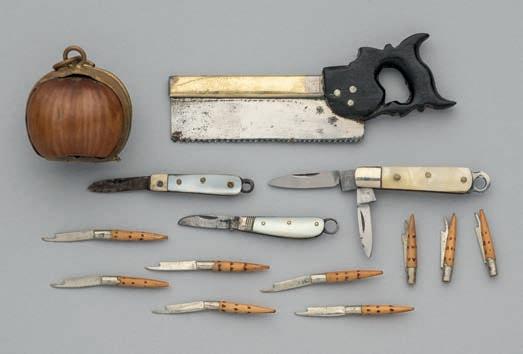
the first with blackened hardwood handle; the second with two folding blades, the third and fourth each with a single folding blade, the fifth comprising nine very small knives, each with folding blade with bottle-opener terminal, tapering cylindrical body, all contained in a hazelnut joined by a copper alloy hinged mount, the first: 6.3 cm overall (14)
Literature
David Hayden-Wright, The Heritage of English Knives, Atglen, Pennsylvania, 2008, p. 85.
£150-200
555
A SMALL AXE, LATE 19TH/EARLY 20TH CENTURY with curved axe-blade and tapering rear pan with square face, on its wooden haft (perhaps an early association), formed in two stages divided by a turned moulding, fluted grip, fitted at the base with iron cap with globular finial and a stirrup loop, complete with its leather cover with belt loop (strap incomplete), 42.5 cm

Literature
David Hayden-Wright, The Heritage of English Knives, Atglen, Pennsylvania, 2008, p. 62.
£150-200
555 553
552
554
21
552
556
556
A BRASS SCARIFICATOR, LATE 18TH CENTURY of bevelled box form, with sixteen lancets operated by a trigger-shaped lever, circular button release and depth adjuster, the body finely engraved with rococo scrolls and flowers on a punched ground, a trellis design on the bevels, and some early blued finish, 5.0 x 4.7 cm across, face

Literature
David Hayden-Wright, The Heritage of English Knives, Atglen, Pennsylvania, 2008, p. 165
£500-700
557
A BRASS SCARIFICATOR, LATE 19TH CENTURY
of bevelled box form, with twelve lancets operated by a trigger-shaped lever, circular button release and depth adjuster, 5.0 x 4.5 cm across, face
Literature
David Hayden-Wright, The Heritage of English Knives, Atglen, Pennsylvania, 2008, p. 165
£300-400
558
A BRASS SCARIFICATOR, LATE 19TH CENTURY of bevelled box form, with six lancets operated by a trigger-shaped lever, circular button release and depth adjuster, 3.7 x 3.5 cm across, face

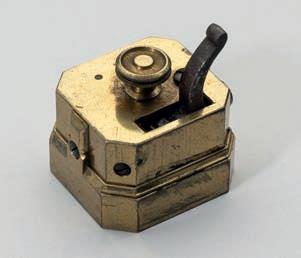
£200-300
~ 559
A SILVER CASED SET OF LANCETS, LONDON 1796 AND A NAVAL SURGEON’S KIT, LATE 19TH CENTURY

the first comprising three lancets with tortoiseshell scales, in a decorated silver case with the owner’s crest on the lid; and a further similar lancet; the second formed of a leather wallet with various implements including scissors, tweezers, fleams and scalpels, the first: 6.2 cm (2)
Literature
David Hayden-Wright, The Heritage of English Knives, Atglen, Pennsylvania, 2008, pp. 166, 167. The second was, by tradition, carried by the senior surgeon on the H.N.S. Hercules.
£200-250

See page iii for Buyer’s Premium and other charges
558 559 22
557
560
AN 8MM PERCUSSION APACHE PISTOL ‘THE SURE DEFENDER’, NO.173, LATE 19TH CENTURY with German silver sighted barrel engraved ‘The Sure Defender’ on top, fitted on the left with blued steel bayonet and beneath with sprung hammer and folding trigger (action incomplete), and hinged knuckle-duster grip, 10.5 cm overall (closed)

Literature
David Hayden-Wright, The Heritage of English Knives, Atglen, Pennsylvania, 2008, p. 106.
£500-700
561
A SMALL DIRK, LATE 19TH CENTURY with straight double-edged blade of flatteneddiamond section, German silver cross-piece and ferrule, and red gutta-percha grip carved with a peacock oval medallion and inlaid with an engraved German silver bird and flowerhead, in its German silver mounted scabbard (chape missing), 15.0 cm blade

Literature
David Hayden-Wright, The Heritage of English Knives, Atglen, Pennsylvania, 2008, p. 107.
£200-300
~ 562
THREE PAIRS OF MOTHER-OF-PEARL MOUNTED SCISSORS, A LANCE AND A FOLDING KNIFE, LATE 19TH CENTURY the first with folding blades of triangular section, a pair of short stout ‘quillons’ at the base, mother-of-pearl mounted stem and oval grips; the second and third with mother-of-pearl mounted grips mounted together in a Germansilver mounted scabbard; the fourth with German silver grip and cover; and the fifth with silverplated locking blade retaining traces of an inscription including ’Colmore Patent’, and tortoiseshell scales, the first: 15.0 cm overall (5)

Literature
David Hayden-Wright, The Heritage of English Knives, Atglen, Pennsylvania, 2008, pp. 165.
£250-350

560 561 562
23
563
A SMALL AXE, GIBBS, LATE 19TH/EARLY 20TH CENTURY, with curved axe-blade formed with a sharp leading edge and struck with the maker’s name on one face, moulded rear pean with the letter ‘V’ for branding, iron haft with moulded neck, fitted with four shaped horn panels (perhaps replaced in its working life), complete with its leather cover with belt loop, 35.5 cm


£200-250
564
A SMALL AXE, NORRIS, WINDSOR, EARLY 20TH CENTURY with curved axe-blade formed with a sharp leading edge, struck with the maker’s details and ‘GR’ crowned (rubbed) moulded rear pean with chequered face, iron haft with moulded neck and basal terminal, incorporating a long signed folding saw-blade, and grips formed of four staghorn panels divided by a moulded iron collar, 33.5 cm
Literature
David Hayden-Wright, The Heritage of English Knives, Atglen, Pennsylvania, 2008, p. 61.
£250-300
565
A SMALL LOCK KNIFE, HAMON, EARLY 19TH CENTURY with five folding elements including locking blade stamped with the maker’s name, three small blades, and corkscrew, copper alloy fillets, German silver pommel, and contrasting mother-ofpearl (cracked) and tortoiseshell scales, 11.8 cm (closed)

Literature
David Hayden-Wright, The Heritage of English Knives, Atglen, Pennsylvania, 2008, p. 241.
£300-400
566
A GAME KEEPER’S WHISTLE WITH CARTRIDGE EXTRACTOR AND CONCEALED DISPATCHER, EARLY 20TH CENTURY with nickel-plated body (some rust spots) stamped ‘patent’ and ‘16’ [calibre] on top, the knife centred and concealed within the base and with a ring for suspension, 8.4 cm
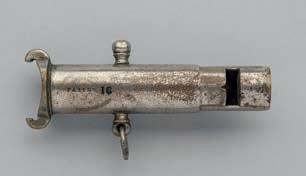
Literature
563 564 See page iii for Buyer’s Premium and other charges 566 24
David Hayden-Wright, The Heritage of English Knives, Atglen, Pennsylvania, 2008, p. 149.

£200-300 565
567
A FOLDING LOCK KNIFE, J. LAWSON, GLASGOW, LATE 19TH CENTURY military style, with folding locking blade stamped with the maker’s details and ‘select’ on the respective faces at the ricasso, formed with a clipped-back point, slightly recurved German silver double quillons, an iron lever for blade closure, natural staghorn scales, German silver blade release stud, in its leather scabbard (belt loop missing), 21.8 cm blade



Literature
David Hayden-Wright, The Heritage of English Knives, Atglen, Pennsylvania, 2008, p. 221.

£300-400
568
A MILITARY FOLDING LOCK KNIFE, R. MCQUEEN & SON, NEWCASTLE, CIRCA 1880-90 with folding locking blade stamped with the maker’s details at the ricasso, formed with a clipped-back point, a pair of folding German silver double quillons, brass fillets, chequered scales, German silver blade release stud, in its leather scabbard with iron chape, belt loop and cover, 23.8 cm blade
Literature
David Hayden-Wright, The Heritage of English Knives, Atglen, Pennsylvania, 2008, p. 220.
£200-300
569
A BOWIE KNIFE, BAGSHAW & SON, 87 CHURCH STREET, LIVERPOOL with single-edged blade formed with a clipped-back point, signed rectangular ricasso, oval steel guard, chequered scales retained by five rivets, in its leather scabbard with belt loop, 20.0 cm blade
Literature
David Hayden-Wright, The Heritage of English Knives, Atglen, Pennsylvania, 2008, p. 285.
£250-300
567 568 569 25
~
FOUR DECORATED ENGLISH POCKET KNIVES, LATE 19TH/EARLY 20TH CENTURY

the first with locking blade inscribed ‘A Sharp Companion’ in blued letters in a reserved panel on further blue, and German silver body inset with tortoiseshell, in its case inscribed ‘G. Kenning & Son, London’ on the lid; the second with two locking blades and silvered body decorated with figures; the third with two small blades and tortoiseshell scales and the fourth a pick, with two gilt folding blades and mother-ofpearl body in its case, the first: 11.3 cm (closed) (4)
Literature
David Hayden-Wright, The Heritage of English Knives, Atglen, Pennsylvania, 2008, p. 170.
£250-350
571
A PEGLEY-DAVIES ANGLER’S KNIFE, AND THREE FURTHER ANGLER’S KNIVES, EARLY 20TH CENTURY the first with four folding elements including disgorging blade, and scissors, nickel-silver body engraved with fly nos. 8 to 16 on one face and a ruler on the other; the second Lockwood brothers, with four folding elements including scissors, pick and disgorging blade, nickel silver body with ruler and flies; the third marked ‘London’ and the fourth complete with its pouch, the first: 9.3 cm (4)

Literature
David Hayden-Wright, The Heritage of English Knives, Atglen, Pennsylvania, 2008, p. 148.

£250-300
A QUEEN VICTORIA DIAMOND JUBILEE PENKNIFE; TWO GEORGE V AND QUEEN MARY CORONATION PENKNIVES; AND APPROXIMATELY SIXTY FOUR SMALL NOVELTY AND TOURIST PENKNIVES, 20TH CENTURY

the first with two folding blades, motherof-pearl scales with jubilee inscription, in its chamois case; the second and third with portrait medallions cast in low relief on the scales; the fourth with four folding elements, inscribed ‘Explosives Kyncoh’ on one scale; the fifth a folding pencil and penknife, Joseph Rodgers & Sons, formed as a musket; the sixth inscribed New England Newspapers Supply Co., Worcester Massachusetts’; the seventh inscribed Mitchells & Butlers Ltd Brewery, Cape Hill Birmingham, and approximately sixty further small penknives, the first: 8.2 cm closed (67)
£400-600
570
572
See page iii for Buyer’s Premium and other charges 572 26
570 571
BROOKES & CROOKES
Brookes & Crookes was established in 1858 by two Nonconformists, John Brookes (1825-1865) and Thomas Crookes (1826-1912). In their founding year the partners entertained their employees with a day of cricket and toasting, where Brookes underlined their intention to produce first-class goods and Crookes promised fair remuneration for labour. Though common sentiments at the time, Brookes and Crookes were already known for paying bonuses for new designs. Sadly, the partnership was short-lived as Brookes died from apoplexy at West Riding Pauper Lunatic Asylum, near Wakefield, on 14 February 1865 aged only 39 years. Crookes took over the business helped by his works manager William Westby who moved with his family to the factory at Atlantic Works in 1861. The ‘Bell’ trade mark became a badge of excellence and they were famed for the variety of their sportsman’s and multi-blade knives.

573
A MOTORING KNIFE, BROOKES & CROOKES, SHEFFIELD, EARLY 20TH CENTURY plated with nickel silver throughout, with four folding accessories comprising main blade stamped with the maker’s details and bell device, scissors, corkscrew and pick, robust body with hexagonal spanner head at one end and triple-head spanner at the other, concealed pick, stamped with bell mark and ‘patent’ on one face and with match box with striking panel and hinged cover on the other, In its blue-lined fitted case, 13.7 cm (closed)

Literature David Hayden-Wright, The Heritage of English Knives, Atglen, Pennsylvania, 2008, p. 142.
£800-1,000

573
27
~ 574
AN EXCEPTIONAL HUNTING DAGGER OF PRESENTATION QUALITY, BROOKES & CROOKES, SHEFFIELD, WITH SILVERMOUNTED SCABBARD, H. W. & L. DEE, LONDON 1877 with heavy polished blade formed with a slender fuller on each face and with knurled back-edge, etched on one face with a frosted panel filled with a hunting scene involving three elephants with howdahs, scrolling foliage, and the maker’s details with bell symbol within an oval, rectangular ricasso, shaped thick silverplated iron cross-guard with knurled border en suite with the blade, silver-plated tang (silver with small losses), brass fillets, and a pair of ivory grip-scales retained by five rivets, each carved with finely detailed Prince of Wales’ feathers issuant from a crown at the pommel, in its original wooden scabbard encased in tooled leather decorated with large panels of trellis (small losses and minor damage), with engraved silver locket and chape, each engraved with a symmetrical design of scrolling flowers and foliage, and the locket complete with a ring for suspension, 33.0 cm blade
Literature
David Hayden-Wright, The Heritage of English Knives, Atglen, Pennsylvania, 2008, p. 98.

The present knife was probably made as an exhibition piece with a view to winning Royal commissions, subsequent to the Prince of Wales’s tour of India in 1875-6.

A UK Ivory Act 2018 certificate for this lot will be made available to the purchaser
£10,000-15,000
574
See page iii for Buyer’s Premium and other charges 28


574 29
575
A FINE SPORTSMAN’S KNIFE, SHEFFIELD, LATE 19TH CENTURY with eighteen folding elements including main blade stamped with a bell style logo, probably for Brookes & Crookes, and ‘Sheffield’ at the ricasso, saw, paring blades, scissors, button hook, awl and corkscrew, concealed tweezers and pick, German silver fillets, natural stag horn scales, vacant German silver escutcheon, and German silver loop, 11.5 cm (closed)

Literature
David Hayden-Wright, The Heritage of English Knives, Atglen, Pennsylvania, 2008, p. 147. £500-600

See page iii for Buyer’s Premium and other charges
575
30
576
A COACHMAN’S KNIFE, BROOKES & CROOKES, SHEFFIELD, EARLY 20TH CENTURY, AND ANOTHER, W. MORTON & SONS, SHEFFIELD
the first with seven folding elements including signed blade with bell mark, farrier’s hook, borer, and corkscrew, copper alloy fillets, nickel silver body and loop; the second with eight folding elements including signed folding blade, farriers hook, bottle opener, scoop borer, cork screw and button hook, nickel silver body and loop, the first: 12.0 cm (closed) (2)

Literature
David Hayden-Wright, The Heritage of English Knives, Atglen, Pennsylvania, 2008, p. 155.
£350-450

576
31
577
A BOWIE KNIFE, JONATHAN CROOKES, EARLY 20TH CENTURY with broad blade formed with a clippedback point, rectangular ricasso struck with the maker’s name and heart and pistol mark, (areas of light pitting), recurved German silver guard, natural staghorn scales retained by six rivets, in its leather scabbard with belt loop, 24.7 cm blade

Literature
David Hayden-Wright, The Heritage of English Knives, Atglen, Pennsylvania, 2008, p. 268.
Jonathan Crookes (1778-1866) worked for Joseph Rodgers & Sons and was apparently involved with the production of Rodgers’ famous Year Knife, credited in a directory advertisement of 1884 as, ‘Inventor and Sole Maker of that Unique and Superb Specimen of Cutlery, containing Eighteen Hundred and Twentyone Blades, with Different Instruments, value 200 guineas’. He is recorded as a manufacturer of pen knives in Rockingham Lane in 1828 and by 1839, Jonathan Crookes & Son had moved to Eldon Street, close to Wostenholm’s Washington Works, where it remained until the end of the nineteenth century. After Jonathan’s death, his son Henry continued the business and maintained his father’s emphasis on quality and limited output. In 1896, Henry’s widow died and the mark was acquired by Joseph Allen, at Ecclesall Works, 245 Rockingham Street. Crookes continued to be advertised as a stand-alone name at that address. Abbreviated from Tweedale 2019 and Hawley 2023.
£300-400
578
A SMALL BOWIE KNIFE, JONATHAN CROOKES, SHEFFIELD, LATE 19TH CENTURY

with broad blade formed with a clippedback point, recessed rectangular ricasso struck with the maker’s name and heart and pistol mark, German silver hilt comprising recurved guard, ferrule and pommel each decorated with scrolling foliage in low relief, and mother-of-pearl grip, in its German silver mounted leather scabbard with belt loop,14.5 cm blade
Literature
David Hayden-Wright, The Heritage of English Knives, Atglen, Pennsylvania, 2008, p. 268.
See footnote to lot 577.
£200-300
579
A BOWIE KNIFE, JONATHAN CROOKES, CIRCA 1880
with straight blade formed with a clippedback point, slightly recessed rectangular ricasso signed by the maker and with heart and pistol mark, and natural staghorn grips (perhaps an early replacement), 15.3 cm blade
See footnote to lot 577.
£200-250
580
A DIRK, JONATHAN CROOKES, SHEFFIELD, LATE 19TH CENTURY, ANOTHER DIRK, LINGARD, PEACROFT, SHEFFIELD AND TWO FURTHER DIRKS, LATE 19TH/20TH CENTURY

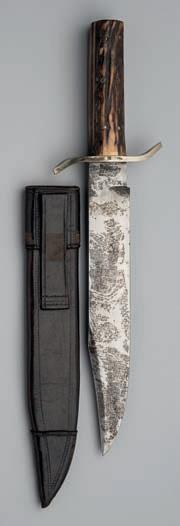
the first with tapering blade, rectangular ricasso signed by the maker and with heart and pistol mark, German silver guard, ferrule and pommel, the latter two cast with scrolls in low relief, and ivorine grip, in its tooled and gilt leather scabbard with white metal mounts; the second with tapering blade of diamond section etched with foliage and the inscription ‘never draw me without reason nor sheath me without honour’, moulded white metal hilt comprising oval guard and fluted grip, in its tooled and gilt leather scabbard (areas of wear); the third with tapering blade double-edged towards the point and writhen over the back-edge, white metal neo rococo hilt cast in low relief including grip decorated with scrolls, in its tooled leather scabbard; the fourth with tapering double-edged blade, neo-rococo German silver hilt cast in low relief, in its scabbard (incomplete), the first: 20.8 cm (4)
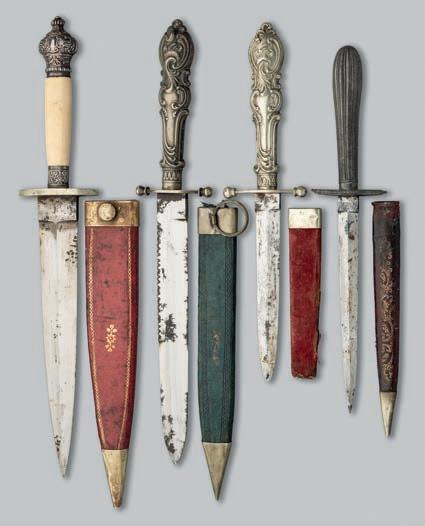
Literature
David Hayden-Wright, The Heritage of English Knives, Atglen, Pennsylvania, 2008, p. 271.
See footnote to lot 577.
£300-400
577 578 579 580 See page iii for Buyer’s Premium and other charges
32
Joseph Rodgers & Sons Ltd

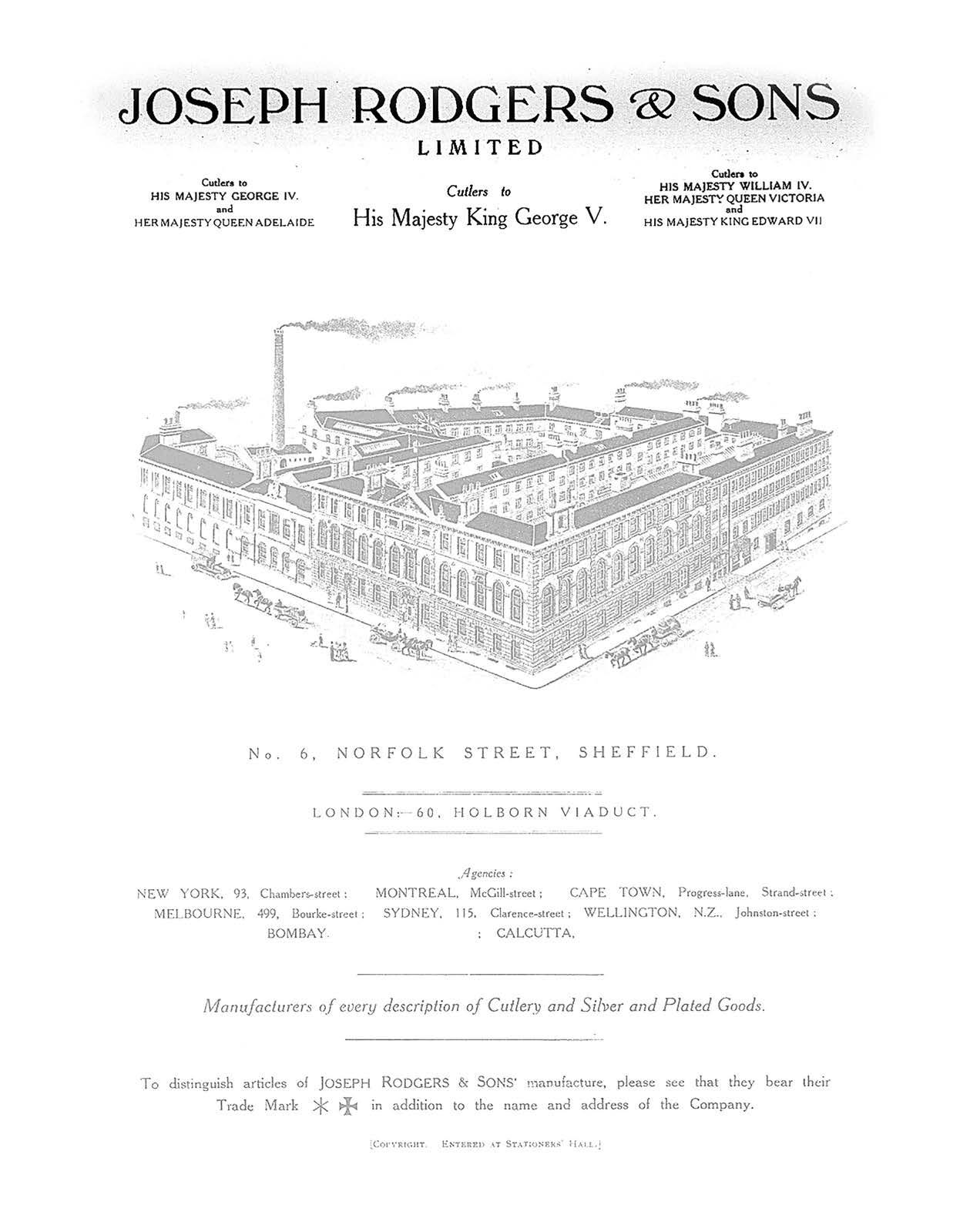
In the nineteenth century, Rodgers had an unsurpassed reputation and history that was synonymous with the cutlery trade. The family’s first cutler, John Rodgers (1701-85), is recorded around 1724, with a workshop near the present cathedral. In the same year the Company of Cutlers ‘let’ him a mark, a Star and Maltese Cross, which became world famous in later years. John Rodgers had three sons, John (1731-1811), Joseph (1743-1821), and Maurice (c.1747-1824) who joined the business and succeeded him. They are recorded with more workshops by 1780 and the business soon extended to occupy a nearby block of buildings at 6 Norfolk Street, an address that became as famous as Rodgers’ trade mark. By the early 19th century their trade had expanded from pen and pocket knives to include table cutlery and scissors. By 1817 the General Sheffield Directory lists the firm as ‘merchants, factors, table and pocket knife, and razor manufacturers’. In 1821 John’s son Joseph died and his sons continued the business under the leadership of the younger John (grandson of the founder). John was described as ‘unobtrusive in his manner’ but was ambitious and one of the founding partners of the Sheffield Banking Co. He had a flair for marketing and travelled the country taking orders. Not only was his firm’s output and range greater than any other Sheffield firm, but its quality was superior. The company’s manifesto states: ‘The principle on which the manufacture of cutlery is carried on by this firm is – quality first … [and] … price comes second’. He began making exhibitions knives and presented George IV with a minute specimen of cutlery with 57 blades, which occupied only an inch [25mm] when closed. In 1822, Rodgers’ was awarded its first Royal Warrant. Another fourteen royal appointments, from British and overseas royal dignitaries, followed over the next eighty years, and its company history was duly titled: Under Five Sovereigns. John Rodgers next commissioned the Year Knife, with a blade for every year (1821) and opened his sensational cutlery showroom in Norfolk Street where visitors came to marvel at Rodgers’ creations. Perhaps the greatest highlight shown there was the Norfolk Knife, an over 30 inch long sportsman’s knife with 75 blades and tools, that Rodgers’ produced for the Great Exhibition in 1851. The showroom proved particularly popular with Americans whose trade played a significant role in the firm’s expansion. Additionally, they looked East, with agents in Calcutta, Bombay, and Hong Kong by the mid-19th century. These markets enabled Rodgers to become the largest cutlery factory in Sheffield. The number of workmen appears to have grown from about 300 in the late 1820s, to over 500 in the 1840s. In 1871 the business became a limited company with Joseph Rodgers (1828-1883), grandson of the Joseph Rodgers who had died in 1821, and Robert Newbold as managing directors. Joseph died on 12 May 1883 and Newbold became the chairman and managing director. The firm continued to expand with offices in London, New York, New Orleans, Montreal, Toronto, Calcutta, Bombay and Havana. Their work force in 1871 was around 1,200 and accounted for one-seventh of all Sheffield’s American cutlery trade. In 1876 the American market was stagnating and Rodgers’ began looking elsewhere with a focus on trade in the Middle East, India and Australia. The name ‘Rujjus’ or ‘Rojers’ was said to have entered the language as an adjective expressing superb quality in Persia, India and Ceylon. By 1888, the value of Rodgers’ shares had more than doubled and, in 1889, a silver and electro-plate showroom was opened in London. At this time, Rodgers acquired the scissors business of Joseph Hobson & Son. Rodgers’ produced catalogues that were packed with every type of knife imaginable. Pocket knives were made in scores of different styles. Ornate daggers and Bowie knives and complicated horseman’s knives were made routinely. Some patterns, such as the Congress knife and Wharncliffe knife, were Rodgers’ own design. The Wharncliffe – with its serpentine handle and beaked master blade – was apparently designed after a dinner attended by Rodgers’ patron Lord Wharncliffe. The firm’s workmanship was usually backed by the best materials. Rodgers’ ivory cellar in Norfolk Street was crammed with giant tusks and was regarded as one of the hidden sights of the town. Four or five men were constantly employed in sawing the tusks, and around twenty four tons of ivory were used a year in 1882. Rodgers’ appetite for stag was no less insatiable: deer horns and antlers filled another cellar and pearl from the Philippines was also cut there. Around 1890, Rodgers’ began forging its own shear steel and in 1894 they began melting crucible steel.
Newbold retired in 1890 and the grandsons of Maurice Rodgers, Maurice George Rodgers (1855-1898) and John Rodgers (1856-1919), became joint-managing directors. The McKinley Tariff Act of 1890 halved their American business and consequently they toured South Africa. Despite increasing foreign competition and the decline of the American market, Rodgers’ prospered before the First World War. However, workers’ wages were cut while the partners continued to take significant dividend which culminated in a prolonged and bitter strike. The First World War saw a decline in the business which continued steadily until the 1975 when it was absorbed by Richards and ceased trading in 1983. Joseph Rodgers & Sons left an enduring legacy in its knives. Its dazzling exhibition pieces and other fine cutlery show that the company’s reputation as Sheffield’s foremost knife maker was well founded. Abbreviated from Tweedale 2019 and Hawley 2023.
33
~
581
AN EXCEPTIONAL DISPLAY OF TWELVE MINUTE PAIRS OF SCISSORS, SHEFFIELD, 19TH CENTURY, PROBABLY JOSEPH RODGERS & SONS
the scissors of burnished steel, mounted on a pad on a balance of finely chiselled burnished steel, the opposing balance with a single small square weight, all mounted on a blue velvet base with an ivory shield-shaped escutcheon inscribed ’12 pairs of perfect scissors which weigh only half a grain’, complete with a tortoiseshell mounted angled magnifying glass, on a moulded wooden stand with bun feet and glass dome cover, the scissors approximately 2.5 mm overall
Provenance
Stated by the vendor to have been part of the celebrated displays at Joseph Rodgers & Sons showrooms at 9 Norfolk Street.

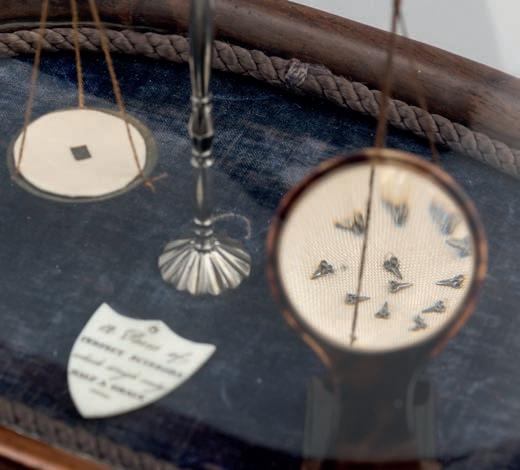
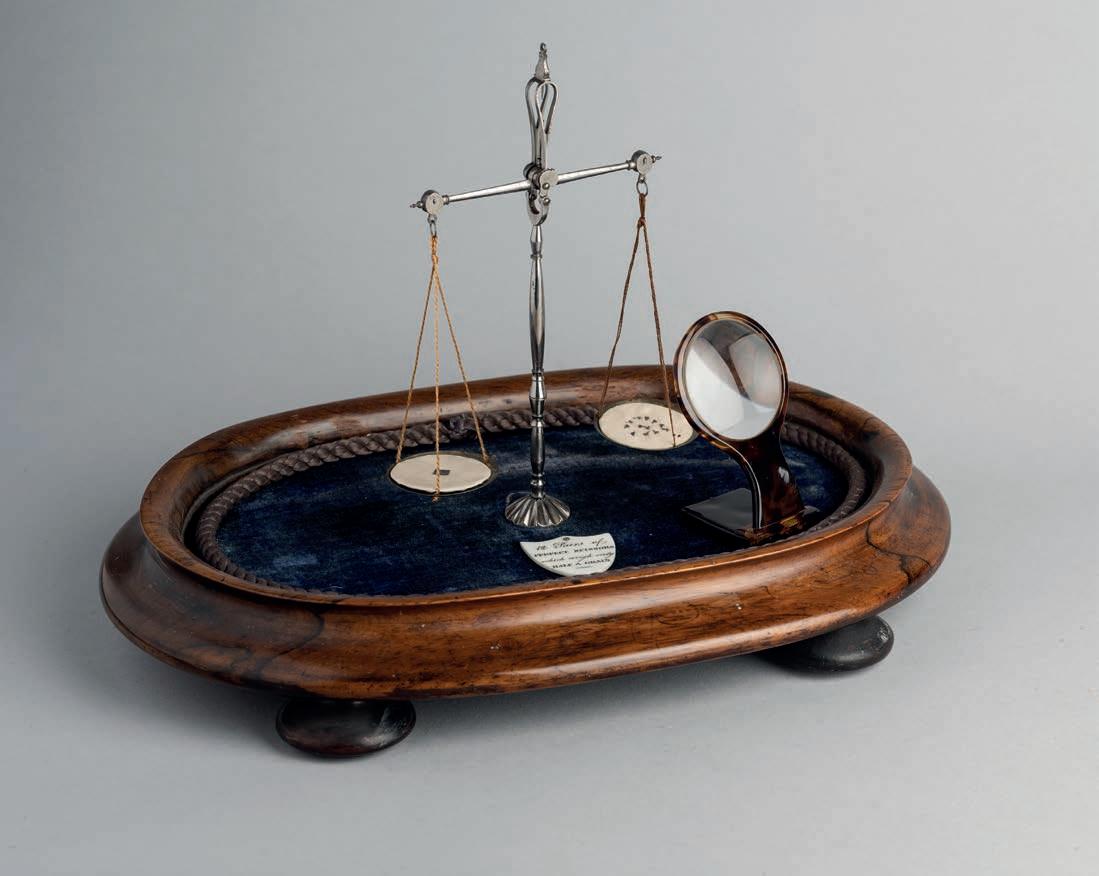
Literature
David Hayden-Wright, The Heritage of English Knives, Atglen, Pennsylvania, 2008, p. 88.
£4,000-6,000
See page iii for Buyer’s Premium and other charges
34
~ 582
AN EXCEPTIONAL GOLD AND GILT-BRASS MOUNTED MINIATURE PENKIFE FOR ROYAL PRESENTATION, JOSEPH RODGERS & SONS, SHEFFIELD, THIRD QUARTER OF THE 19TH CENTURY with over forty eight folding blades and accessories including fleams, saw, awls, corkscrew, fork and picks, many signed and some elements in gold, finely filed fillets, mother-of-pearl scales over gold fillet each retained by three gold rivets, one side with a vacant rectangular escutcheon and the other with a shield shaped escutcheon engraved with the crowned letter ’A’, spirally-fluted burnished steel stem, cast and chiselled gilt-copper alloy stand engraved with foliage against a frosted ground, on its carved ivory two-piece base carved with neo-gothic foliage on the top and the base encircled by rectangular panels filled with further designs of foliage and the Royal initial ‘A’ beneath a royal coronet front and back, on an associated moulded wooden base with glass dome cover, 11.5 cm (the knife and ivory stand, opened), 1.8 cm (the knife, closed)


Provenance
The initial A beneath a British Royal coronet suggests a presentation by the makers to one of Queen Victoria’s children, Princess Alice (1843-78), Prince Alfred (1844-1900) or Prince Arthur (1850-1942).

Stated by the vendor to have been part of the celebrated displays at Joseph Rodgers & Sons showrooms at 9 Norfolk Street.
Literature
David Hayden-Wright, The Heritage of English Knives, Atglen, Pennsylvania, 2008, p. 87.

A UK Ivory Act 2018 certificate for this lot will be made available to the purchaser
£3,000-5,000
35
A FINE AND VERY RARE SMALL BARREL POCKET KNIFE, JOSEPH RODGERS, MAKERS TO HIS MAJESTY, NO. 6 NORFOLK STREET, SHEFFIELD, LATE 19TH CENTURY
with four small folding blades of differing form at each end, German silver fillets, and four turned moulded mother-of-pearl scales, each retained by a rivet top and bottom, in a French leather-covered case, probably original, 8.0 cm (closed)
Literature
David Hayden-Wright, The Heritage of English Knives, Atglen, Pennsylvania, 2008, p. 119.
£250-350
584
A LARGE SPORTSMAN’S OR COACHMAN’S KNIFE, RODGERS, CUTLERS TO HIS MAJESTY, 6 NORFOLK STREET, LATE 19TH CENTURY AND ANOTHER, JOSEPH ELLIOTT & SONS, SHEFFIELD
the first with eight folding elements including signed blades, farrier’s hook, scoop borer, corkscrew and cartridge extractor, milled copper alloy fillets, nickel silver body and loop; the second with six folding elements including signed blade, button hook, farriers hook and scoop borer, copper alloy fillers, nickel silver body and loop, the first: 12.7 cm (closed) (2)

Literature
David Hayden-Wright, The Heritage of English Knives, Atglen, Pennsylvania, 2008, p. 154.

£350-450
~ 585
A PROPELLING PENCIL AND KNIFE FORMED AS A PERCUSSION MUSKET, RODGERS, CUTLERS TO HER MAJESTY, LATE 19TH CENTURY AND A CASED PAIR OF MINIATURE PENKNIVES


the first with folding blade stamped by the maker and with cross marks at the ricasso, folding German silver propelling pencil, tortoiseshell veneered stock, and German silver details; the second comprising one knife with two folding blades and another with single folding blade, each with mother-of-pearl body, in lined padded case, the outside embossed Rodgers, Cutlers to his majesty’ in gilt letters, the first: 8.7 cm (closed) (2)
Literature
David Hayden-Wright, The Heritage of English Knives, Atglen, Pennsylvania, 2008, p. 115.
£300-500
583
583
See page iii for Buyer’s Premium and other charges 36
584 585
~ 586
THE MULTI-BLADE LOCKBACK SPORTSMAN’S POCKET KNIFE GIVEN BY CAPTAIN WELFIT AS A MARK OF ESTEEM AND APPROBATION FOR ORDERLY CONDUCT AND SOLDIER-LIKE APPEARANCE AT NEWARK. 8TH MAY 1847, JOSEPH RODGERS & SONS, 6 NORFOLK ST, SHEFFIELD, CUTLERS TO HIS MAJESTY with signed single-edged spearpoint blade, signed paring blade, ivory blade with 4 in graduated ruler, propelling pencil, corkscrew, awl trace borer, main triangular awl, button hook, screwdriver, and farrier’s hook, the latter with presentation inscription, concealed toothpick, tweezers, and split folding tortoiseshell scales with surgical fleam, natural staghorn scales, German silver escutcheon engraved ‘Robert Tillotson’: in red Morocco leather lined case, probably the original, 14.5 cm (case)
Literature
David Hayden-Wright, The Heritage of English Knives, Atglen, Pennsylvania, 2008, p. 85. £1,000-1,500

587
A FINE GOLD-MOUNTED PENKNIFE, JOSEPH RODGERS & SONS, 6 NORFOLK ST, SHEFFIELD, CUTLERS TO HIS MAJESTY, LAST QUARTER OF THE 19TH CENTURY with twelve folding blades and accessories, including bodkin, borer, hoof pick, and corkscrew, stamped with the maker’s details and mark of a star and cross, fitted with rounded mother-of-pearl scales retained by four gold-capped rivets, four finely engraved gold terminals, and vacant gold shield-shaped escutcheons, 11.3 cm (closed)
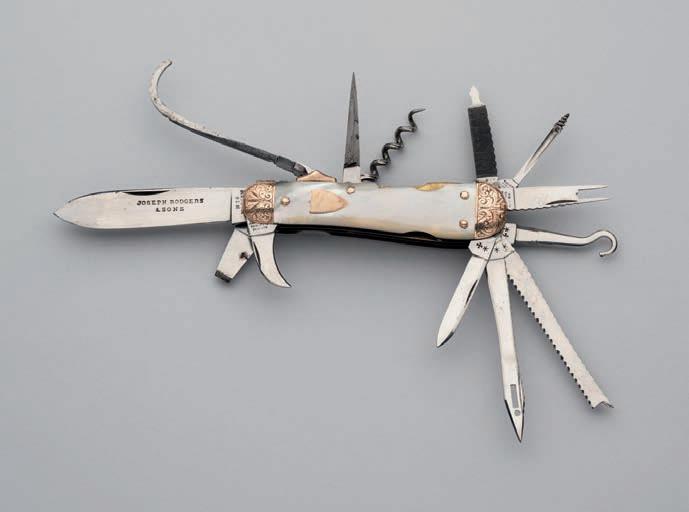
Provenance
Stated to have been made for the Duke of Rutland.
Literature
David Hayden-Wright, The Heritage of English Knives, Atglen, Pennsylvania, 2008, p. 78.

Hayden-Wight states that an identical knife was made for Ulysses S. Grant, 18th President of the United States (1869-77).
£1,000-1,500
587
586
37
588
A SPORTSMAN’S ‘WHARNCLIFFE’ KNIFE, RODGERS, NO. 6 NORFOLK STREET, SHEFFIELD, CUTLERS TO HIS MAJESTY, EARLY 20TH CENTURY with folding blade stamped ‘Wharncliffe’, saw, corkscrew, awl, shaped farrier’s hook, inlet picker and tweezers, natural staghorn scales, brass fillets, and vacant German silver escutcheon, 10.4 cm (closed)

Literature
David Hayden-Wright, The Heritage of English Knives, Atglen, Pennsylvania, 2008, p.84.
£150-200
589
A SPORTSMAN’S KNIFE BY J. RODGERS & SONS, 6 NORFOLK STREET, SHEFFIELD, EARLY 20TH CENTURY AND FOUR POCKET KNIVES, JOSEPH RODGERS, SHEFFIELD, EARLY 20TH CENTURY the first with seven folding elements including signed blades, belt hook, farriers hook and corkscrew, nickel-silver scales and loop; the second to fifth each stamped with the maker’s details at the ricasso of the main blade, two with clipped-points and two with spear points, the first: 12.5 cm (closed) (5)

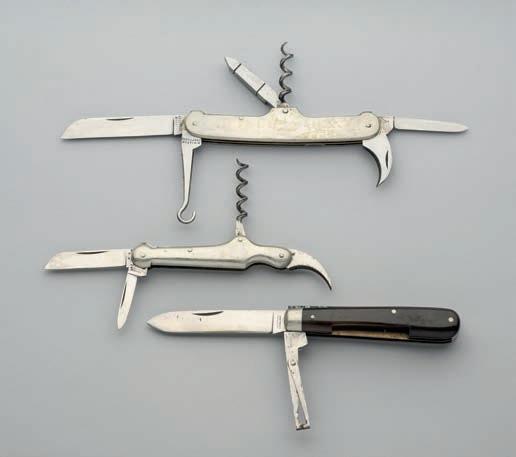
Literature
David Hayden-Wright, The Heritage of English Knives, Atglen, Pennsylvania, 2008, pp. 151 & 142.

£300-350
590
A BUTLER’S KNIFE BY RODGERS, 6 NORFOLK STREET, SHEFFIELD, EARLY 20TH CENTURY AND TWO FURTHER KNIVES the first with four signed folding elements including the maker’s details and cross and star mark, and German silver body; the second W. Morton, Sheffield, with five folding elements including coach door key; and the third Richardson, Edinburgh with two folding elements comprising pen blade and pincers and horn scales, the first: 9.0 cm (3)
Literature
David Hayden-Wright, The Heritage of English Knives, Atglen, Pennsylvania, 2008, p. 151.
£250-300
588
590 See page iii for Buyer’s Premium and other charges 38
589
591
EIGHT LOCK KNIVES, JOSEPH RODGERS & SONS, NO. 6 NORFOLK STREET, SHEFFIELD, EARLY 20TH CENTURY signed on the blades and with the address details at the ricassi, five with a single blade and three with two blades, and each with natural staghorn scales, the longest: 15.5 cm (closed) (8)
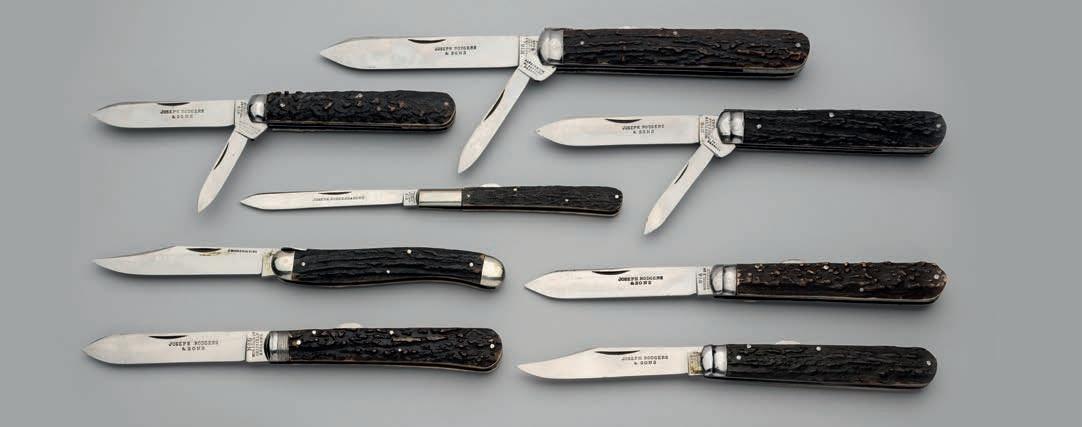
Literature
David Hayden-Wright, The Heritage of English Knives, Atglen, Pennsylvania, 2008, p. 135.
£200-300
592
AN ANGLER’S KNIFE, RODGERS, CUTLERS TO HIS MAJESTY, EARLY 20TH CENTURY

with four folding elements including main blade with maker’s details and cross and star marks at the ricasso, scissors and spring balance, brass fillets, chequered scales, concealed pricker and tweezers, vacant German silver escutcheon, and German silver loop, 10.5 cm (closed)
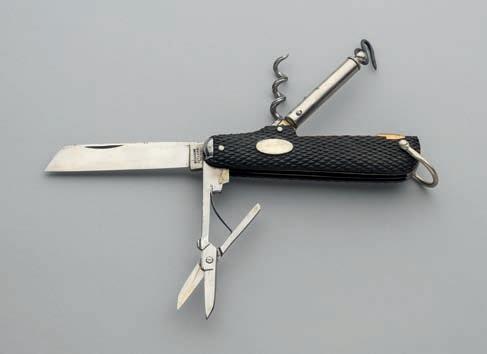
Literature
David Hayden-Wright, The Heritage of English Knives, Atglen, Pennsylvania, 2008, p. 142.
£200-300
593
A FOLDING ‘PANTOGRAPH’ KNIFE STAMPED JOSEPH RODGERS & SONS, AND TWO FURTHER ‘PANTOGRAPH’ KNIVES, 20TH CENTURY
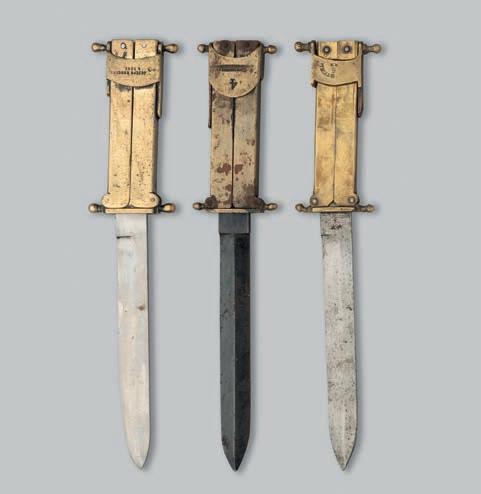
the first with double-edged spear-pointed blade, plain ricasso, folding brass body stamped ‘Joseph Rodgers & Sons’ and with star and cross mark (poorly struck); the second an Indian copy, stamped ‘Steel’ and ‘6’ on the brass catch; and the third similar, with coarse markings including broad arrow, the first: 15.0 cm blade (3)
Literature
David Hayden-Wright, The Heritage of English Knives, Atglen, Pennsylvania, 2008, p. 50, 231, 231.
£300-400
591
592
39
593
594
TWO RARE MILITARY SERVICE POCKET KNIVES BY JOSEPH RODGERS, & SONS, MAKERS TO HIS MAJESTY, NO. 6 NORFOLK STREET, SHEFFIELD, TWO FURTHER MILITARY POCKET KNIVES A TRUNCHEON AND TWO MILITARY STYLE FOLDING POCKET KNIVES
the first with signed folding knife blade, three folding saw blades, a pair of snips, German silver body stamped ‘Rodgers’ and two loops; the second similar, with two blades and snips; the third with German silver scales engraved ‘Col. Sergt.F. Rigby, South Staffs Regiment’; the fourth with two blades and iron body; the fifth formed of three tapering sections with wooden terminal; the sixth and the seventh each with two folding blades, three saws, the terminal incorporating a screw driver and the other incorporating a pair of snips, blued iron body and two loops, the first: 13.0 cm (closed) (7)



Literature
David Hayden-Wright, The Heritage of English Knives, Atglen, Pennsylvania, 2008, p. 222-4.

£350-500
595
A MILITARY FOLDING LOCK KNIFE, JOSEPH RODGERS & SONS, 6 NORFOLK STREET, SHEFFIELD, CIRCA 1880-90 with folding locking blade stamped with the maker’s details and star and cross mark on one face, formed with a clipped-back point, a pair of folding white metal wavy double quillons, brass fillets, chequered scales, iron blade lock and release lever, in its leather scabbard belt loop, 19.0 cm
Literature
David Hayden-Wright, The Heritage of English Knives, Atglen, Pennsylvania, 2008, p. 220.
£300-400
596
A LOCK KNIFE J. RODGERS & SONS, NO. 6 NORFOLK STREET, SHEFFIELD, LATE 19TH CENTURY AND FOUR FURTHER PENKNIVES the first with folding locking blade signed on one face, rectangular ricasso with the maker’s address on one face and star and cross mark on the other, brass fillets, natural staghorn scales and German silver mounts; the second Turner & Co., with cleaver shaped blade and natural staghorn scales the third a Continental clasp knife; the fourth of military type stamped ‘GI & Co’ and with ‘AM’ crowned; the fifth George Wostenholm, with signed folding blade marked ‘I.XL’, and natural staghorn scales, the first: 13.0 cm (closed) (5)
£100-150
~ 597
A TORTOISESHELL MOUNTED POCKET KNIFE, JOSEPH RODGERS & SONS, CUTLERS TO HIS MAJESTY, NO. 6 NORFOLK STREET, SHEFFIELD AND FIFTEEN FURTHER POCKET KNIVES, LATE 19TH/EARLY 20TH CENTURY

the first with four folding blades, stamped by the maker and with cross marks, German silver mounts and tortoiseshell scales; a ‘Real Pampa knife’ by Lockwood brothers, with two signed folding blades; five knives by Joseph Elliott & Sons, each with two folding blades; four knives by Joseph Elliott & Sons, each with a single folding blade; another by J. Elliott; and four further knives, the first: 8.5 cm (closed) (16)
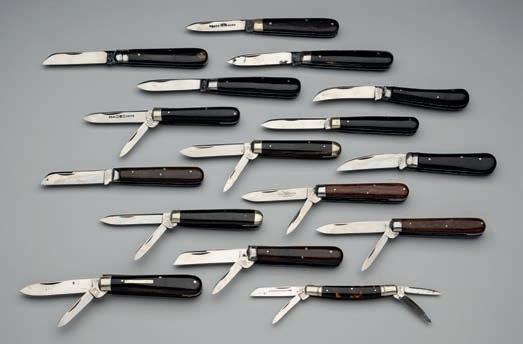
Literature
David Hayden-Wright, The Heritage of English Knives, Atglen, Pennsylvania, 2008, p. 117.
£200-250
594
595
See page iii for Buyer’s Premium and other charges
596
40
597
598
A RARE PENKNIFE WITH MAGNIFYING GLASS, JOSEPH RODGERS AND A SIXTEEN-BLADE PENKNIFE, LATE 19TH/20TH CENTURY
the first with signed blade, magnifying glass and polished horn scales; the second with sixteen small folding blades, cylindrical body with four hardwood scales and German silver terminals, the first 8.5 cm (closed) (2)

Literature
David Hayden-Wright, The Heritage of English Knives, Atglen, Pennsylvania, 2008, p. 119.

£150-200
599
A POCKET KNIFE WITH CONCEALED LOCKING MECHANISM, JOSEPH RODGERS & SONS, NO. 6 NORFOLK ST, SHEFFIELD AND A POCKET KNIFE WITH SIX INTERCHANGEABLE BLADES BY THE SAME MAKER, LATE 19TH CENTURY

the first with signed folding blade, stamped with the maker’s address and cross marks at the forte, chequered scales, and concealed pricker and tweezers; the second comprising six differing blades with signed ricassos, recessed pierced tangs, and staghorn scales, and another small knife (3)
£200-250
600
A RARE SOUVENIR KNIFE, JOSEPH RODGERS AND SONS, NO. 6 NORFOLK STREET, SHEFFIELD, DATED 1876

with single folding blade struck with the maker’s details and cross and star mark, and scales with the inscription ‘H.R.H. Prince of Wales / Welcomed to India 1876 / H.R.H. Princess of Wales’ on one face and their portrait medallions on the other, 10.0 cm (closed)
£100-150
601
JOSEPH RODGERS & SONS LTD, 6 NORFOLK STREET, SHEFFIELD: TWO PENKNIFE COMPONENT DISPLAY BOARDS, LATE 19TH/20TH CENTURY

comprising copper alloy fillet and end mounts, on two boards printed with the crowned royal arms and the full manufacturer’s details, one board with elements numbered ‘200-254’ and the other ‘255 – 300’ (areas of wear and minor losses), 46.2 cm x 26.0 cm (2)
£100-150
600 41
598 599 601
A DISPLAY OF KNIVES, JOSEPH RODGERS & SONS, NO. 6 NORFOLK STREET, SHEFFIELD, SECOND HALF OF THE 19TH CENTURY
the first a bowie knife, with Eastern style blade formed with a double-edged point and strongly writhen back-edge silver-plated cross-piece and pommel, and writhen gilt copper-alloy grip (the inner face missing and flattened for display; four folding penknives with signed folding blades and staghorn scales; two slender penknives with signed folding blades and ivory scales, in a framed display with perspex cover (detached), the first 47.0 cm


overall
Literature
David Hayden-Wright, The Heritage of English Knives, Atglen, Pennsylvania, 2008, p. 102.

£2,000-2,500
603
A LARGE DISPLAY BOWIE KNIFE IN THE EASTERN STYLE, JOSEPH RODGERS & SONS, 6 NORFOLK STREET, SHEFFIELD, LATE 19TH CENTURY
with strongly curved ‘scimitar’ blade with a double-edged point, fullered and elaborately filed over the lower back-edge, engraved with the maker’s details including star and cross mark (rubbed), silver plated cross-piece and pommel each engraved with flowers and foliage and natural staghorn grip (the inner face flattened for display), framed, the knife 55.0 cm overall
Literature
David Hayden-Wright, The Heritage of English Knives, Atglen, Pennsylvania, 2008, p. 100.
£2,000-2,500
See page iii for Buyer’s Premium and other charges 603
602
~ 602
42
604
A LARGE DISPLAY BOWIE KNIFE, JOSEPH RODGERS & SONS, 6 NORFOLK STREET, SHEFFIELD, LATE 19TH CENTURY with heavy blade formed with a spear point, chevron fluted backedge of V-section and a long slender fuller on each face, stamped with the maker’s details and star and cross mark on one face, rectangular ricasso, nickel silver cross-piece cast and chased with foliage in low relief, comprising a pair of slightly curved quillons enclosing an elliptical guard beneath, natural staghorn angular grip, and gadrooned pommel (flattened for display), 36.0 cm blade
Literature
David Hayden-Wright, The Heritage of English Knives, Atglen, Pennsylvania, 2008, p. 103.

£2,000-3,000
605
A LARGE DISPLAY BOWIE KNIFE IN THE EASTERN STYLE, JOSEPH RODGERS, SHEFFIELD, EARLY 20TH CENTURY with strongly curved ‘scimitar’ blade with a double-edged point, fullered and elaborately filed over the lower back-edge, engraved with the maker’s details including star and cross mark, and a crown dividing the royal initials GR (rubbed), silver plated crosspiece and pommel each engraved with flowers and foliage and chequered grip (the inner face flattened for display), framed, the knife 48.7 cm overall


Literature
David Hayden-Wright, The Heritage of English Knives, Atglen, Pennsylvania, 2008, p. 100.
£1,500-2,000
605
604
43
606
A LARGE BOWIE KNIFE, JOSEPH RODGERS & SONS, 6 NORFOLK STREET, SHEFFIELD, LATE 19TH CENTURY with strongly curved ‘scimitar’ blade double-edged over its upper half and elaborately filed over the lower back-edge, struck with the maker’s details, and cross and star mark at the ricasso on one face and ‘double sheer steel’ and ‘hand forged’ on the other, thick burnished cross-piece with filed edges, gilt copper alloy cylindrical grip cast and chased with an elaborate frieze of vine fruit and foliage against a finely matted ground, and the top with the owners monogramed initials, 45.7 cm overall
Literature
David Hayden-Wright, The Heritage of English Knives, Atglen, Pennsylvania, 2008, p. 101.
£1,500-1,800
607
A BOWIE KNIFE, JOSEPH RODGERS & SONS, CUTLERS TO THEIR MAJESTIES, NO. 6 NORFOLK STREET, SHEFFIELD, CIRCA 1880 with single-edged blade formed with a false swage and stamped with the maker’s details including cross and star mark on one face, German silver hilt comprising shaped guard with integral ferrule, back-strap shaped for the fingers and domed pommel, and chequered horn grips retained by four rivets, in its leather scabbard with large shaped German silver mounts and later belt loop, 22.5 cm blade
Literature
David Hayden-Wright, The Heritage of English Knives, Atglen, Pennsylvania, 2008, p. 259.
£700-900
608
A BOWIE KNIFE, JOSEPH RODGERS & SONS, MAKERS TO HER MAJESTY, LATE 19TH CENTURY with robust blade formed with a clipped-back point and false swage, filed back-edge and stamped by the maker along with star and cross mark on one face (light pitting, later blued finish in places), recessed ricasso, engraved gilt brass hilt comprising scrolling quillons and integral ferrule decorated with a neo rococo flower on a punched group, low domed pommel and natural staghorn grip, 25.2 cm blade



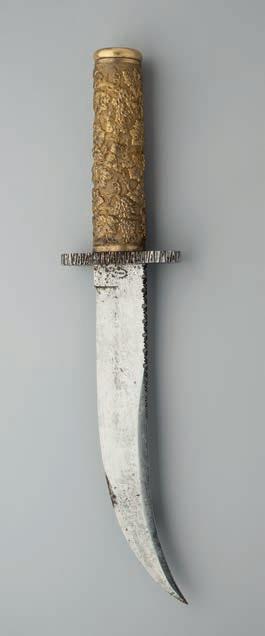
Literature
David Hayden-Wright, The Heritage of English Knives, Atglen, Pennsylvania, 2008, p. 256

£500-800
609
A FINE BOWIE KNIFE, JOSEPH RODGERS & SONS, NO. 6 NORFOLK STREET, SHEFFIELD, LATE 19TH CENTURY with tapering blade formed with a swaged clipped-back point, finely chevron-milled back edge with a fuller beneath on each face, stamped with the maker’s details and star and cross mark, German silver hilt comprising cross-piece with short recurved quillons with globular terminals and gadrooned cap pommel and natural staghorn grip, in its leather-covered wooden scabbard with German silver chape with moulded terminals, and locket with flower-shaped belt stud, 20.5 cm blade
Literature
David Hayden-Wright, The Heritage of English Knives, Atglen, Pennsylvania, 2008, p. 264.
£600-800
606 607 608 609 See page iii for Buyer’s Premium and other charges 44
610
A BOWIE KNIFE, JOSEPH RODGERS & SONS, CUTLERS TO THEIR MAJESTIES, NO. 6 NORFOLK STREET SHEFFIELD MADE FOR MANTON & CO. CALCUTTA, LAST QUARTER OF THE 19TH CENTURY



with single-edged blade formed with a spear point, struck with the maker’s and retailer’s details on one face, recessed rectangular ricasso, German silver oval guard, natural staghorn grip and German silver cap pommel (one rivet missing), in its leather scabbard with belt loop, 20.5 cm blade

Literature
David Hayden-Wright, The Heritage of English Knives, Atglen, Pennsylvania, 2008, p. 270.
£400-500
611
A BOWIE KNIFE, JOSEPH RODGERS & SONS, NO. 6 NORFOLK ST., SHEFFIELD, LATE 19TH CENTURY with straight blade formed with a clipped-back point and writhen back-edge accompanied by a long slender fuller on each face, signed on one face and with cross and star mark, rectangular ricasso, German silver hilt comprising recurved guard with globular terminals and gadrooned cap pommel, and natural staghorn grip, in its leather scabbard with belt loop, 18.2 cm blade
Literature
David Hayden-Wright, The Heritage of English Knives, Atglen, Pennsylvania, 2008, p. 296.
£400-600
612
A FINE BOWIE KNIFE, JOSEPH RODGERS & SONS, CUTLERS TO HER MAJESTY, LAST QUARTER OF THE 19TH CENTURY with broad double-edged blade of flattened-diamond section, formed with a spear point and three small elliptical indents on each face along the median, rectangular ricasso of flattenedhexagonal action struck with the maker’s details, the Royal letters ‘VR’ divided by a crown, and star and cross mark, German silver hilt comprising straight guard with integral ferrule and cap pommel, and natural staghorn grip, in its leather-covered wooden scabbard with German silver chape and locket, the latter with a button for a frog, 21.0 cm blade
Literature
David Hayden-Wright, The Heritage of English Knives, Atglen, Pennsylvania, 2008, p. 264.
£400-500
613
A FINE BOWIE KNIFE, JOSEPH RODGERS & SONS, CUTLERS TO THEIR MAJESTIES, NO. 6 NORFOLK STREET, SHEFFIELD, LAST QUARTER OF THE 19TH CENTURY with broad blade formed with a clipped-back point, struck with the maker’s details and star and cross mark on one face, German silver hilt shaped for grip and formed in one piece, including straight guard with integral ferrule and cap pommel, and a pair of mother-of-pearl scales retained by five rivets, in its leather scabbard with German silver locket and chape and belt loop with vacant German silver escutcheon, 15.3 cm blade
Literature
David Hayden-Wright, The Heritage of English Knives, Atglen, Pennsylvania, 2008, p. 264.
£350-450

610 611 612 613
45
614
A BOWIE KNIFE BY JOSEPH RODGERS & SONS, 6 NORFOLK STREET, SHEFFIELD, LAST QUARTER OF THE 19TH CENTURY with broad single-edged blade formed with a spear point, recessed rectangular ricasso struck with the maker’s details, the royal letters ‘VR’ divided by a crown, and cross and star mark, German silver hilt comprising two-piece ‘split’ guard and pommel each decorated with a design of raised dots and stylised foliage in low relief, and chequered horn scales retained by two rivets, in associated leather scabbard with German silver locket and chape, 20.5 cm blade



Literature
David Hayden-Wright, The Heritage of English Knives, Atglen, Pennsylvania, 2008, p. 265.
£350-450
615
A BOWIE KNIFE, JOSEPH RODGERS & SONS, CUTLERS TO THEIR MAJESTIES, NO. 6 NORFOLK STREET, SHEFFIELD, LAST QUARTER OF THE 19TH CENTURY
with broad blade formed with a clipped-back point, struck with the maker’s details and star and cross mark on one face (small areas of light pitting), oval German silver guard, and natural staghorn scales retained by five rivets, in its leather scabbard with large German silver locket and chape, 20.8 cm blade
Literature
David Hayden-Wright, The Heritage of English Knives, Atglen, Pennsylvania, 2008, p. 265.

£350-450
616
A BOWIE KNIFE, JOSEPH RODGERS & SONS, CUTLERS TO THEIR MAJESTIES, NO. 6 NORFOLK STREET, SHEFFIELD, LATE 19TH CENTURY
with straight blade formed with a clipped-back point, signed on one face and with star and cross mark (worn), German silver hilt shaped for the fingers, including oval guard and pommel, and a pair of natural staghorn scales retained by four rivets, in its pigskin scabbard with German silver locket, 21.5 cm blade
Literature
David Hayden-Wright, The Heritage of English Knives, Atglen, Pennsylvania, 2008, p. 303.
£350-450
617
A FINE BOWIE KNIFE, JOSEPH RODGERS & SONS, NO. 6

NORFOLK STREET, SHEFFIELD, LATE 19TH CENTURY with tapering blade formed with a swaged clipped-back point, finely scallop-milled back edge with a fuller beneath on each face, stamped with the maker’s details in small letters and with star and cross mark, German silver hilt comprising shaped cross-piece and flattened globular pommel and natural staghorn grip carved with a leaf on one face, in its leather scabbard with a belt loop, 18.5 cm blade
Literature
David Hayden-Wright, The Heritage of English Knives, Atglen, Pennsylvania, 2008, p. 264.
Described by the author as his favourite Bowie knife.
£350-450
614 615 616 617 See page iii for Buyer’s Premium and other charges 46
618
A BOWIE KNIFE, JOSEPH RODGERS & SONS, NO. 6 NORFOLK STREET, SHEFFIELD, LATE 19TH CENTURY
with single-edged fullered blade formed with a false swage, rectangular ricasso stamped with the maker’s details including cross and star mark, iron guard, German silver pommel and natural staghorn grip, in leather scabbard, 25.0 cm blade
Literature
David Hayden-Wright, The Heritage of English Knives, Atglen, Pennsylvania, 2008, p. 261.
£350-400
619
A FINE BOWIE KNIFE, JOSEPH RODGERS & SONS, CUTLERS TO HER MAJESTY, LAST QUARTER OF THE 19TH CENTURY with broad blade formed with a clipped-back point, struck with the maker’s details, the royal letters ‘VR’ divided by a crown and star and cross mark on one face, the reverse etched ‘Never draw me without reason’ and ‘nor sheath me without honour’ (faint in places), oval German silver guard, and chequered horn scales retained by three rivets, in its leather scabbard with German silver locket and chape and belt loop with vacant German silver escutcheon, 15.3 cm blade



Literature
David Hayden-Wright, The Heritage of English Knives, Atglen, Pennsylvania, 2008, p. 265.

£250-300
620
A BOWIE KNIFE, JOSEPH RODGERS & SONS, NO. 6 NORFOLK STREET, SHEFFIELD, EARLY 20TH CENTURY
with tapering blade formed with a clipped-back point, rectangular ricasso stamped with the maker’s details including cross and star mark and the Royal letters ‘ER’ divided by a crown, German silver guard with globular terminals, natural staghorn scales, vacant German silver escutcheon in its German silver-mounted leather scabbard with belt loop, 20.2 cm blade

Literature
David Hayden-Wright, The Heritage of English Knives, Atglen, Pennsylvania, 2008, p. 261.
£250-300
621
A BOWIE KNIFE, JOSEPH RODGERS & SONS, NO. 6 NORFOLK STREET, SHEFFIELD, EARLY 20TH CENTURY with tapering blade formed with a spear point, rectangular ricasso stamped with the maker’s details including cross and star mark and the Royal letters ‘GR’ divided by a crown, German silver oval guard, natural staghorn scales, in its leather scabbard with belt loop, embossed ‘H. Hidden’, 17.5 cm blade
Literature
David Hayden-Wright, The Heritage of English Knives, Atglen, Pennsylvania, 2008, p. 261.
£200-300
618 619 620 621
47
622
A MASSIVE KNIFE FOR EXHBITION, JOSEPH RODGERS & SONS, NO. 6 NORFOLK STREET, SHEFFIELD, LATE 19TH CENTURY with strongly tapering blade engraved ‘The Camp Knife’ in capitals, signed in full and with star and cross mark on one face, formed with a scrolled fluted back-edge and recessed at the ricasso, engraved silver-plated hilt of derived scimitar form decorated with flowers and foliage (losses) and gutta percha grips, 64.5 cm overall

Literature
David Hayden-Wright, The Heritage of English Knives, Atglen, Pennsylvania, 2008, p. 102.
£2,000-3,000

622 See page iii for Buyer’s Premium and other charges 48
623
A FIXED-BLADE CAMPAIGN KNIFE, JOSEPH RODGERS & SONS, CUTLERS TO HER MAJESTY, LATE 19TH CENTURY, POSSIBLY MADE FOR PRESENTATION BY ALBERT EDWARD, PRINCE OF WALES AND LATER KING EDWARD VII (1841-1910) with fixed blade with clipped-back point and filed back-edge, struck with the maker’s details, ‘VR’ divided by a crown, and star and cross, with four folding elements including corkscrew, button hook and awl, further accessories including tweezers, pincers, scissors and pricker concealed in the German silver pommel, the latter engraved ‘1875’ and ‘AE’, chequered horn scales, in its German silver-mounted leather scabbard engraved ‘AE’ ‘1875’ and with the crowned Most Noble Order of the Garter on the locket, with a loop for suspension, 22.0 cm overall (the knife)



Literature
David Hayden-Wright, The Heritage of English Knives, Atglen, Pennsylvania, 2008, p. 97.
£500-700
624
A HUNTING KNIFE, JOSEPH RODGERS & SONS, CUTLERS TO HER MAJESTY, SHEFFIELD, CIRCA 1860 with tapering blade formed with a spear point, stamped with the maker’s details on one face, and ‘The Hunter’s Companion’ in script, rectangular ricasso struck with star and cross mark, German silver hilt comprising recurved quillons with flattened scrolling terminals, cap pommel (fitted with later copper alloy oval), and spirally-bound fishskin-covered grip, in its leather scabbard with German silver chape and locket, the latter with a belt hook, 23.5 cm blade
Literature
David Hayden-Wright, The Heritage of English Knives, Atglen, Pennsylvania, 2008, p. 262.
£400-600
625
A HUNTING KNIFE, JOSEPH RODGERS & SONS, CUTLERS TO HER MAJESTY, SHEFFIELD, CIRCA 1860 with tapering blade formed with a false swage, engraved ‘The Hunter’s Companion’ in script, rectangular ricasso stamped with the maker’s details and star and cross mark, iron cross-guard, German silver small ferule, and shaped chequered grip, in its leather scabbard with German silver locket and chape, the former with an iron spring catch, 20.4 cm blade
Literature
David Hayden-Wright, The Heritage of English Knives, Atglen, Pennsylvania, 2008, p. 262.
£400-600

623 624 625 49
626
A SMALL DIRK, JOSEPH RODGERS & SONS, CUTLERS TO THEIR MAJESTIES, NO. 6 NORFOLK STREET, SHEFFIELD, CIRCA 1880 with double-edged polished blade of diamond section swelling towards the point, stamped with the maker’s details including cross and star mark on one face, German silver recurved guard, mother-of-pearl grip. In its German silver-mounted leather scabbard and in fine condition throughout, 13.0 cm blade
Literature
David Hayden-Wright, The Heritage of English Knives, Atglen, Pennsylvania, 2008, p. 259.
£400-600
627
A SMALL DAGGER, RODGERS, CUTLERS TO HER MAJESTY AND ANOTHER, UNSIGNED, LATE 19TH CENTURY


the first with tapering double-edged blade, signed ricasso with star and cross mark, German silver hilt comprising straight guard with globular terminals, and beadwork grip, in associated scabbard; the second with tapering double-edged blade German silver beadwork hilt, and a pair of staghorn scales, in its leather scabbard, the first: 13.5 cm (2)
Literature
David Hayden-Wright, The Heritage of English Knives, Atglen, Pennsylvania, 2008, pp. 298 and 303.

£300-400
628
A DIRK BY JOSEPH RODGERS & SONS, CUTLERS TO THEIR MAJESTIES, NO. 6 NORFOLK STREET, SHEFFIELD, LAST QUARTER OF THE 19TH CENTURY with tapering blade formed with a false swage point and struck with the maker’s details including cross and star mark on one face, rectangular ricasso formed with two pairs of small notches, moulded ferrule, German silver pommel, spirally carved horn grip bound with plaited copper alloy wire, leather scabbard with large German silver chape and locket, the latter with belt hook, 15.5 cm blade
Literature
David Hayden-Wright, The Heritage of English Knives, Atglen, Pennsylvania, 2008, p. 265.
£350-400
629
A CASED SET OF CARVING KNIVES, JOSEPH RODGERS & SONS, CUTLERS TO HIS MAJESTY, SHEFFIELD, EARLY 20TH CENTURY AND ANOTHER


comprising knife struck with maker’s details, crown dividing the royal initials ‘GR’, and ‘Shear steel’, natural staghorn grip, and nickel silver pommel, fork and steel en suite in its leatherette case lined in blue with the maker’s detail inside the lid in gilt letters; the second, T. Glossop, Sheffield, similar, in its mahogany case, the first case 41.5 cm (2)
Literature
David Hayden-Wright, The Heritage of English Knives, Atglen, Pennsylvania, 2008, p. 192.
£150-200
626 627
See page iii for Buyer’s Premium and other charges
50
628
629
A RARE SILVER-MOUNTED JAMBIYA STYLE DAGGER FOR THE ARAB MARKET, JOSEPH RODGERS AND SONS, CUTLERS TO HER MAJESTY, SHEFFIELD, WILLIAM NEEDHAM, SHEFFIELD, 1897 with curved double-edged blade formed with two long fullers on each face and stamped with the maker’s details and the Royal letters ‘VR’ divided by a crown, silver ferrule, natural staghorn grip of characteristic form, in its leather-covered wooden scabbard with silver locket and leather belt loop, 19.5 cm blade
Literature
David Hayden-Wright, The Heritage of English Knives, Atglen, Pennsylvania, 2008, p. 262.


£1,000-1,500
631
A CASED SET OF TWENTY-ONE CLEAVERS, PERHAPS FOR PLANTATION USE, JOSEPH RODGERS & SONS, CUTLERS TO HIS MAJESTY, 6 NORFOLK STREET, SHEFFIELD, 20TH CENTURY each with hooked cleaver blade, stamped with the maker’s details, star and cross mark and the royal initials ‘GR’ divided by a crown, and shaped wooden grip, in a wooden case with embossed and gilt trade label, the case: 65.0 cm x 43.0 cm

Literature
David Hayden-Wright, The Heritage of English Knives, Atglen, Pennsylvania, 2008, p. 203.
£2,000-2,500
630
630 631
51
FOUR JOSEPH RODGERS PATENT QUILL MACHINES AND SEVEN POCKET MANICURE SETS, LATE 19TH/EARLY 20TH CENTURY

the first with steel blades, hardwood bodies, brass clips with the maker’s details and cross marks, and each in its case (one blade missing); the second all of folding scissor type, three with mother-of-pearl scales, three with tortoiseshell scales, and one with brass scales, the first: 13.5 cm (11)
Literature
David Hayden-Wright, The Heritage of English Knives, Atglen, Pennsylvania, 2008, p. 122, 125.

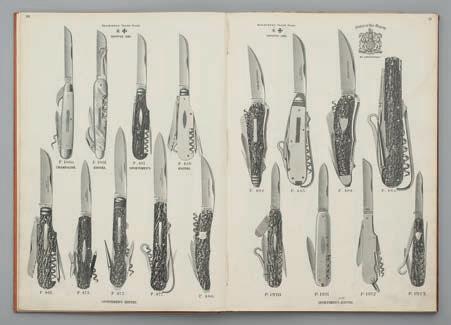
£200-300
633
TEN JOSEPH RODGERS PATENT QUILL MACHINES, LATE 19TH/EARLY 20TH CENTURY each with steel blade, hardwood body, brass clip with the maker’s details and star and cross marks, in its case, the first: 13.5 cm (10)
Literature
David Hayden-Wright, The Heritage of English Knives, Atglen, Pennsylvania, 2008, p. 125.
£150-200
634
A SALESMAN’S KNIFE DISPLAY AND A TOOL SET CASE, JOSEPH RODGERS, SHEFFIELD, LATE 19TH/EARLY 20TH CENTURY
the first of stiffened leather, lined in blue baize, with provision for eighteen knives, with embossed gilt label ‘Joseph Rodgers & Sons Ltd’, with star and cross trademark and ‘grant date 1682’; the second with provision for fourteen tools, embossed in gilt letters ‘Rodgers Tool Set’ and with star and cross mark on the inside (2)

£250-350
635
JOSEPH RODGERS & SONS LTD, 6 NORFOLK STREET, SHEFFIELD: THREE CATALOGUES, AND SIXTEEN EARLY PRINTS, 20TH CENTURY

the first 124 pp., extensively illustrated, original printed board covers; the second 194 pp. extensively illustrated, paper covers (worn, losses); the third 26 pp. paper covered and bound with a plastic spine bar, the fourth comprising sixteen photographs of penknives and cutlery, probably proof pieces for a catalogue (4)
£150-200

~
632
632 633 634 See page iii for Buyer’s Premium and other charges 635 52
A RARE KNIFE PATTERN BOOK, SHEFFIELD, CIRCA 1833-1910, INCLUDING DESIGNS FOR RODGERS
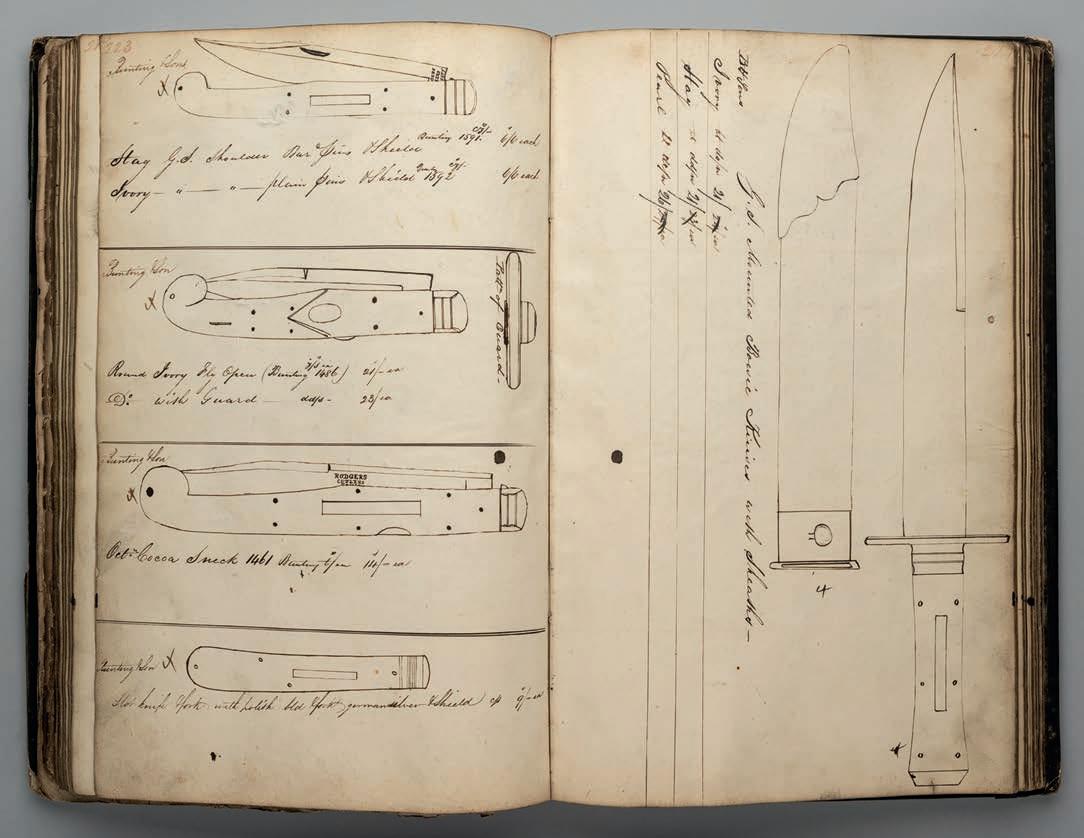
the front section including over sixty five illustrated pages of penknife elements comprising blades, scales, fillets, designs for etching and finished knives, including Knights Dagger, Sportsman’s Wharncliffe Knife, Civil Service Patterns, a War department design dated 1889, numbered consecutively from 1-918, the back section titled ‘Robert Sorby Patterns May 1833’, with summary descriptions and prices, numbered from 1-263, three pages of designs for folders, and a series of turned handle designs, marbled end-papers and original boards (worn, small losses)
Literature
David Hayden-Wright, The Heritage of English Knives, Atglen, Pennsylvania, 2008, pp. 12-13.
£350-450

636 636
53
GEORGE WOSTENHOLM & SON LTD


It is likely that the founder was George Wolstenholme (1775-1833), a fork maker at Thomas Lane. Apprenticed to John Micklethwaite, a cutler, in 1790 and granted his Freedom in 1799, George later moved to Broad Lane where he made spring knives. He was first listed in a Sheffield directory in 1816 as a pen and pocket knife manufacturer at Rockingham Street, where he had registered a silver mark in 1809. His workshops expanded to become Rockingham Works and he apparently shortened his name to ‘Wostenholm’ to facilitate its stamping on blades. His son, George Wostenholm (1802-1876) was apprenticed to his father and they are described in 1825 as ‘George Wolstenholme & Son, manufacturers of table knives, and forks, pen, pocket, and sportsman’s knives, and general dealers in cutlery, 78 Rockingham Street’. George Wostenholm became a Freeman in 1826, a practical cutler and a dynamic salesman he found scope for his prodigious energy in America where, in 1830, the father and son launched a partnership with William Stenton, an experienced cutlery merchant. However, this did not last and the partnership was dissolved the following year when they were also granted their trademark ‘I*XL. ‘, bought by George Senior in 1826 and originally granted to William Aldam Smith in 1787. In 1833 George Senior died and the business continued under his son who opened a New York office in 1844, and by the middle of the century had agents in Philadelphia and Boston. America was the ideal market with its expanding frontier and enormous demand for folding knives, razors, and weapons. The firm’s trade became almost exclusively American and Wostenholm made little attempt to nurture other markets. In 1848 the Washington Works was acquired and American orders continued to roll in. The workforce increased significantly to 850 in 1861, having been around a hundred or so in the 1830s.
The high quality of the firm’s Bowie and spring knives was achieved by ‘drilling’, in which every knife was critically examined. It had the desired effect and soon ‘I*XL’ vied with Rodgers’ star and Maltese cross as a badge of quality. Like Rodgers, Wostenholm made its share of exhibition pieces. At the Great Exhibition in 1851 Wostenholm displayed a set of ornate sheath knives, including one commissioned from the well-known artist Alfred Stevens. The company also displayed a collection of exhibition multi-blades for which they won a Prize Medal. The firm also won medals at the exhibitions in Paris (1855) and London (1862).
George Wostenholm had remarkable stamina. In early 1869, in his late sixties, he set off for a tour of Europe and in October the same year he made another trip to New York. In 1872, he again visited New York. He was active until the end, though he sold out to his business associates in 1875, when Wostenholm’s became a limited liability company. George Wostenholm died in 1876, aged 74 and left a remarkable fortune of nearly £250,000.
The new company chairman and directors had little or no experience of the cutlery trade. Initially, Wostenholm’s continued to make good profit but the McKinley Tariff of 1890 raised the duties on their American exports to unprecedented heights and caused a crisis. Wostenholm’s refused to abandon the American trade and maintained an unprofitable New York office until the early 1930s. Meanwhile they had little success breaking into the Australian and other markets. In the early 20th century they opposed machine technology and consequently were in decline a decade before the First World War. Not long after, Washington Works was becoming a relic. In 1971, Wostenholm was bought by Joseph Rodgers & Sons and the new company (Rodgers-Wostenholm) moved into premises at Guernsey Road, Heeley. Abbreviated from Tweedale 2019 and Hawley 2023.
54
A FINE LARGE MULTI-BLADE PENKNIFE FOR EXHIBITION, GEORGE WOSTENHOLM I.XL, SHEFFIELD, 20TH CENTURY with over one hundred folding blades and accessories, including saws, picks, scissors and corkscrew, some stamped ‘George Wostenholm I.XL.’, fitted at each side with highly figured select quality mother-of-pearl scales each retained by four minute screws, with sliding tweezers and picks top and bottom, and in fine condition throughout, 12.0 cm (closed)

Literature
David Hayden-Wright, The Heritage of English Knives, Atglen, Pennsylvania, 2008, p. 73.
£2,500-3,000

637 637
55
638
638
A FINE MULTI-BLADE PENKNIFE FOR EXHIBITION, GEORGE WOSTENHOLM I.XL, SHEFFIELD, EARLY 20TH CENTURY with over forty-eight folding blades and accessories, including saws, picks, scissors and corkscrew, some stamped ‘George Wostenholm I.XL.’, fitted at each side with highly figured composition scales each retained by four minute screws, with sliding tweezers and picks top and bottom, and in fine condition throughout, 12.0 cm (closed)
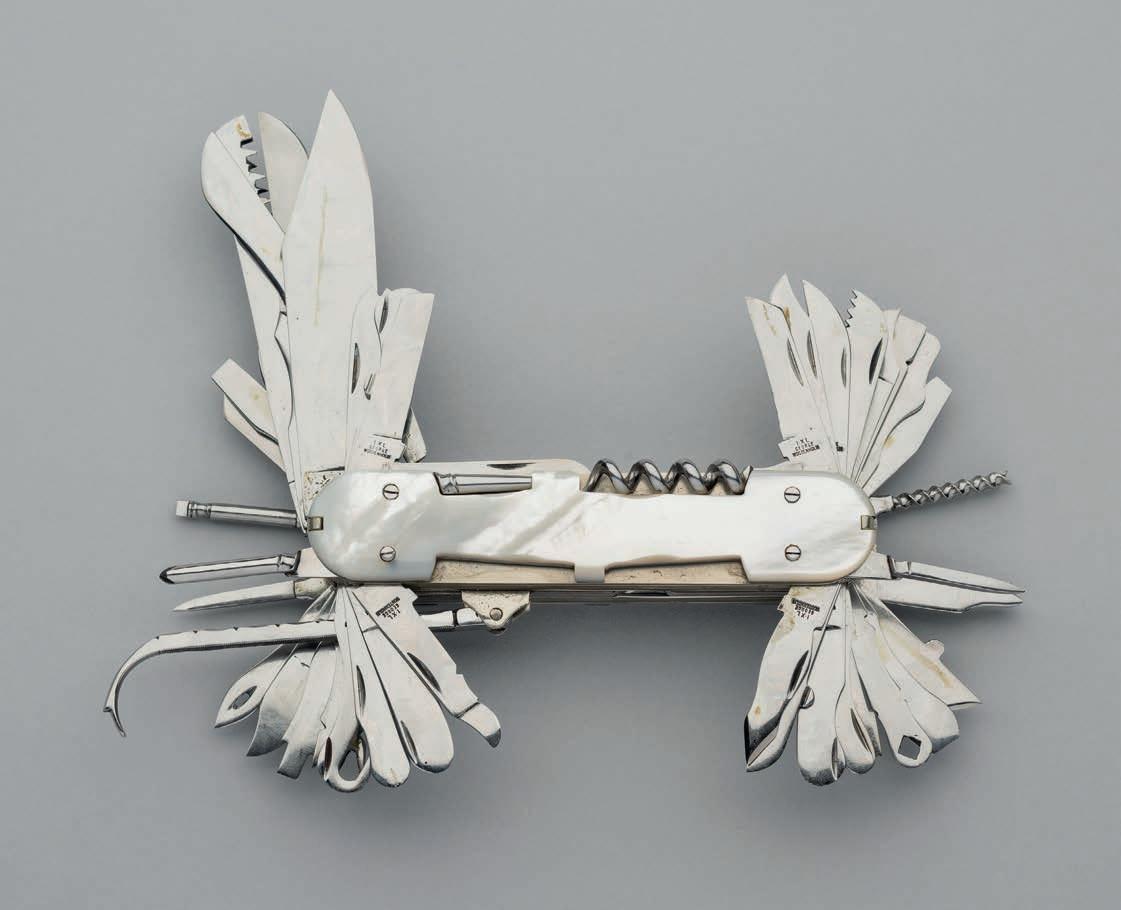
Literature
David Hayden-Wright, The Heritage of English Knives, Atglen, Pennsylvania, 2008, p. 73. £1,500-2,000

See page iii for Buyer’s Premium and other charges 56
639
A SMALL MULTI-BLADE PENKNIFE FOR EXHIBITION, GEORGE WOSTENHOLM I.XL, SHEFFIELD, EARLY 20TH CENTURY with over twenty folding blades and accessories, including saw, picks, scissors and corkscrew, the main blade stamped ‘George Wostenholm I.XL.’, fitted at each side with highly figured select quality mother-of-pearl scales each retained by three minute screws, with sliding tweezers and picks, and in fine condition throughout, 8.1 cm (closed)

Literature
David Hayden-Wright, The Heritage of English Knives, Atglen, Pennsylvania, 2008, p. 73.

£400-600
640
SIX POCKET KNIVES, GEORGE WOSTENHOLM, SHEFFIELD, 20TH CENTURY


the first with two folding blades, each stamped by the maker at the ricasso, the larger blade marked ‘I.XL’, brass fillets, chased German silver terminals and a small ivory central scales, one with a vacant German silver escutcheon; the second with two folding blades and cast body including the initials ‘I.XL’; the third and fourth with a single blade, the ferrules marked ‘I.XL; and two further knives, each in their original box, the first: 11.3 cm (closed) (6)
Literature
David Hayden-Wright, The Heritage of English Knives, Atglen, Pennsylvania, 2008, p. 143.
£250-300
641
TWO ‘NON XLL’ POCKET KNIVES, SHEFFIELD, EARLY 20TH CENTURY AND SIX FURTHER POCKET KNIVES
the first two probably Wostenholm, each with two folding blades, iron ferrule stamped ‘Non XLL’, and natural staghorn scales (one restored), the third Joseph Eliott, with two folding blades and natural staghorn scales; the fourth and fifth with cast bodies; and three further similar knives, the first: 8.5 cm (closed) (8)
Literature
David Hayden-Wright, The Heritage of English Knives, Atglen, Pennsylvania, 2008, p. 139.
£150-250
639
57
640 641
642
A MASSIVE EXHIBITION HUNTING KNIFE, GEORGE WOSTENHOLM & SON, WASHINGTON WORKS, I.XL, LATE 19TH CENTURY
with long blade formed with a spear point and with three panels of deeply filed grooves on the back-edge (small areas of light wear and staining), stamped with the maker’s details including ‘None are genuine but those marked I. XL.’, and eagle, ‘Geo. Wostenholm & Sons
Celebrated’ in a linear panel, and in large elaborate letters ‘For Stags and Buffalos’ on one face, rectangular ricasso, elliptical German silver cross-piece, and natural staghorn grips retained by five rivets, 35.2 cm blade

£2,500-3,000
643
A RARE BOWIE KNIFE PRESENTED TO JOHN CAMPBELL, SURGEON, JALAPA 1847, GEORGE WOSTENHOLM & SON, I.XL, WASHINGTON WORKS, SHEFFIELD with curved blade formed with a clipped point, engraved with an eagle displayed, ‘None are genuine but those marked I.XL.’, the maker’s details and presentation inscription, iron cross-guard with scrolling terminals, Indian style carved brown hardstone grip, in its leathercovered wooden scabbard (light wear, chape missing), 30.2 cm blade

Literature
David Hayden-Wright, The Heritage of English Knives, Atglen, Pennsylvania, 2008, p. 234.

The presentation inscription reads: John Campbell Surgeon Jalapa 1847 in Highest Esteem.
On 18th April 1847 a force of thirteen thousand Mexican troops met nine thousand Americans at a mountain pass near Jalapa. Bitter hand-to-hand fighting ensued and the Mexicans were forced to flee. The American army continued, under General Winfield Scott, towards Mexico city, storming a Mexican fortress at Contreras and then routing a large Mexican force at Churubusco.
£1,000-1,500
See page iii for Buyer’s Premium and other charges
642
58
643
644
A BOWIE KNIFE, GEORGE WOSTENHOLM & SON, WASHINGTON WORKS, SHEFFIELD, CIRCA 1960 with broad blade formed with a clippedback point, stamped with the maker’s details, ‘I.XL’, ‘The Hunter’s Companion’, and ‘The real I.XL knife’, engraved with an eagle and with the makers name and ‘California Knife’ in gilt letters, recessed rectangular ricasso stamped with the maker’s details in full, German silver guard, milled copper alloy fillets, natural staghorn scales and vacant German silver escutcheon, in its wooden scabbard with tooled leather covering stamped ‘I.XL’ in gilt letters and with German silver mounts, 24.0 cm blade
Literature
David Hayden-Wright, The Heritage of English Knives, Atglen, Pennsylvania, 2008, p. 280.
Richard Washer, The Sheffield Bowie & Pocket-Knife makers 1825-1925, Nottingham 1974, cover and frontispiece illustration.
£500-600
645
A BOWIE KNIFE, GEORGE WOSTENHOLM & SON, WASHINGTON WORKS, SHEFFIELD, 20TH CENTURY with broad blade formed with a clippedback point, stamped with the maker’s details, ‘I.XL’, and ‘The real I.XL knife’, engraved with an eagle and etched and gilt with two captioned portraits of General Garibaldi and Vittore Emanuel (worn), recessed rectangular ricasso stamped with the maker’s details in full, German silver guard, milled copper alloy fillets, natural staghorn scales and vacant German silver escutcheon, in its wooden scabbard with tooled leather covering stamped ‘I.XL’ in gilt letters and with German silver mounts, 24.3 cm blade

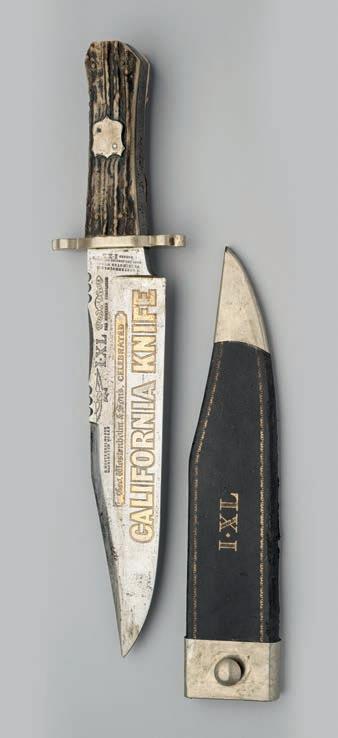
Literature
David Hayden-Wright, The Heritage of English Knives, Atglen, Pennsylvania, 2008, p. 280.
£400-500
646
A BOWIE KNIFE, GEORGE WOSTENHOLM & SON, WASHINGTON WORKS, SHEFFIELD, 20TH CENTURY with broad blade formed with a clippedback point, stamped with the maker’s details, ‘I.XL’, and ‘The real I.XL knife’, engraved with an eagle and etched with two captioned portraits (worn), recessed rectangular ricasso stamped ‘I.XL’, German silver guard, milled copper alloy fillets, polished horn scales and vacant German silver escutcheon, 24.3 cm blade
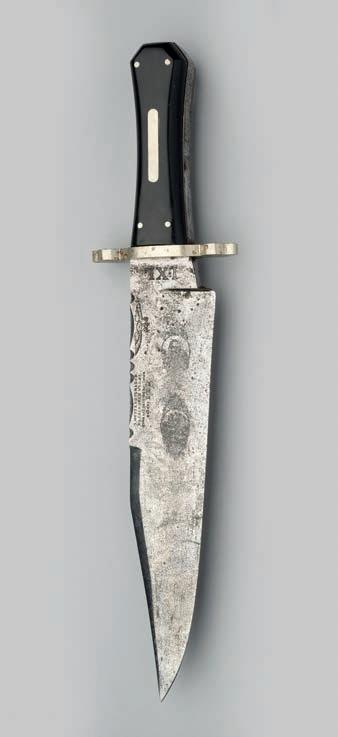
Literature
David Hayden-Wright, The Heritage of English Knives, Atglen, Pennsylvania, 2008, p. 281.
£500-600

644 646 645 59
647
A BOWIE KNIFE, G. WOSTENHOLM & SON, WASHINGTON WORKS, SHEFFIELD, EARLY 20TH CENTURY AND A DAGGER FOR THE AMERICAN MARKET, LATE 19TH CENTURY the first with broad blade formed with a long clipped point, signed on the back-edge, recessed rectangular ricasso marked ‘I.XL’, German silver guard, natural staghorn scales and vacant German silver escutcheon, in its tooled leather scabbard marked ‘I.XL’ in gilt letters; the second with tapering blade of flattened-diamond section, rectangular ricasso, German silver cross-piece with moulded terminals and natural staghorn scales, the first: 21.0 cm (2)

Literature
David Hayden-Wright, The Heritage of English Knives, Atglen, Pennsylvania, 2008, p. 287.

£450-500
648
A DAGGER, GEORGE WOSTENHOLM, SHEFFIELD, THIRD QUARTER OF THE 19TH CENTURY with doubled-edged broad blade, signed rectangular ricasso marked ‘I.XL’, German silver guard, and a pair of mother-of-pearl scales retained by four rivets, the outer with vacant German silver escutcheon, in its leather scabbard, 15.2 cm blade

Literature
David Hayden-Wright, The Heritage of English Knives, Atglen, Pennsylvania, 2008, p. 295.
£150-250
649
A BOWIE KNIFE, GEORGE WOSTENHOLM & SON, WASHINGTON WORKS, SHEFFIELD, NUMBER 4 OF 1,000 TO CELEBRATE THE 150TH ANNIVERSARY OF THE BATTLE OF THE ALAMO, 1986 with broad blade formed with a clipped-back point, stamped with the maker’s details, ‘I.XL’, ‘The Hunter’s Companion’, and ‘The real I.XL knife’, engraved with an eagle and with the makers name and ‘California Knife’ in part gilt letters, recessed rectangular ricasso stamped with the maker’s details in full, German silver guard, milled copper alloy fillets, natural staghorn scales and German silver escutcheon engraved ‘4/1,000’, in its fitted presentation case with certificate, the lid embossed ‘I. XL. In gilt letters on the outside, 24.0 cm blade
£500-600
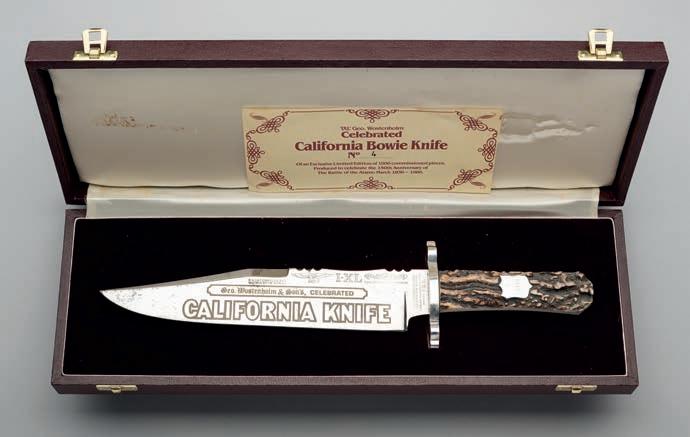
See page iii for Buyer’s Premium and other charges
60
647
648 649
LOCKWOOD BROTHERS, SHEFFIELD
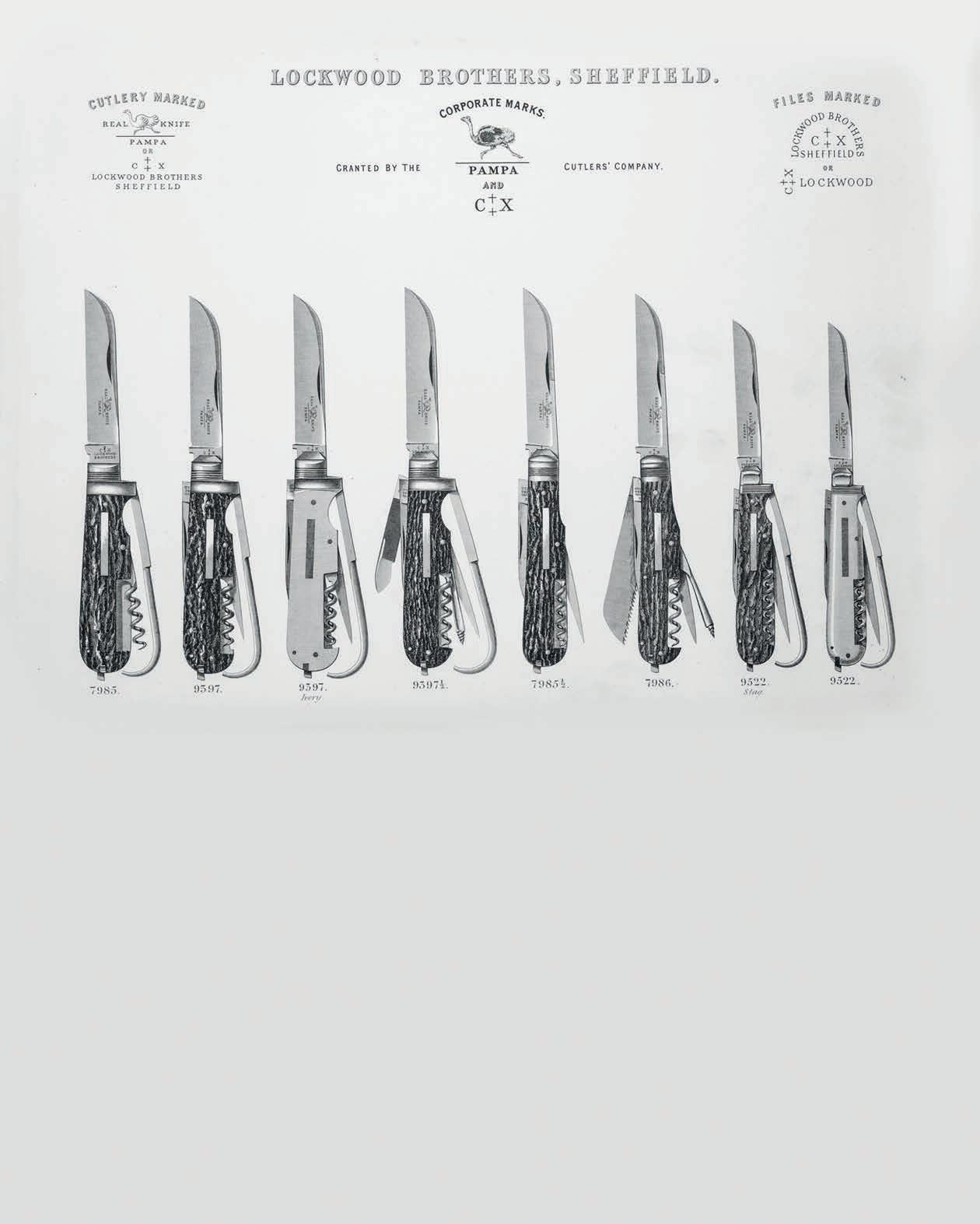
The apparent founder was John Lockwood of Ecclesfield, who was apprenticed to file maker John Burgin and became a Freeman in 1767, when he was assigned the mark ‘CX’. His two sons were John Lockwood Jun. (1769-1856) and William Lockwood (1775-1829). The latter moved to Sheffield in the 1790s and, in 1803, married Ann Sorby, linking his family to the local tool making dynasty. They had four sons, William (1806-1873), John (1813-1876), Joseph (1815-1902), and Charles (1822-1872). In 1817, Lockwood & Sorby are recorded as factors in Arundel Street and merchants and file manufacturers in 1822. William died in 1829 and his four sons, who became the ‘Lockwood brothers’ ultimately continued the business, first recorded 1837. In 1861 Lockwoods employed 500 staff and in 1865 they expanded their premises at Arundel Street. The enterprise became more closely involved in cutlery and trade catalogues show a wide range of knives and pocket cutlery with an emphasis on complicated sportsman’s patterns, hunting and skinning knives. By 1862 German counterfeiting had forced the company to adopt another mark: a Pampas rhea with the words ‘REAL KNIFE’ and ‘PAMPA’. The firm’s main trade mark was ‘C:X’. Lockwood’s also acquired a Maltese cross ‘L’ mark. Three of the Lockwood brothers died in the early 1870s: Charles (1872), William (1873), and John (1876). Joseph continued the business and around 1891 they became a limited company. By the First World War, Lockwood’s was in decline and losing money, in 1919 it became part of Sheffield Cutlery Manufacturers Ltd and was acquired by Elliott in 1927. Abbreviated from Tweedale 2019 and Hawley 2023.

61
650
A FINE AND RARE LARGE FOLDING KNIFE FOR EXHIBITION, LOCKWOOD BROTHERS, SHEFFIELD, MID-19TH CENTURY with two burnished broad folding blades, each double-edged over the upper portion, formed with a scalloped back-edge, stamped ‘Lockwood Brothers’ divided by an engraved running rhea above ‘Pampa’ on one face, stamped ‘Lockwood Brothers Sheffield’ at the base and with the letters ‘CX’ divided by a pair of vertically arranged crosses (small areas of staining), finely milled gilt liners and spring backs, highly figured exotic hardwood chamfered scales retained by seven rivets with German silver caps, one inlaid with the maker’s name ‘Lockwood Brothers’ divided by a running rhea above the letters ‘Pampa’, with finely milled and engraved German silver terminals decorated with scrolls and foliage, those at the pivot end with a vacant panel, perhaps for the date, on each face, and remaining in fine condition throughout, 40.5 cm (closed)

Literature
David Hayden-Wright, The Heritage of English Knives, Atglen, Pennsylvania, 2008, p. 77.
Stated to have been made for the 1851 Great Exhibition and shown at thirty one subsequent cutlery exhibitions until 1905. £3,000-4,000

650 See page iii for Buyer’s Premium and other charges 62
651
~
A FINE AND RARE LARGE FOLDING KNIFE FOR EXHIBITION, LOCKWOOD BROTHERS, SHEFFIELD, SECOND HALF OF THE 19TH CENTURY
with seventeen folding blades and implements, including three blades stamped ‘Lockwood Brothers’ divided by an engraved running rhea above ‘Pampa’, stamped ‘Lockwood Brothers Sheffield’ at the base and with the letters ‘CX’ divided by a pair of vertically arranged crosses, button hook, saw, awl, bodkin and gauge, ivory scales (small chips) retained by six rivets with German silver caps, one face with vacant shield-shaped escutcheon, German silver terminals and remaining in fine condition throughout, 21.2 cm (closed)

Literature

651
David Hayden-Wright, The Heritage of English Knives, Atglen, Pennsylvania, 2008, p. 80. A UK Ivory Act 2018 certificate for this lot will be made available to the purchaser. £2,000-3,000 63
652
A MULTI-BLADE PENKNIFE FOR EXHIBITION

with over one hundred folding blades and accessories including awls, borers, saws, corkscrews, tweezers, scissors, pincers, scribes, bodkins, needles, nail files, bradawls, and spanners, fitted at each side with mother-of-pearl scales (small cracks) retained by five minute screws and with elaborately writhen German silver borders at the top and bottom, 12.0 cm (closed)
Provenance
The directors of Lockwoods, Sheffield.
Literature
David Hayden-Wright, The Heritage of English Knives, Atglen, Pennsylvania, 2008, p. 73 £2,000-3,000

See page iii for Buyer’s Premium and other charges 64
652
~ 653
A SALESMAN’S DISPLAY OF TWENTY-FIVE POCKET KNIVES, LOCKWOOD BROTHERS, SHEFFIELD, LATE 19TH/EARLY 20TH CENTURY
each struck with the maker’s details at the ricasso, comprising twenty-one with ‘Real Pampa’ blades; four with natural staghorn scales, eleven with polished horn scales, one with ivory scales, one with brass scales stamped ‘Goldfinger knife’ and the remainder with hardwood scales, mounted on board with stock numbers in ink and makers details in gilt letters, with cover, 43.0 x 35.0 cm
Literature
David Hayden-Wright, The Heritage of English Knives, Atglen, Pennsylvania, 2008, p. 196.
£500-700
~ 654
A SALESMAN’S DISPLAY OF TWENTY-SIX POCKET KNIVES, LOCKWOOD BROTHERS, SHEFFIELD, LATE 19TH/EARLY 20TH CENTURY
each struck with the maker’s details at the ricasso, comprising four with ‘Real Pampa’ blades; four with German silver scales, eighteen with ivory or ivorine scales, two with coloured enamel scales and two with tortoiseshell scales, mounted on board with stock numbers in ink and the makers details in gilt letters, with cover, 43.0 x 35.0 cm
Literature
David Hayden-Wright, The Heritage of English Knives, Atglen, Pennsylvania, 2008, p. 197.
A UK Ivory Act 2018 certificate for this lot will be made available to the purchaser
£400-500
~ 655
A SALESMAN’S DISPLAY OF TWENTY-FOUR POCKET KNIVES, LOCKWOOD BROTHERS, SHEFFIELD, LATE 19TH/EARLY 20TH CENTURY
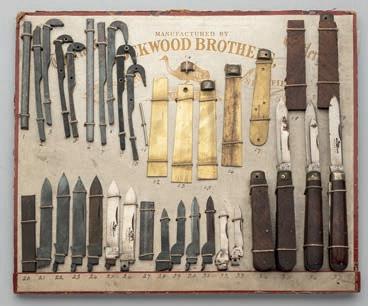
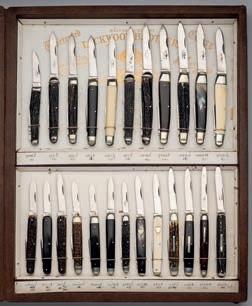


each struck with the maker’s details at the ricasso, comprising thirteen with ‘Real Pampa’ blades; twelve with natural staghorn scales, seven with polished horn scales, three with ivory scales, one two with hardwood scales, mounted on board with stock reference numbers in ink and makers details in gilt letters, with cover, 43.0 x 35.0 cm
Literature
David Hayden-Wright, The Heritage of English Knives, Atglen, Pennsylvania, 2008, p. 199.
£400-600
656
A DISPLAY BOARD FOR THE MANUFACTURE OF A TWO-BLADE POCKET KNIFE ‘PAMPA’, LOCKWOOD BROTHERS, LAST QUARTER OF THE 19TH CENTURY, formed of a paper-covered board inscribed in gilt letters with the manufacturer’s details, displaying the thirty-seven stages of manufacture, comprising the two spring bars each in five stages, spear and pen blades each in seven stages, bolsters, brass fillets and final assembly in five stages, consecutively numbered in ink, 30.5 cm x 25.5 cm
Literature
David Hayden-Wright, The Heritage of English Knives, Atglen, Pennsylvania, 2008, p. 69.
£300-400

653 654 655 656 65
657
FIVE LOCK KNIVES BY LOCKWOOD BROTHERS, SHEFFIELD, LATE 19TH CENTURY, A FIGHTING KNIFE AND THREE FURTHER POCKET KNIVES

the first five with ‘Real Pampa’ blades, three with natural staghorn scales, one with polished horn scales and one with hardwood scales; the sixth with folding locking blade signed ‘Taylor’ and ‘Real Knife Witness’, German silver double quillons and natural staghorn scales, and three further pocket knives with natural staghorn scales, the first: 12.8 cm (closed) (10)



Literature
David Hayden-Wright, The Heritage of English Knives, Atglen, Pennsylvania, 2008, p. 243.

£400-500
658
THREE POCKET KNIVES, LOCKWOOD BROTHRS, SHEFFIELD, LATE 19TH/EARLY 20TH CENTURY AND THIRTEEN FURTHER POCKET KNIVES
the first two marked ‘Real Pampa’, signed at the ricasso and with CX’ mark; the third similar, with additional folding blade; five folding knives by Joseph Elliott & Sons, with signed blades and natural staghorn scales; another by the same maker with two folding blade and another smaller knife by the same maker; two by Allen & Son; and four further pocket knives, the first: 10.8 cm (closed) (16)
Literature
David Hayden-Wright, The Heritage of English Knives, Atglen, Pennsylvania, 2008, p. 114.
£350-450
659
A PRUNING KNIFE, LOCKWOOD BROTHERS, SHEFFIELD, LATE 19TH EARLY 20TH CENTURY AND SIXTEEN FURTHER PRUNING AND OTHER KNIVES
the first with folding ‘Real Pampa’ blade with makers details and stamps at the forte and natural staghorn scales (one flattened, perhaps for display); thirteen further pruning knives, and three pocket knives by various makers; the first: 11.0 cm (closed) (17)
£250-300
660
FOUR BUTLER’S KNIVES, LOCKWOOD BROTHERS, SHEFFIELD, 19TH CENTURY AND FOUR FURTHER KNIVES
the first four with two folding blades of differing size, signed at the ricasso, a further small hooked blade, corkscrew, and nickel bodies engraved with a rhea and ‘Real Pampa’; another Joseph Elliott; another, John Petty; another, Allen & Son, and a locking knife with nickel body, Joseph Rodgers & Sons, no. 6 Norfolk Street Sheffield, the first: 10.5 cm (closed) (8)
Literature
David Hayden-Wright, The Heritage of English Knives, Atglen, Pennsylvania, 2008, p. 139.
£200-300
See page iii for Buyer’s Premium and other charges 657 658 659 660 66
661
THREE PENKNIVES, LOCKWOOD BROTHERS, SHEFFIELD, LATE 19TH CENTURY AND FIVE FURTHER KNIVES


the first with five folding elements including pick and awl, and natural staghorn scales; the second marked ‘Real Pampa’ and with six folding elements; the third with three folding elements including tuning fork and pincers, the fourth smaller, with four folding elements; the fifth and sixth Allen & Sons, the seventh, Petty, with five folding elements; and the eighth, Joseph Elliott, with two blade and staghorn scales, the first: 8.7 cm (closed) (8)
Literature
David Hayden-Wright, The Heritage of English Knives, Atglen, Pennsylvania, 2008, p. 138.
£200-300
662
SIX POCKET KNIVES, LOCKWOOD BROTHERS, SHEFFIELD, LATE 19TH CENTURY AND TWELVE FURTHER POCKET KNIVES, the first to fourth with three folding blades marked ‘Real Pampa’ and with polished horn scales; the fifth and sixth with a single folding ‘Real Pampa’ blade and natural staghorn bodies; the seventh to tenth, Joseph Elliott, with staghorn bodies; and eight further pocket knives, various makers, the first: 10.5 cm (18)
Literature
David Hayden-Wright, The Heritage of English Knives, Atglen, Pennsylvania, 2008, p. 158.
£200-300
~ 663
A SMALL PENKNIFE, LOCKWOOD BROTHERS, SHEFFIELD, LATE 19TH CENTURY, AND TWENTY-ONE FURTHER SMALL PENKNIVES


the first with signed folding ‘Real Pampa’ main blade, two further folding accessories, and German silver-mounted staghorn scales; the second by the same, with four folding blades and tortoiseshell scales; a premium stock knife, George Wostenholm, Sheffield, with three folding elements, in associated box; two fruit knives, Brookes & Crookes, Sheffield, with folding blades and mother-ofpearl scales, and seventeen further small penknives, the first: 9.0 cm (closed) (22)
£200-300
661
662
67
663
664
FIVE PRUNING KNIVES, LOCKWOOD BROTHERS, SHEFFIELD, AND NINETEEN FURTHER PRUNING KNIVES, LATE 19TH/EARLY 20TH CENTURY
with natural staghorn scales, the first and second with two folding blades, the larger marked ‘Real Pampa’; the third, fourth and fifth with single folding ‘Real Pampa’ blade; the sixth, Lockwood Sons, with single folding blade; five large pruning knives, Allen & Son, Sheffield; six smaller pruning knives, Allen & Son, Sheffield; another by the same, with two blades; and six further pruning knives, the first: 9.8 cm (closed) (24)


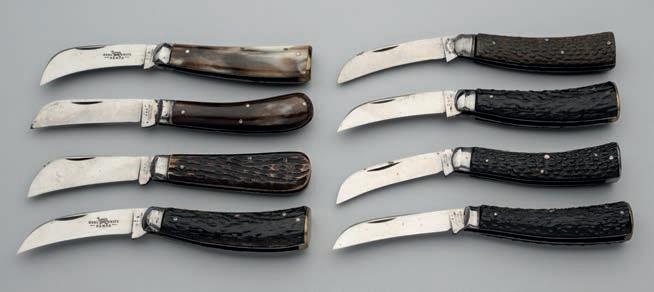
Literature
David Hayden-Wright, The Heritage of English Knives, Atglen, Pennsylvania, 2008, p. 160.
£300-400
665
TWO PRUNING KNIVES, LOCKWOOD BROTHERS AND SIX FURTHER PRUNING KNIVES, SHEFFIELD, LATE 19TH/EARLY 20TH CENTURY
with folding blades, the first two marked ‘Real Knife Pampa’ and with rhea on one face, struck with the maker’s details, ‘CX’ and cross marks at the ricasso, and with polished and natural staghorn scales respectively; the third to sixth similar, by Joseph Elliott & Sons, with natural staghorn scales; the seventh by W. Saynor Ltd and the eighth by Allen & Scott, the first: 9,.5 cm (closed) (8)
Literature
David Hayden-Wright, The Heritage of English Knives, Atglen, Pennsylvania, 2008, p. 112.
£150-200
666
TWO PRUNING KNIVES, LOCKWOOD BROTHERS AND SEVEN FURTHER PRUNING KNIVES, SHEFFIELD, LATE 19TH/EARLY 20TH CENTURY
with folding blades, the first marked ‘Real Knife Pampa’ and with rhea on one face, struck with the maker’s details, ‘CX’ and cross marks at the ricasso, and with natural staghorn scales; the second with the maker’s details, ‘CX’ and cross marks at the ricasso and polished horn scales; the third by Joseph Elliott; the fourth and fifth by Allen & Son; the sixth by Alexander Birmingham, with barrel mark; the seventh with barrel mark; the eight and ninth by Thomas Turner & Co., the blades and chequered scales marked ‘Encore’, the first: 10.5 cm (closed) (9)
Literature
David Hayden-Wright, The Heritage of English Knives, Atglen, Pennsylvania, 2008, p. 112.
£150-200
 666 664
666 664
See page iii for Buyer’s Premium and other charges 68
665
THREE THREE-BLADED FLEAMS, LOCKWOOD BROTHERS, SHEFFIELD, 19TH CENTURY AND TEN FURTHER FLEAMS
the first three with three ‘Real Pampa’ folding blades and brass scales; two two blade fleams, by the same with ‘Real Pampa’ blades and horn scales; two single-blade fleams by the same with horn scales; two three blade fleams, Joseph Rodgers & Sons, 6 Norfolk St, Sheffield, with brass scales; three further fleams by the same, with horn scales, a small fleam, J. Gibbins, with tortoiseshell scales, and another, P. Salt, with horn scales, the first: 7.8 cm (14)
Literature
David Hayden-Wright, The Heritage of English Knives, Atglen, Pennsylvania, 2008, pp. 162.
£150-200
668
THREE SMOKERS POCKET KNIVES, LOCKWOOD BROTHERS AND ANOTHER, EARLY 20TH CENTURY
the first with four folding elements including ‘Real Pampa’ blade with trademark, button hook and corkscrew, nickel-silver body marked ‘Real Pampa’; the second and third with four folding elements including pricker and nickel-silver bodies; and the fourth similar, by Joseph Elliott and Sons, Sheffield, the first: 7.8 cm (closed) (4)
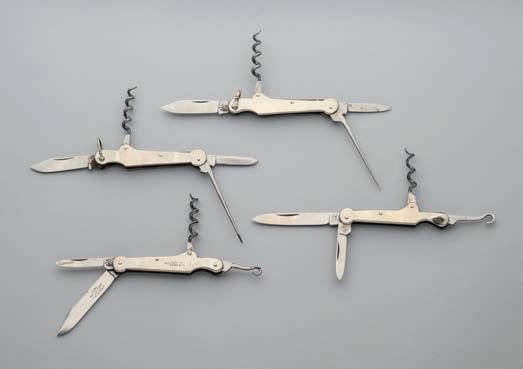

Literature
David Hayden-Wright, The Heritage of English Knives, Atglen, Pennsylvania, 2008, p. 140.
£120-150
669
THREE MOTHER-OF-PEARL MOUNTED SMALL POCKET KNIVES, LOCKWOOD BROTHERS; SEVEN FURTHER MOTHER-OF-PEARL MOUNTED POCKET KNIVES AND SIX POCKET KNIVES WITH GERMAN SILVER BODIES


the first three of differing size, each with folding ‘Real Pampa’ blade signed at the ricasso, and mother-of-pearl scales; the fourth and fifth similar, Joseph Rodgers, no. 6 Norfolk Street, Sheffield; five further pocket knives, similar; a smoker’s pocket knife, Lockwood brothers, with German silver body, five further smoker’s pocket knives and another pocket knife, in its leather pouch, the first: 9.2 cm (closed) (16)
Literature
David Hayden-Wright, The Heritage of English Knives, Atglen, Pennsylvania, 2008, p. 183.
£200-220
~ 667
669 69
667 668
670
A BOWIE KNIFE, LOCKWOOD BROTHERS, SHEFFIELD, LATE 19TH/20TH CENTURY with single-edged blade formed with a false swage at the point, stamped with the maker’s details and the letters CX divided by a double cross, German silver hilt comprising shaped cross-piece and grip cast with neo rococo designs in low relief, 28.8 cm blade

Literature
David Hayden-Wright, The Heritage of English Knives, Atglen, Pennsylvania, 2008, p. 257.
£500-700
671
A DECORATED PAIR OF SCISSORS FOR EXHIBITION, LOCKWOOD BROTHERS, SECOND HALF OF THE 19TH CENTURY AND SIX SMALLER DECRATED SCISSORS
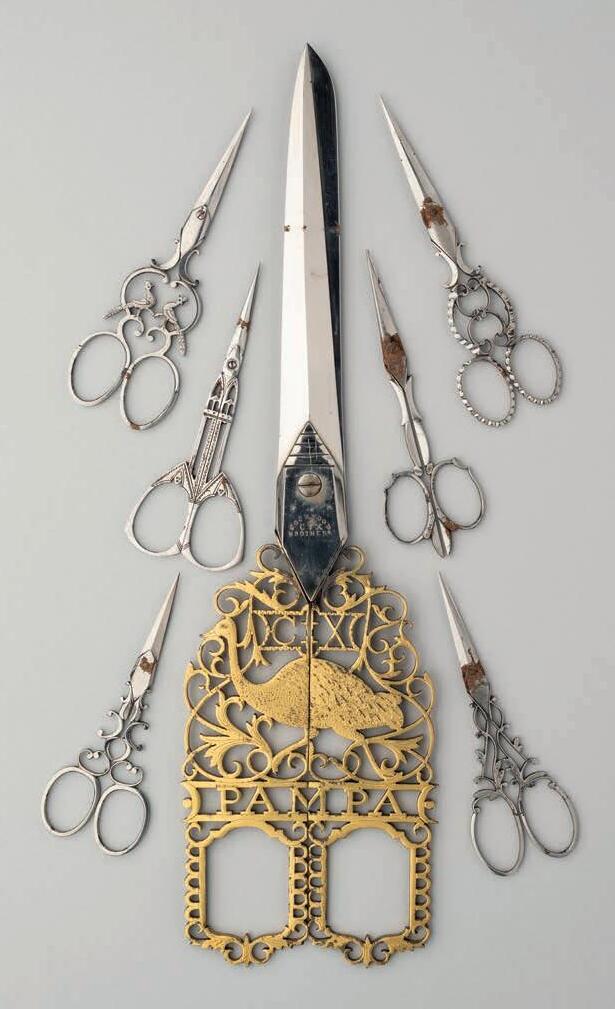
the first with highly polished blades signed by the maker and marked ‘CS’ on one ricasso, gold-bladed grips decorated with a pierced and engraved panel featuring the trademark letters ‘CX’, a rhea and ‘Pampa’ and remaining in fine condition (one small area of surface rust); the remaining scissors for sewing, of delicate construction, one decorated with a pair of birds, one with tracery, and four with designs of scrolls, the first: 28.5 cm overall (7)
Literature
David Hayden-Wright, The Heritage of English Knives, Atglen, Pennsylvania, 2008, p. 86.
£1,200-1,800

See page iii for Buyer’s Premium and other charges
670 671
70
672
LOCKWOOD BROTHERS, SHEFFIELD, CATALOGUE, CIRCA 1890, ANOTHER, DATED 1923 AND ANOTHER, MID-20TH CENTURY the first comprising fifty seven plates with printed board covers (worn); the second comprising one hundred illustrated pages, paper covers; the third comprising two hundred and six illustrated pages, paper covers, together with three printing blocks from a Lockwood brothers catalogue and a retailers sign ‘We Stock Lockwood’s Pampa Cutlery’ (7)
Literature
David Hayden-Wright, The Heritage of English Knives, Atglen, Pennsylvania, 2008, p. 206 (the printing blocks).

£400-600

672
71
673
A LOCK KNIFE AND SEVEN PENKNIVES, ALLEN & SON, SHEFFIELD, LATE 19TH CENTURY, AND FOUR FURTHER KNIVES the first with locking blade, natural staghorn scales and German silver escutcheon; the second with five folding elements including button hook, awl and corkscrew and tweezers and pricker; third, fourth and fifth smaller, with staghorn scales, one with six elements including a saw; the sixth, seventh and eight with chequered scales, one with eight elements, one with six elements; the ninth a pruning knife; two staghorn-mounted knives, Joseph Elliott, Sheffield and two further knives, the first: 16.0 cm (closed) (12)
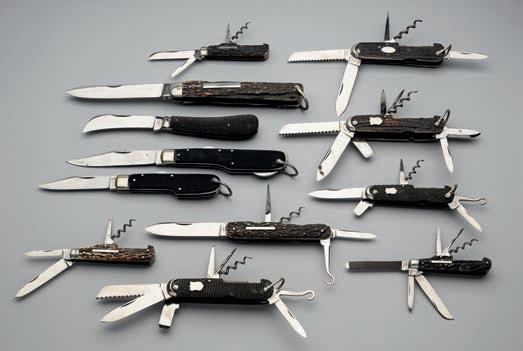
Literature
David Hayden-Wright, The Heritage of English Knives, Atglen, Pennsylvania, 2008, p. 137.
£350-450
674
A SALESMAN’S DISPLAY OF THIRTEEN POCKET KNIVES, I. & J. BARBER, SHEFFIELD, CIRCA 1920-8 comprising thirteen knives with folding blades, marked ‘ERA’ and with the maker’s details at the ricasso, and with differing brightly coloured scales, mounted on a green board with stock reference numbers in ink, maker’s details and ‘E.R.A.’ in gilt letters, complete with cover flap (taped repair) and receipt dated 1928; together with three further pocket knives, the first board: 36.5 cm x 24.5 cm
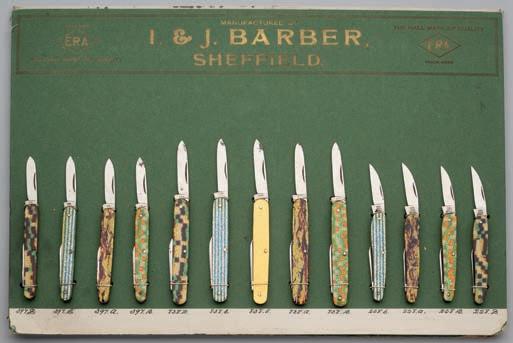
Literature
David Hayden-Wright, The Heritage of English Knives, Atglen, Pennsylvania, 2008, p. 192.
£150-200
675
A BOWIE KNIFE, EDWARD BARNES & SONS, LATE 19TH CENTURY

with single-edged blade formed with a clipped-back point, etched on one face with the maker’s details on a scroll, ‘The United States, Land of the Free and the Home of the Brave protected by Her Noble and Brave Volunteers’ and with the Federal eagle (worn), German silver hilt comprising oval guard and solid grip cast with scrolls and an eagle charged with a shield, in its tooled and gilt red leather scabbard with German silver mounts, 22.7 cm blade
Literature
David Hayden-Wright, The Heritage of English Knives, Atglen, Pennsylvania, 2008, p. 290.
£400-500

673 674 675 See page iii for Buyer’s Premium and other charges 72
676
A MILITARY FOLDING LOCK KNIFE, BRIGGS, BENNETT AND NEWTON, SHEFFIELD, CIRCA 1880-90 with folding locking blade stamped with the maker’s details at the ricasso, formed with a clipped-back point, brass fillets, chequered scales, German silver blade locking stud, in its leather scabbard with belt loop, 21.0 cm blade



Literature
David Hayden-Wright, The Heritage of English Knives, Atglen, Pennsylvania, 2008, p. 220.
£200-250
677
A MILITARY FOLDING LOCK KNIFE, G. BUTLER & CO, SHEFFIELD, CIRCA 1880-90
with folding locking blade stamped with the maker’s details at the ricasso, formed with a clipped-back point, a pair of folding wavy German silver double quillons, brass fillets, chequered scales, German silver blade release stud, in its leather scabbard (belt loop detached) embossed with the maker’s details, 18.5 cm blade
Literature
David Hayden-Wright, The Heritage of English Knives, Atglen, Pennsylvania, 2008, p. 220.
£200-300
678
A MILITARY FOLDING LOCK KNIFE, G. BUTLER & CO, SHEFFIELD, CIRCA 1882-90
with folding locking blade stamped with the maker’s details and key mark at the ricasso, formed with a clipped-back point, a pair of folding German silver double quillons, milled brass fillets, chequered scales, German silver blade release stud, in its leather scabbard with belt loop and copper alloy chape, 19.3 cm blade George Butler & Co. acquired the key mark from Steer & Webster circa 1882.

£200-250
679
A BOWIE KNIFE, GEORGE BUTLER & CO, TRINITY WORKS, SHEFFIELD AND ANOTHER R. S. RICHARDSON & CO. EDINBRGH, CIRCA 1880-90
the first with single-edged blade formed with a clipped-back point, stamped with the maker’s details on one face, rectangular ricasso, German silver hilt shaped for the fingers including straight guard and moulded pommel, and chequered horn grips shaped for the fingers, in its leather scabbard with belt loop; the second with clipped-back blade signed on one face, shaped German silver guard and chequered scales, in its leather scabbard, the first: 17.5 cm blade (2)
Literature
David Hayden-Wright, The Heritage of English Knives, Atglen, Pennsylvania, 2008, p. 282.
£400-500

676 677 678 679
73
680
A MOTHER-OF-PEARL MOUNTED SILVER FRUIT KNIFE, J. DEAKIN & SONS, SHEFFIELD, 1834 AND FIFTEEEN FURTHER SMALL FOLDING KNIVES, 19TH/EARLY 20TH CENTURY

the first with folding silver blade and fork, the former signed, German silver fillets, and mother-of-pearl scales; another, with five folding elements and mother-of-pearl scales inscribed ‘Mark Shaw & Sons Ltd, Engineers Huddersfield’; a small multiblade folding knife, with over fifteen folding blades and accessories including scissors, fork, button hook, blades, saw and awl, and mother-of-pearl scales; seven small silver folding fruit knives with mother-of-pearl scales; another, with silver scales and buff leather case; a silver folding button hook; and five further small multi-blade folding knives with mother-ofpearl scales, the first: 8.0 cm (closed) (16)

Literature
David Hayden-Wright, The Heritage of English Knives, Atglen, Pennsylvania, 2008, p. 127.
£200-300
681
A BOWIE KNIFE, ‘EXPLORATEUR’, JAMES DIXON & SONS, SHEFFIELD with broad blade formed with a clippedback point, stamped ‘Explorateur’ within a long fuller on one face and with the maker’s details at the ricasso, German silver guard with recurved quillons and faceted block, finely chequered ebony pistol grip and German silver button, 27.5 cm blade
Literature
David Hayden-Wright, The Heritage of English Knives, Atglen, Pennsylvania, 2008, p. 272.
£400-500
682
A BALDOCK PATENT SPEAR KNIFE, JAMES DIXON & SONS LTD, SHEFFIELD with robust fullered blade double-edged towards the point, formed with a saw-back and signed on one face at the ricasso and stamped ‘BALDOCK KNIFE SPEAR/MADE EXPRESSLY FOR /WALTER LOCKE & CO LTD/ PATENTED’ on the other (rubbed), silvered copper alloy cross-piece, cylindrical iron grip with lateral slots, an internal spike and chequered collar for attachment to a haft, and turned wooden pommel, in its German silver-mounted leather scabbard, 24.5 cm blade
Literature
David Hayden-Wright, The Heritage of English Knives, Atglen, Pennsylvania, 2008, p. 228.
Major Charles Blair Baldock, an officer in the Indian Army, patented this knife on 12 June 1902, patent no. 8623. Another example is preserved in the Royal Armoury, Leeds (coll. No. X.1765).
£300-400

See page iii for Buyer’s Premium and other charges 680
74
681
683
A BALDOCK PATENT SPEAR KNIFE, JAMES DIXON & SONS LTD, SHEFFIELD with robust fullered blade double-edged towards the point (tip chipped), formed with a saw-back and signed on one face at the ricasso and stamped ‘BALDOCK KNIFE SPEAR/MADE EXPRESSLY FOR/WALTER LOCKE & CO LTD/ PATENTED’, silvered copper alloy cross-piece, cylindrical iron grip with lateral slots, an internal spike and chequered collar for attachment to a haft, in its leather scabbard with belt loop 23.0 cm blade
Literature
David Hayden-Wright, The Heritage of English Knives, Atglen, Pennsylvania, 2008, p. 228

See footnote to lot 682.
£200-250
684
A BOWIE KNIFE, T. ELLIN & CO., SHEFFIELD, 20TH CENTURY with straight blade formed with a clipped-back point and filed back-edge, etched ‘I Never Fail’ in large capital letters on one face, signed recessed rectangular ricasso, shaped steel guard, and blackbuck grip with steel pommel, in its leather scabbard with iron locket and belt loop, 25.0 cm blade



Literature
David Hayden-Wright, The Heritage of English Knives, Atglen, Pennsylvania, 2008, p. 294.
£500-700
685
A DAGGER, JOSEPH ELLIOTT & SONS, SHEFFIELD, LATE 19TH CENTURY with wavy blade formed with a long fuller on each face, etched with a native American figure, ‘Trade Mark’, ‘Self Defence’ and signed (worn), German silver guard formed with a wavy edge, chased ferrule, and tapering grip inlaid with mother-of-pearl in large German silver frames, in its green velvet-covered scabbard with engraved silver mounts, 15.0 cm blade
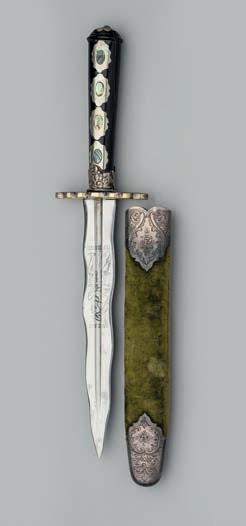
Literature
David Hayden-Wright, The Heritage of English Knives, Atglen, Pennsylvania, 2008, p. 291.
£300-400
~ 686
A SALESMAN’S DISPLAY OF SEVENTEEN POCKET KNIVES, JOSEPH ELLIOTT & SONS, SHEFFIELD, LATE 19TH/EARLY 20TH CENTURY each with three folding blades, struck with the maker’s details including Allen & Son at the ricasso, comprising nine with ivory scales, three with tortoiseshell scales, four with mother-of-pearl scales and one with natural staghorn scales, mounted on board with stock reference numbers in ink and the makers details, with cover labelled ’card no. 4, fine 3 blades’, 35.5 cm x 23.5 cm
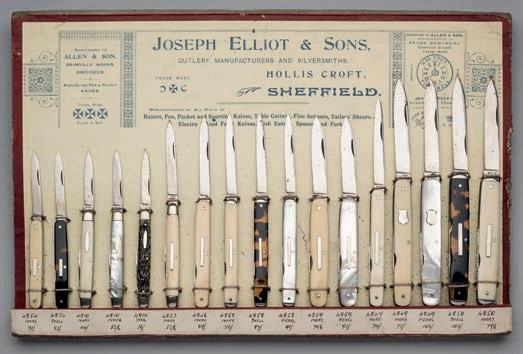
Literature
David Hayden-Wright, The Heritage of English Knives, Atglen, Pennsylvania, 2008, p. 205.
A UK Ivory Act 2018 certificate for this lot will be made available to the purchaser
£400-600
686 75
682 683 684 685
687
A DAGGER, MARKED MAZEPPA, PROBABLY SAMUEL HANCOCK & SONS, LATE 19TH CENTURY with broad blade formed with a clippedback point, recessed ricasso struck with a figure strapped to a horse’s back and ‘Mazeppa’ on one face, German silver hilt cast in low relief, comprising guard and pommel decorated with scrolls, milled copper alloy fillers and hardwood scales, in its tooled and gilt leather scabbard,17.2 cm blade
Literature
David Hayden-Wright, The Heritage of English Knives, Atglen, Pennsylvania, 2008, p. 291.
The Mazeppa mark refers to Ivan Mazeppa, a historical Cossack figure in Ukraine, who had been bound naked to a horse’s back as a punishment for adultery. Samuel Hancock (circa 1795-1854), a cutlery manufacturer in Pea Croft, Sheffield, was granted this mark in 1849. In 1896 the company and its mark passed to Reuss & Co. Abbreviated from Tweedale 2019 and Hawley 2023.

£400-500
688
A SOUTH AMERICAN GAUCHO BOWIE KNIFE, MARKED MAZEPPA, SAMUEL HANCOCK & SONS, MID-19TH CENTURY with sharply tapering blade double-edged towards the point and with filed mouldings along the back-edge, struck with a figure strapped to a horse’s back and ‘Mazeppa’ on one face, white metal hilt cast with neo rococo ornament and a serpent in low relief, in its German silvermounted leather scabbard, 24.0 cm blade



See footnote to lot 687.
£350-400
689
A DAGGER, HARRISON BROS & HOWSON, SHEFFIELD, EARLY 20TH CENTURY AND ANOTHER, SIMILAR, FRENCH, SABATIER, 20TH CENTURY the first with broad blade double-edged towards the point, signed ricasso, German silver hilt cast in low relief comprising guard and scalloped pommel, and chequered scales, in its leather scabbard; the second similar, with signed blade and hardwood scales, the first: 15.2 cm blade (2)
Literature
David Hayden-Wright, The Heritage of English Knives, Atglen, Pennsylvania, 2008, p. 291.
£300-400
687
688
See page iii for Buyer’s Premium and other charges 76
689
690
A BOWIE KNIFE, HARRISON BROTHERS AND HOWSON, CUTLERS TO HER MAJESTY, LATE 19TH CENTURY AND A SMALL BOWIE DIRK, J. RODGERS & SONS, NO. 6 NORFOLK ST, SHEFFIELD, 20TH CENTURY
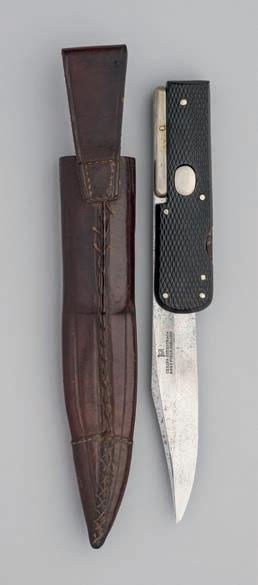

the first with single-edged blade formed with a clipped-back point, struck with the maker’s details and the royal letters ‘VR’ divided by a crown on one face, recessed rectangular ricasso, and chequered grips, in its leather scabbard with belt loop; the second with broad blade with a clipped-back point, struck with the maker’s details, the royal letters ‘ER’ divided by a crown and star and cross mark at the ricasso, 16.5 cm blade (2)
Literature
David Hayden-Wright, The Heritage of English Knives, Atglen, Pennsylvania, 2008, p. 270.
£200-250
691
A DAGGER, JOSEPH HAYWOOD, GLAMORGAN WORKS, SHEFFIELD, LATE 19TH CENTURY with broad double-edged blade etched with foliage on one face, rectangular ricasso struck with the maker’s details on one face and mark, a kettle, on the other, copper alloy guard and cap pommel and natural staghorn grip, in its leather scabbard, 21.0 cm blade

Literature
David Hayden-Wright, The Heritage of English Knives, Atglen, Pennsylvania, 2008, p. 284.

£200-300
692
A MASONIC DAGGER, HOBSON, LATE 19TH CENTURY with double-edged blade etched with a pair of compasses and a set square in an oval on one face, signed ricasso, and German silver hilt including grip cast with scrolls and foliage, in its tooled and gilt leather scabbard, 18.0 cm blade

Literature
David Hayden-Wright, The Heritage of English Knives, Atglen, Pennsylvania, 2008, p. 290.
£200-300
693
A MILITARY FOLDING LOCK KNIFE, CHRIS JOHNSON & CO, SHEFFIELD, CIRCA 1880-90 with folding locking blade stamped with the maker’s details on one face, formed with a clipped-back point, a pair of folding German silver double quillons, brass fillets, chequered scales, German silver blade locking stud, in its leather scabbard belt loop, 18.4 cm blade
Literature
David Hayden-Wright, The Heritage of English Knives, Atglen, Pennsylvania, 2008, p. 220.
£200-250
690 691 692 693 77
694
A SMALL BOWIE KNIFE, KILNER BROTHERS, SHEFFIELD AND TWO FURTHER BOWIE KNIVES, LATE 19TH CENTURY the first with single-edged blade formed with a clipped-back point, signed rectangular recessed ricasso, oval white metal guard, and turned painted wooden grip decorated with flowers; the second signed John Watts, Sheffield, with leather-wrapped grip, in its tooled leather scabbard; and the third etched ‘never draw me without reason nor sheath without honour’ on the blade, turned blackened grip, in its scabbard; the first: 15.2 cm blade (3)


Literature
David Hayden-Wright, The Heritage of English Knives, Atglen, Pennsylvania, 2008, p. 282.

£200-300
695
A SMALL DAGGER, ROBERT LINGARD, SHEFFIELD, LATE 19TH/EARLY 20TH CENTURY AND TWO FURTHER SMALL DAGGERS the first with tapering double-edged blade decorated with scrolls and the inscription ‘Never Draw me without reason nor sheath me without honour’, German silver hilt comprising oval guard and integral grip cast with scrolls in low relief, in its tooled leather scabbard with German silver mounts; the second of similar form, with plain blade signed Lingard, Peacroft on the ricasso, and German silver hilt cast with scrolls; and the third with leaf-shaped blade signed Southern and Richardson, Sheffield, cast German silver hilt, and associated scabbard, the first: 15.4 cm blade (3)
Literature
David Hayden-Wright, The Heritage of English Knives, Atglen, Pennsylvania, 2008, p. 290.
£500-700
696
A RARE LINGARD PATENT SPRING-KNIFE, CIRCA 1860 with tapering blade retaining some stamped inscription including ‘February 9th 1850’, ricasso stamped ‘Lingard, Peacroft Sheffield, secondary blade stamped en suite, German silver fillets, mother-ofpearl scales each retained by five rivets, and embossed German silver cross-guard and pommel each decorated with scrolls and foliage, in its leather scabbard with belt loop, 13.5 cm (closed)
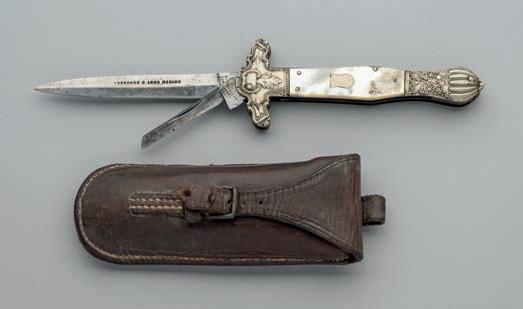
Literature
David Hayden-Wright, The Heritage of English Knives, Atglen, Pennsylvania, 2008, p. 130.
Robert Lingard was born around 1798 and is recorded as a spring knife maker first at Wharncliffe Side and at Peacroft from around 1850.
£400-600
694 695 696 See page iii for Buyer’s Premium and other charges 78
697
A BOWIE KNIFE, LINGARD, PEACROFT, SHEFFIELD, PROBABALY
1870
with single-edged blade formed with a clipped-back point and part swaged back-edge, rectangular ricasso stamped ‘Lingards Celebrated Bowie Knife Pea Croft, Sheffield’, German silver hilt comprising two-piece guard and pommel each cast with scrolls and foliage in low relief, brass fillets, staghorn scales, and vacant German silver escutcheon, 21.0 cm blade
See footnote to lot 696.
£300-500
698
A MOTHER-OF-PEARL MOUNTED DIRK, JAMES MACHIN, CIRCA 1830-37


with wavy blade of flattened-diamond section formed in two stages, ricasso inscribed ‘James Machin’s dirk knife’ and with the royal initials ‘WR’ divided by a crown, mother of-pearl hilt comprising delicately carved leaf-shaped quillons, integral twostage grip and scalloped pommel, 12.0 cm blade James Machin is recorded as a pen and pocket knife maker in Pond Street, Sheffield after 1837. He died aged 70, on 15th March 1867.
£300-350
699
A DAGGER, MANSON, SHEFFIELD, LATE 19TH CENTURY with double-edged blade of flattened-diamond section, signed rectangular ricasso, German silver hilt formed in two pieces comprising guard and pommel joined on each face by a shaped panel, and hardwood scales inlaid with a running pattern of foliage in mother-of-pearl on one face, in its scabbard, 15.7 cm blade
Literature
David Hayden-Wright, The Heritage of English Knives, Atglen, Pennsylvania, 2008, p. 291.
£400-500
700
A SMALL DAGGER, MANSON, SHEFFIELD, LATE 19TH CENTURY with broad blade double-edged blade etched with scrolls and the inscription ‘Sure Defence’ on one face, signed recessed rectangular ricasso, and German silver hilt including grip cast with scrolls in low relief, in its tooled and gilt leather scabbard, 15.0 cm blade

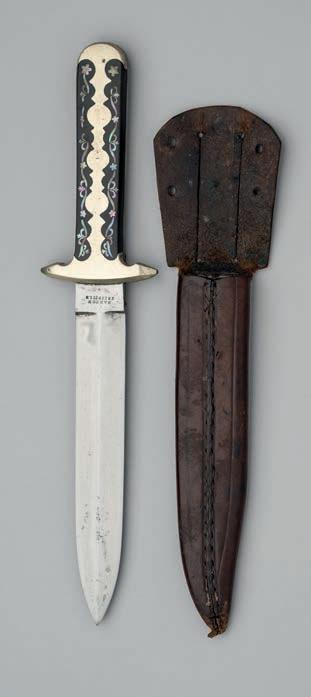

Literature
David Hayden-Wright, The Heritage of English Knives, Atglen, Pennsylvania, 2008, p. 290.
£250-300
697 698 699 700 79
702
701
701
A HUNTING KNIFE FOR THE AMERICAN MARKET, MAPPIN & WEBB, SHEFFIELD, CIRCA 1880

with robust blade formed with a clipped-back point with false swage, notched at the forte, stamped ‘Celebrated American Hunting Knife’ in capital letters, ‘Self Defender’ in script on a scroll, rectangular ricasso stamped with the maker’s name and ‘Trustworthy’ on one face of the ricasso and ‘US’ on the other, German silver oval cross-piece and chequered horn scales retained by six rivets, in its German silver mounted leather scabbard with locket and chape each engraved with groups of three lines, and the former with a stud for suspension, 25.3 cm blade
Literature
David Hayden-Wright, The Heritage of English Knives, Atglen, Pennsylvania, 2008, p. 262. £600-800

702
TWO SPORTSMAN’S KNIVES, MAPPIN & WEBB, SHEFFIELD AND THREE FURTHER SPORTMAN’S KNIVES EARLY 20TH CENTURY the first with signed folding blade, pincers, snips and button hook, nickel silver body and loop; the second with signed folding blade, cigar cutter and corkscrew; the third Lockwood Brothers, Sheffield, with five folding elements including farriers hook; the fourth by the same with cartridge extractor, and another Joseph Elliott & Sons, with seven folding elements and nickel silver body, 9.3 cm (closed) (5)

Literature
David Hayden-Wright, The Heritage of English Knives, Atglen, Pennsylvania, 2008, p. 153. £250-400
703
A HUNTING KNIFE, MAPPIN BROTHERS, QUEENS CUTLERY WORKS, SHEFFIELD, THIRD QUARTER OF THE 19TH CENTURY with broad blade formed with a swaged spear point and struck with the maker’s details on one face, thick elliptical steel guard, natural staghorn grip, and iron cap pommel, in its German silver mounted leather-covered wooden scabbard, 25.3 cm blade

Literature
David Hayden-Wright, The Heritage of English Knives, Atglen, Pennsylvania, 2008, p. 306. £350-450
703 See page iii for Buyer’s Premium and other charges 80
704
A SMALL DAGGER, JOSEPH MAPPIN & BROTHERS, MID-19TH CENTURY

with polished double-edged blade signed on each side of the ricasso, German silver hilt comprising straight quillons with bulbous terminals and faceted ferrule, and polished horn grip with German silver cap pommel, in its German silver-mounted leather-covered wooden scabbard, 13.2 cm blade
Literature
David Hayden-Wright, The Heritage of English Knives, Atglen, Pennsylvania, 2008, p. 296.

£200-250
705
AN ARMY STAND KNIFE, 20TH CENTURY AND AN ENGINEER’S KNIFE, W. MILLS & SON, SHEFFIELD the first with four folding elements including button hook and gouge, nickel-plated body stamped ‘Celebrated “Stand” army knife’, with loop; the second with four folding elements comprising three differing blades and a ruler, the body with a continuation of the ruler on one face, inscribed ‘Bristol’ and with an F2 biplane, the first: 10.7 cm (2)
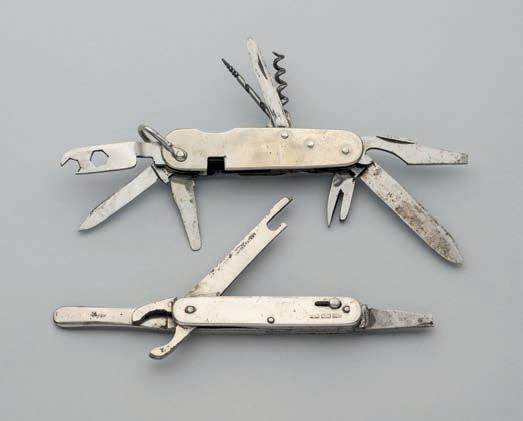
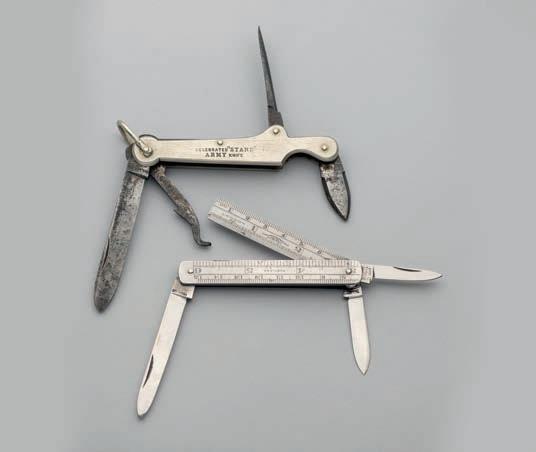
Literature
David Hayden-Wright, The Heritage of English Knives, Atglen, Pennsylvania, 2008, p. 171.
£100-200
706
A WATTS PATENT CYCLE KNIFE, SHEFFIELD, LATE 19TH/EARLY 20TH CENTURY, AND A MOTORING KNIFE, the first with four folding elements including tyre lever, pincer and blade screw driver, and nickel plated body stamped ‘Watts Patent’; the second probably by John Milner & Co., with ten folding elements including blades, screw drivers, bottle opener, spanner, corkscrew and trace borer, nickel-plated body, and steel loop, the first: 10.7 cm (closed) (2)
Literature
David Hayden-Wright, The Heritage of English Knives, Atglen, Pennsylvania, 2008, p. 145.
£400-500
704 705 706 81
707
A LOCK KNIFE, MOORE, PROBABLY SHEFFIELD, LATE 19TH CENTURY AND TWO FURTHER LOCK KNIVES
the first with folding locking blade, signed rectangular ricasso, two-piece German silver guard, natural staghorn scales over brass fillets, and vacant German silver escutcheon; the second and third of similar form, with German silver guards and pommels each cast with scrolling foliage in low relief, and polished horn scales, the first: 13.2 cm (closed) (3)

£200-250
708
A SPORTSMAN’S KNIFE, W. MORTON & SONS, SHEFFIELD, LATE 19TH CENTURY
with eight folding elements, the larger five signed at the ricasso, including knife, saw, turn screw, button hook and trace borer, chequered horn scales with concealed pricker and tweezers, and German silver loop, 15.5 cm (closed)


Literature
David Hayden-Wright, The Heritage of English Knives, Atglen, Pennsylvania, 2008, p. 150.
£500-700
709
A MILITARY STYLE FOLDING KNIFE, A. MORTON, SHEFFIELD, LATE 19TH CENTURY with folding locking blade formed with a clipped-back point, signed at the ricasso and with a pair of scales mark, folding German silver cross-piece, natural staghorn grips, with its leather holster, 19.7 cm blade
Literature
David Hayden-Wright, The Heritage of English Knives, Atglen, Pennsylvania, 2008, p. 131.
£200-220
710
AN ARKANSAS BOWIE KNIFE, MORTON & SON, SHEFFIELD, CIRCA 1850-60 with tapering blade of flattened-diamond section, recessed rectangular ricasso struck with the maker’s details (worn, partly illegible), German silver hilt comprising ‘split’ cross-guard and two-piece pommel each decorated with scrolls and foliage in low relief, and a pair of small bone scales retained by two rivets, 22.7 cm blade

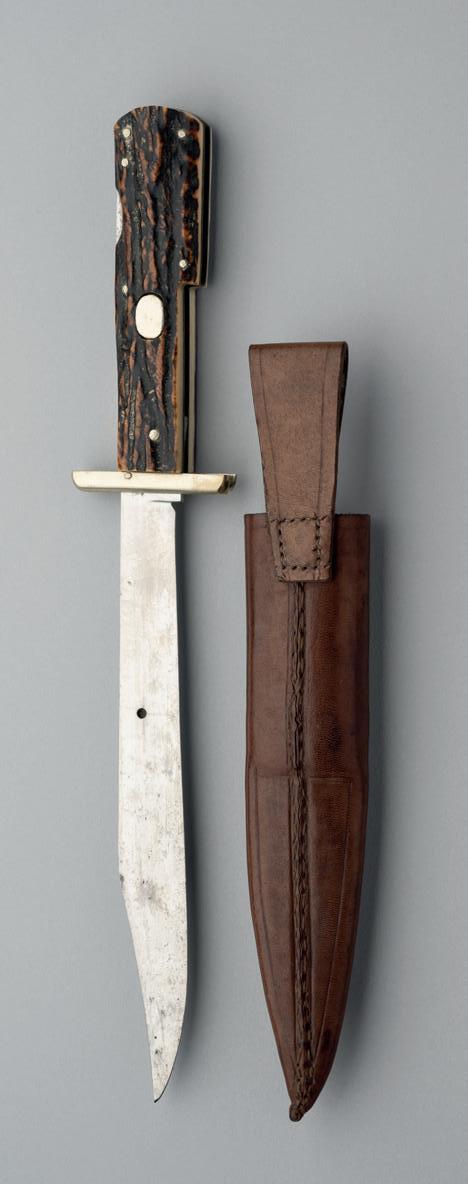
Literature
David Hayden-Wright, The Heritage of English Knives, Atglen, Pennsylvania, 2008, p. 266.
£200-300
707 708 709 See page iii for Buyer’s Premium and other charges 710 82
711
A FINE BARREL KNIFE FOR DISPLAY, JOHN NOWILL & SONS, SHEFFIELD, LATE 19TH CENTURY
with four groups of nine differing folding blades at each end (small chips and losses), milled copper alloy fillets, engraved mother-of-pearl scales, and silver top terminal, on a wooden stand with blue velvet covered base and glass dome cover, perhaps the original, the knife: 10.5 cm (closed)

Literature
David Hayden-Wright, The Heritage of English Knives, Atglen, Pennsylvania, 2008, p. 76

See footnote to lot 713.
£2,000-2,500
712
NINE VARIOUS CLASP KNIVES, 20TH CENTURY
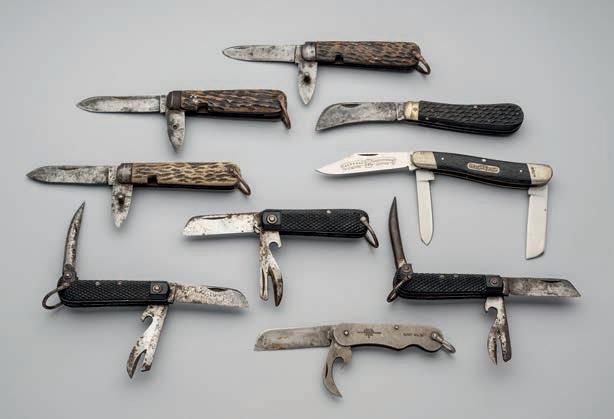
the first R. F. Mosely, Sheffield, with two folding blades and staghorn scales; another R.H. & Sons, similar; another, T. Ellin & Co, Sheffield, similar; three of military style, with chequered scales; a Schrade I. XL Wostenholm limited edition knife, dated 1980, with three folding blades; and two further knives, the first: 10.5 cm (closed) (9)
Literature
David Hayden-Wright, The Heritage of English Knives, Atglen, Pennsylvania, 2008, p. 156.
£150-200
711
83
712
A RARE FOLDING HUNTING KNIFE, J. NOWILL & SONS, SHEFFIELD, CIRCA 1845


with long tapering wavy blade of burnished steel, signed by the maker between a ‘D*’ and crossed keys mark on one face at the forte, locked by a spring-catch and released by a heart-shaped German silver button in a half-length grip, German silver fillets, engraved German silver terminals decorated with flowers and foliage, and chequered ivory grips, in its leather scabbard, probably the original, 26.0 cm (closed)
Literature
David Hayden-Wright, The Heritage of English Knives, Atglen, Pennsylvania, 2008, p. 91.
The D* mark was first used by one Thomas Nowill (circa 16761704, recorded as a ‘Maker of Knives’. J. Nowill & Sons won a prize medal at the Great Exhibition in London in 1851 for ‘…..a display of cutlery comprising…..pocket knives, Indian hunting knives…..and an ‘assortment of knives for the Levant’. The firm had considerable export business with outlets in Turkey, Greece and Egypt, and the influence is clear in the kris-style blade on the present knife.

A UK Ivory Act 2018 certificate for this lot will be made available to the purchaser
£1,000-1,500
714
A 1902 EDWARD VII SILVER CORONATION PENKIFE, J. NOWILL & SONS, SHEFFIELD AND A GRETNA GREEN SOUVENIR KNIFE
the first with three gilt folding blades, silver scales decorated with the Royal cypher, two crowns and the date, complete with its leather case; the second with two blades and the body inscribed and with the anvil and blacksmiths shop, the first: 7.8 cm (2)
Literature
David Hayden-Wright, The Heritage of English Knives, Atglen, Pennsylvania, 2008, p. 157.
£100-150
713
~
713 See page iii for Buyer’s Premium and other charges 714 84
AN EXTREMELY RARE SCISSOR SWORD FOR EXHIBITION, GEORGE OATES, SHEFFIELD, MID-19TH CENTURY formed of a pair of blades each of triangular section and slightly hollowed on the inner face, etched with scrolling foliage on the lower half on each face, one inner face signed in full and the outer faces retaining some blued finish, fluted ricasso incorporating the pivot joint, engraved German silver stirrup hilt decorated with oak foliage and acorns, crown pommel, the grip formed with a pair of oval holes and divided down the centre, in a later scabbard, 79.0 cm blade

Literature
David Hayden-Wright, The Heritage of English Knives, Atglen, Pennsylvania, 2008, p. 104.
Stated to have been made for the Great Exhibition in 1851. George Oates is first recorded around 1837 as a scissor and dagger maker at 14 Steel House Lane, and by 1841, as scissor manufacturer and beer house keeper of 40 Hoyle Street. In 1851 he had left Hoyle Street, dropped the beer house and moved to Gatefield Works, Loxley employing 30 people. He died ten years later in 1861.
£1,500-2,000

715
715 85
716
A BOWIE KNIFE, G. & J. OXLEY, SHEFFIELD, CIRCA 1880 with single-edged blade formed with a clipped-back point, signed on a scroll and inscribed ‘Texas Ranger’s Knife’, signed recessed rectangular ricasso, pewter hilt cast in one piece including integral guard and pistol grip decorated with scrolls, in a tooled and gilt leather scabbard, perhaps the original, with German silver mounts, 21.7 cm blade

Literature
David Hayden-Wright, The Heritage of English Knives, Atglen, Pennsylvania, 2008, p. 288.
£250-300
~ 717
A FOLDING LOCK KNIFE, JOHN PETTY, 20TH CENTURY comprising single clip-point blade stamped by the maker at the ricasso, German silver fillets, filed springs applied with minute pieces of ivory and engraved German silver, polished horn scales inlaid with flowers in ivory and mother of pearl, and German silver loop, 15.0 cm (closed)


Literature
David Hayden-Wright, The Heritage of English Knives, Atglen, Pennsylvania, 2008, p. 92.
John Thomas Petty (circa 1818-1887) is recorded as a grocer and shopkeeper around the mid-19th century. In 1868, he advertised as a maker of farriers’ and oyster knives and established a thriving business which later passed to his sons John Thomas Petty (1848-1931) and Joseph Heald Petty (1856-1920). In 1881 the firm had six employees but they expanded considerably towards the end of the century to Perth Works, a three storey building at 60 Garden Street that could have provided employment for up to a hundred hands. They built a solid reputation for their butchers’ and trade knives as well as some fine exhibition pocket knives. Abbreviated from Tweedale 2019 and Hawley 2023.
£600-800
~ 718
TWO FOLDING BOWIE KNIVES, JOHN PETTY, SHEFFIELD, 20TH CENTURY
of exhibition quality, almost forming a pair, each with long folding blade locked by a sliding catch on the back and forming a short dagger when closed, with clipped-back point, notched and filed back-edge, inscribed ‘Petty’s Celebrated Sheffield’ enclosing barrel device and ‘stainless’ on one face, one blade stamped with the maker’s details at the ricasso, German silver mounts and fillets, and ebony and tortoiseshell scales inlaid with mother-of-pearl and German silver flowers enriched with small pieces of ivory, the larger, 21.8 cm (closed) (2)
Literature
David Hayden-Wright, The Heritage of English Knives, Atglen, Pennsylvania, 2008, p. 92.

See footnote to lot 717.
£500-800
719
A FOLDING LOCK KNIFE, JOHN PETTY & SONS, CIRCA 1900 comprising single clip-point blade stamped by the maker at the ricasso, German silver fillets, filed springs applied with minute pieces of ivory, polished horn scales inlaid with flowers in ivory and mother of pearl, and German silver loop, 15.0 cm (closed)

Literature
David Hayden-Wright, The Heritage of English Knives, Atglen, Pennsylvania, 2008, p.89.
See footnote to lot 717.
£200-300
716 717 718 719 See page iii for Buyer’s Premium and other charges 86
A SPORTSMAN’S KNIFE, JOHN PETTY & SONS, SHEFFIELD, LATE 19TH CENTURY
with ten folding elements including signed pen blade, saw, screw driver, trace borer, awl, button hook and bodkin, German silver fillets, natural staghorn scales with concealed tweezers, pricker and ruler, German silver loop and vacant escutcheon, 13.2 cm (closed)
Literature
David Hayden-Wright, The Heritage of English Knives, Atglen, Pennsylvania, 2008, p. 152.
See footnote to lot 717.
£500-700
721
A SPORTSMAN’S KNIFE, JOHN PETTY & SONS, SHEFFIELD, LATE 19TH CENTURY
with twelve folding elements including signed pen blade, saw, screw driver, trace borer, awl, button hook, bodkin and pincers, copper alloy fillets, chequered horn scales with concealed tweezers and pricker, German silver beadwork loop and vacant escutcheon, 12.8 cm (closed)
Literature
David Hayden-Wright, The Heritage of English Knives, Atglen, Pennsylvania, 2008, p. 152.
See footnote to lot 717.
£450-600
722
A SPORTSMAN’S KNIFE, JOHN PETTY & SONS, SHEFFIELD, LATE 19TH CENTURY

with thirteen folding elements including signed pen blade, saw, screw driver, trace borer, awl, button hook and pincers, German silver fillets, natural staghorn scales with concealed tweezers and pricker, German silver loop and vacant escutcheon, 13.2 cm (closed)

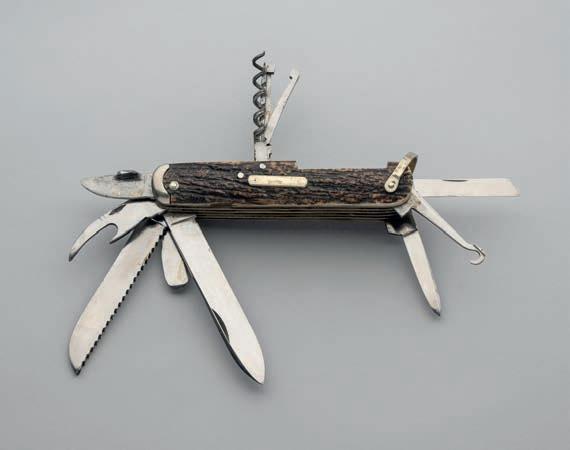
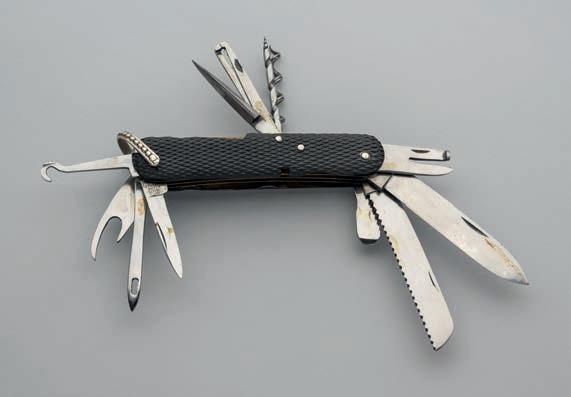
Literature
David Hayden-Wright, The Heritage of English Knives, Atglen, Pennsylvania, 2008, p. 152.
See footnote to lot 717.
£500-600
720
720
722 87
721
723
723
A SPORTSMAN’S KNIFE, JOHN PETTY & SONS, SHEFFIELD, LATE 19TH CENTURY
with eight folding elements including signed pen blade, saw, screw driver, trace borer, awl, and button hook, copper alloy fillets, natural staghorn scales with concealed tweezers and pricker, German silver loop and vacant escutcheon, 14.2 cm (closed)

Literature
David Hayden-Wright, The Heritage of English Knives, Atglen, Pennsylvania, 2008, p. 152.
See footnote to lot 717.
£450-550
724
A FOLDING POCKET KNIFE, JOHN PETTY & SONS, SHEFFIELD, LATE 19TH CENTURY

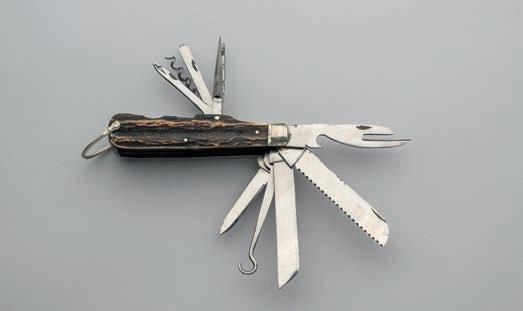
with nine folding blades and accessories, including pen blade and button hook, gilt fillets, filed details including gilt spring backs inlaid with engraved mother-of-pearl plaques, and tortoiseshell scales inlaid with engraved copper alloy flowers, 11.7 cm (closed)

Literature
David Hayden-Wright, The Heritage of English Knives, Atglen, Pennsylvania, 2008, p. 92.
See footnote to lot 717.
£400-600
724 725
725
A SPORTSMAN’S KNIFE, JOHN PETTY & SONS, SHEFFIELD, LATE 19TH CENTURY
with ten folding elements including signed pen blade, saw, bodkin, trace borer, awl, bottle opener and button hook, copper alloy fillets, natural staghorn scales with concealed tweezers and pricker, German silver loop and vacant escutcheon, 13.2 cm (closed)
Literature
David Hayden-Wright, The Heritage of English Knives, Atglen, Pennsylvania, 2008, p. 152.
See footnote to lot 717.
£400-600
726
A SPORTSMAN’S KNIFE, JOHN PETTY & SONS, SHEFFIELD, LATE 19TH CENTURY
with thirteen folding elements including signed pen blade, saw, screw driver, scissors, trace borer, awl, button hook, bodkin, corkscrew, farriers hook and bottle opener, copper alloy fillets, chequered horn scales with concealed tweezers, striker and pricker, copper alloy loop and vacant German silver escutcheon, 11.2 cm (closed)
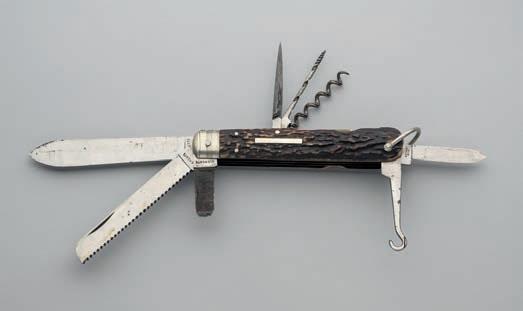
Literature
David Hayden-Wright, The Heritage of English Knives, Atglen, Pennsylvania, 2008, p. 152.
See footnote to lot 717.
See page iii for Buyer’s Premium and other charges
£300-500 726 88
727
A MOTHER-OF-PEARL MOUNTED FOLDING SPORTSMAN’S KNIFE, JOHN PETTY, SHEFFIELD, LATE 19TH/EARLY 20TH CENTURY AND FIVE FURTHER MOTHER-OF-PEARL MOUNTED SPORTSMANS KNIVES
the first with four folding blades and scissors, gilt filed springs and fillets, and mother-of-pearl scales inlaid with gilt flowers; the second, third and fourth smaller, with five folding blades and accessories including scissors; the fifth similar, with two blades and scissors; and the sixth with twelve small folding blades, the first: 9.0 cm (closed) (6)
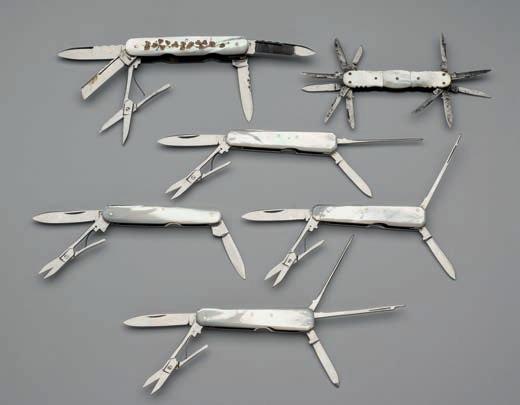
Literature
David Hayden-Wright, The Heritage of English Knives, Atglen, Pennsylvania, 2008, p. 109.
See footnote to lot 717.
£350-450
728
A FOLDING KNIFE, JOHN PETTY AND SONS, SHEFFIELD, 20TH CENTURY
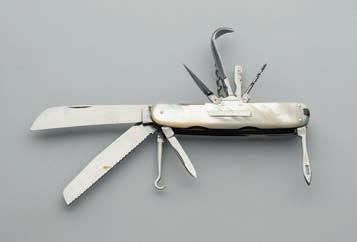
with one folding blade with clipped-back point and filed back-edge over the lower half, German silver fillets, horn scales inlaid with engraved mother-of-pearl plaques a German silver central band and a loop, 12.3 cm (closed)

Literature
David Hayden-Wright, The Heritage of English Knives, Atglen, Pennsylvania, 2008, p. 92.

See footnote to lot 717.
£200-300
729
A DESK ERASER KNIFE, JOHN PETTY & SONS, SHEFFIELD, EARLY 20TH CENTURY

with burnished blade, signed ricasso and turned wooden grip; another, Rodgers, Cutlers to His Majesty, Sheffield, with whalebone grip; another, Wostenholm, Sheffield, with carved wooden grip; a folding artist’s knife, John Petty & Sons, Sheffield; a desk knife, John Petty & Sons, Sheffield; and a rare cigar box opening knife, the first: 17.5 cm (6)
Literature
David Hayden-Wright, The Heritage of English Knives, Atglen, Pennsylvania, 2008, p. 177.
The last was reportedly found at the office of Joseph Rodgers. See footnote to lot 717.
£100-150
730
A SPORTSMAN’S KNIFE, RAWSON BROTHERS, SHEFFIELD, LATE 19TH/EARLY 20TH CENTURY
with eleven folding elements including large blade, saw, trace borer, bodkin and farriers hook, copper alloy fillets, mother-ofpearl scales, and vacant German silver escutcheon, 11.7 cm (closed)
Literature
David Hayden-Wright, The Heritage of English Knives, Atglen, Pennsylvania, 2008, p. 151.
£200-250
727
728
729
89
730
731
A BOWIE KNIFE, G. REDFERN, SHEFFIELD, LATE 19TH CENTURY with single-edged blade formed with a clipped-back point, etched with scrolls and the inscription ‘Camp Knife’ on one face, later blued finish, signed recessed rectangular ricasso, and German silver hilt comprising oval guard and solid grip cast with scrolls, 20.2 cm blade
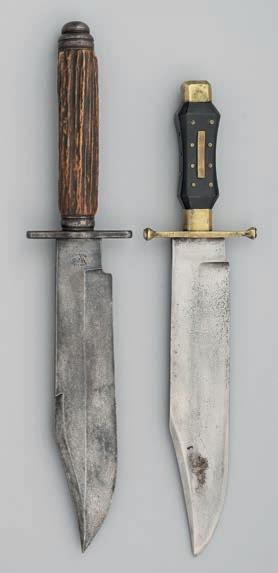
Literature
David Hayden-Wright, The Heritage of English Knives, Atglen, Pennsylvania, 2008, p. 290.
£250-300
732
A LARGE BOWIE KNIFE, ROBINSON, SHEFFIELD, AND ANOTHER, SHEFFIELD WORKS PHILADELPHIA, SECOND HALF OF THE 20TH CENTURY
the first with robust blade formed with a clipped-back point, signed recessed ricasso, iron guard, natural staghorn grip and turned iron pommel; the second with broad blade with clippedback point, signed ricasso, brass hilt and horn grip studded with brass nails, the first: 25.0 cm blade (2)
Literature
David Hayden-Wright, The Heritage of English Knives, Atglen, Pennsylvania, 2008, p. 284.
£300-400
733
A CASED BOWIE KNIFE, HERBERT ROBINSON, SHEFFIELD, SECOND HALF OF THE 20TH CENTURY with broad blade formed with a clipped-back point, stamped with the maker’s name, ‘Grinder’ and an outline of a figure at a stone on one face, etched and blued ‘True Patriot’s’ and ‘Protector’ in large letters on the respective faces, signed recessed rectangular ricasso, German silver hilt shaped for the fingers including scrolling straight cross-guard and pommel, and wooden scales inset with a plaque inscribed ‘Herbert Robinson, Royal Exhibition, London’, in a lined and fitted case, 23.8 cm blade


Literature
David Hayden-Wright, The Heritage of English Knives, Atglen, Pennsylvania, 2008, p. 292-3.
£500-700

See page iii for Buyer’s Premium and other charges
731 733 732
90
734
A COACHMAN’S KNIFE, JAMES RODGERS, SHEFFIELD, MID-19TH CENTURY

with eleven folding elements including signed blade, saw, farriers hook, fleam, trace borer, and corkscrew, iron fillets and natural staghorn scales with concealed tweezers, pick and concealed knife, 9.5 cm (closed)

Literature
David Hayden-Wright, The Heritage of English Knives, Atglen, Pennsylvania, 2008, p. 154.
James Rodgers is recorded circa 1758-1829. He established James Rodgers & Co and, with Philip Unwin, Unwin & Rodgers. Following his death in 1829 the company continued, with cutlery stamped ‘Unwin and Rodgers’, ‘James Rodgers & Co.’ and ‘James Rodgers’. It is likely that the continued use of the Rodgers name was largely due to its echoes of the illustrious Joseph Rodgers & Sons. Abbreviated from Tweedale 2019 and Hawley 2023.
£250-300
735
A FOLDING KNIFE, SHEFFIELD, LATE 19TH CENTURY, PROBABLY JOHN SELLERS & SONS with folding blade formed with a clipped point and finely filed back-edge, struck with the maker’s mark, the letters ‘SS’ enclosed by four daggers at the ricasso, spring back filed en suite, German silver fillets, mother-of-pearl scales and each side with three finely engraved German silver plaques decorated with scrolling foliage, 21.7 cm (closed)


Literature
David Hayden-Wright, The Heritage of English Knives, Atglen, Pennsylvania, 2008, p. 89.
£400-500
736
A TAYLOR EYEWITNESS PATENT KNIFE WITH COMPASS, SHEFFIELD, CIRCA 1940 with single-edged blade formed with a clipped-back point, etched with the maker’s details and patent ‘329566’ on one face, brass guard (one quillon removed) and chequered grip set with a compass on one face, 11.3 cm blade
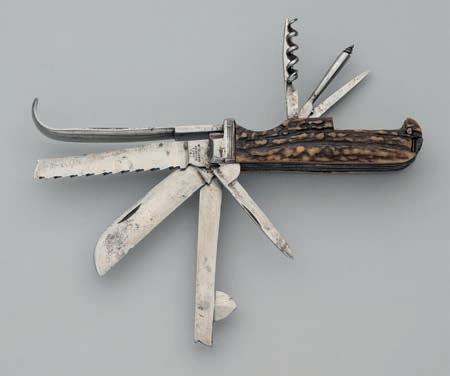
£150-200
737
A BOWIE KNIFE, TEMPORAL, SHEFFIELD, LATE 19TH CENTURY AND LATER with broad blade formed with a three-quarter length clipped-back point, signed recessed rectangular ricasso, German silver guard, and natural staghorn grip, in its tooled leather scabbard with German silver mounts, 25.8 cm blade
Literature
David Hayden-Wright, The Heritage of English Knives, Atglen, Pennsylvania, 2008, p. 285.
£150-200
91
734 736 737
735
738
A PERCUSSION KNIFE-PISTOL ‘SELF PROTECTOR’, UNWIN & RODGERS, SHEFFIELD, BIRMINGHAM PROOF MARKS, CIRCA 1860 with tapering octagonal German silver barrel stamped ‘Unwin & Rodgers’ and with Birmingham proof marks on the left at the breech, the frame faced in polished cow horn over brass fillets, folding iron trigger and with two folding blades of differing size, the larger etched ‘Self Protector’ and with foliage and the smaller stamped with the maker’s details, the butt with folding German silver cap, and retaining its original steel tweezers, and German silver bullet mould 17.0 cm (closed)
Literature
David Hayden-Wright, The Heritage of English Knives, Atglen, Pennsylvania, 2008, p. 105. For other examples see Winant 1965, pp. 122-125.
£600-800
739
A FOLDING DOUBLE KNIFE, UNWIN & RODGERS, SHEFFIELD, CIRCA 1880 AND A FOLDING DIRK, EARLY 19TH CENTURY
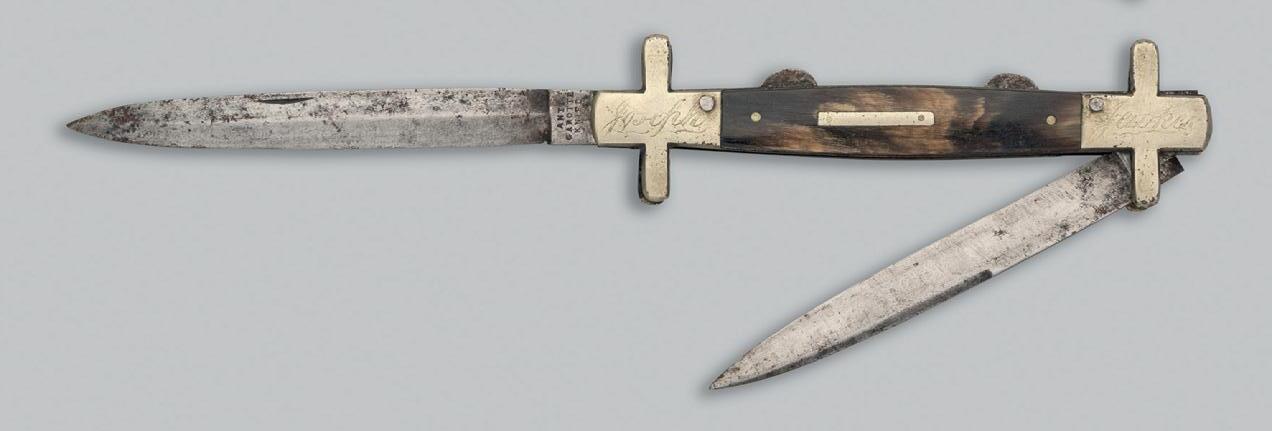
the first with two folding locking blades, each double-edged towards the point, with traces of etched decoration, on signed by the maker and the other stamped ‘anti garotte knife’ at the ricasso, German silver double quillons at each end, one inscribed ‘Joseph Fawkes’, brass fillets, horn scales and German silver escutcheon; the second with folding locking wavy blade, stamped ‘E.V.’ at the ricasso, slender iron quillons, and mother-of-pearl scales, the first: 13.2 cm (closed) (2)
Literature
David Hayden-Wright, The Heritage of English Knives, Atglen, Pennsylvania, 2008, p. 239.

£300-450
740
A FISHERMAN’S POCKET KNIFE, WADE & WINGFIELD, SHEFFIELD, 19TH CENTURY; A PEGLEY-DAVIES ANGLER’S KNIFE AND SHAW’S FLY FISHING KNIFE, SHEFFIELD, EARLY 20TH CENTURY
the first with eight folding elements including signed blade, disgorging blade with saw, button hook, awl and spring balance chequered grip and vacant German silver escutcheon, second with four folding elements including disgorging knife, scissors and corkscrew, nickel-silver body engraved with fly nos. 8 to 16 on one face and a ruler on the other, in its pigskin holster with three files; the third similar, numbered 2789 on the inside, and with two registration numbers on the body, the first: 8.8 cm overall (3)


Literature
David Hayden-Wright, The Heritage of English Knives, Atglen, Pennsylvania, 2008, p. 149.
£500-700
738 739 740 See page iii for Buyer’s Premium and other charges 92
A MASSIVE BOWIE KNIFE, WADE & BUTCHER, SHEFFIELD, LATE 19TH CENTURY, PROBABLY FOR EXHBITION, with broad heavy blade double-edged at the point, signed in block capitals beneath the back-edge on one face, recessed rectangular ricasso marked ‘XCD’, off-set German silver oval guard, pistol grip hilt with milled copper alloy fillets and natural staghorn scales retained by four rivets, in a leather scabbard, perhaps its original, with belt loop, 47.0 cm blade

Literature
David Hayden-Wright, The Heritage of English Knives, Atglen, Pennsylvania, 2008, p. 286.
£1,500-2,000

741
741 93
742
A BOWIE KNIFE, WRAGG & SONS, SOLLY ST, MID-19TH CENTURY with broad double-edged blade, recessed ricasso signed in small stamped letters, German silver cross-piece and pommel, the latter cast with an alligatorhorse on each face, and horn scales (restorations), in its tooled and gilt leather scabbard with German silver mounts, 30.8 cm blade

Literature
David Hayden-Wright, The Heritage of English Knives, Atglen, Pennsylvania, 2008, p. 288.
£1,000-1,200
~ 743
A MINIATURE POCKET KNIFE, WRAGG & SON, SHEFFIELD, LATE 19TH/20TH CENTURY AND FOUR EXTRA THIN POCKET KNIVES the first with two folding blades, awl and cork screw, brass fillets and mother-ofpearl scales; the second by Petty & Sons, with two folding blades and polished horn grips; the third with two blades and button hook; the fourth with two folding blades, one stamped ‘Innocent 1695’ and tortoiseshell scales; the fifth and sixth similar and the seventh with mother-of-pearl scales, the first: 5.0 cm (7)

Literature
David Hayden-Wright, The Heritage of English Knives, Atglen, Pennsylvania, 2008, p. 108 and 121.
£200-300

742 See page iii for Buyer’s Premium and other charges 743 94
744
744
A MULTI-BLADED PENKNIFE, H. YOULE, 23 BURGESS STREET, SHEFFIELD comprising twenty-one blades and tools including three main blades, tenon and coarse saws, awls, borers, corkscrews, button hook, fleam, farrier’s hook with concealed folding tools, scissors, nail file, leather needle, and pickers, the main blade stamped ‘H. Youle, 23 burgess street, Sheffield’ and ‘Lempart’, flat mother-of-pearl scales, finely machined internal springs and German fillets, German silver terminals, and vacant shield-shaped escutcheon, 10.8 cm (closed)
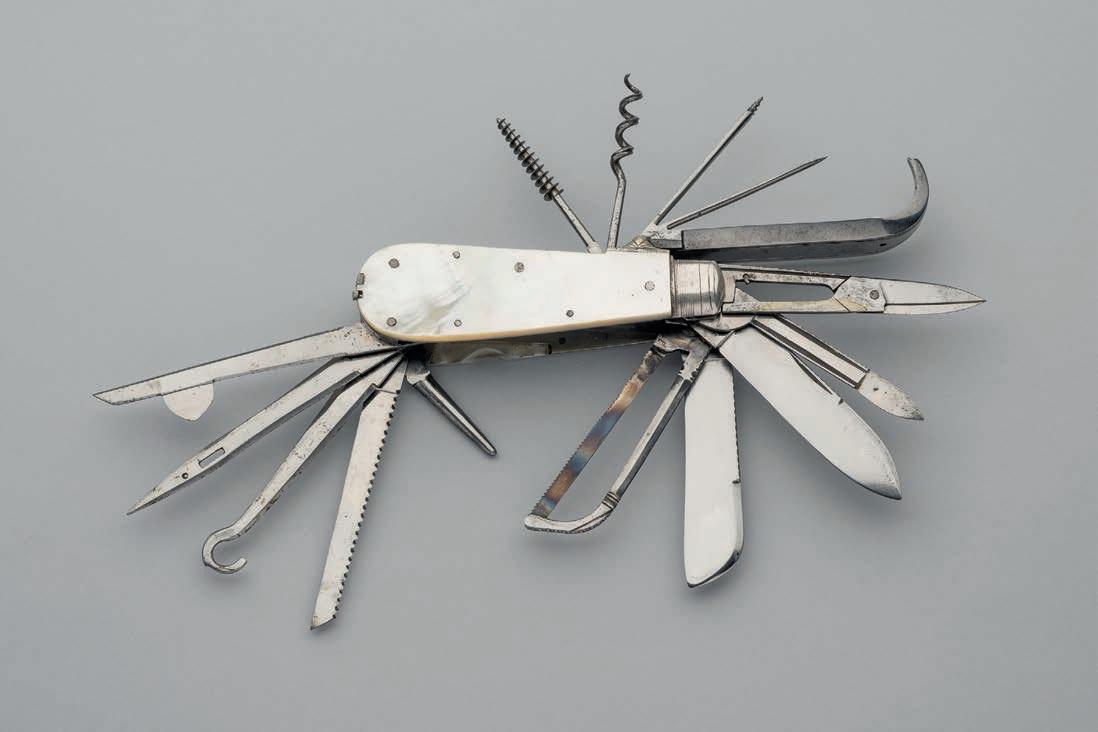
Literature
David Hayden-Wright, The Heritage of English Knives, Atglen, Pennsylvania, 2008, p.83. £1,200-1,500

95
745 747
745
FOUR SALEMAN’S KNIFE ROLLS, LATE 19TH CENTURY the first of maroon leather, lined with blued velvet, with provision for thirty knives (one small tear, strap missing); the second similar, with provision for twenty four knives, embossed with the gilt letters ‘T. B. & S.’ on the inside (strap missing); the third of green leather, with provision for eighteen knives (torn), closed by a strap; the fourth of tan leather, with provision for twelve knives (4)
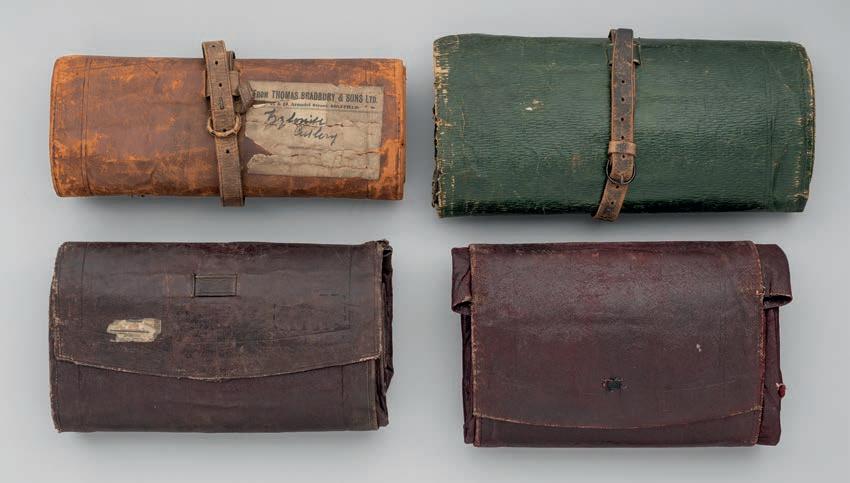
Literature
David Hayden-Wright, The Heritage of English Knives, Atglen, Pennsylvania, 2008, p. 21.
£250-300
746
SHEFFIELD CUTLERS’ TRADE LABELS, VARIOUS DATES including James Barber, Robert Baxter & Co., Coloquhoun & Cadman, Thomas Ellin & Cos., Joseph Elliot’s, Joseph Elliot & Son’s, Lockwood Brothers, John Wigfall, and John Wilson (qty)
Literature
David Hayden-Wright, The Heritage of English Knives, Atglen, Pennsylvania, 2008, pp. 207-211.

£100-200
747
SHEFFIELD CUTLERY AND OTHER TRADE CATALOGUES: GEORGE WOSTENHOLM & SON, W.H. FAGAN, AND JOHN PETTY & SONS each with paper cover (4)
£50-80
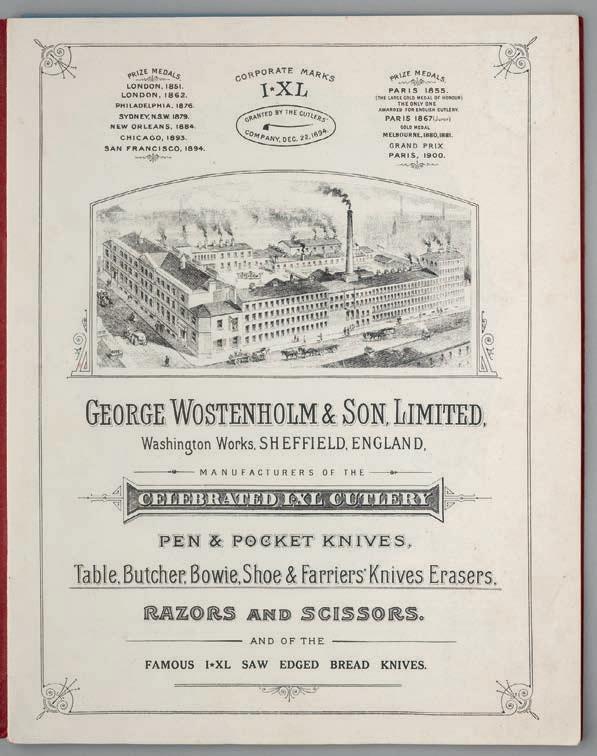
See page iii for Buyer’s Premium and other charges 96
748
A RARE LEDGER AND PATTERN BOOK, SHEFFIELD, CIRCA 1862-1920 including pages titled ‘Lancashire Journey’, ‘Liverpool Journey’, ‘West Journey’ and Irish Journey’, accounting for named individuals 1869-75; ten pages titled ‘Art patterns’, approximately twenty-five further illustrated pages of penknives including ‘The Wingfield Knife’ the ‘Soudan knife’ and further accounting details, marbled end-papers and original boards (worn, losses)


Literature
David Hayden-Wright, The Heritage of English Knives, Atglen, Pennsylvania, 2008, pp. 10-11.
£300-400

97
749
A MILITARY FOLDING LOCK KNIFE INSCRIBED TO MAJOR B. PIGOTT, XXI HUSSARS, ARMY & NAVY, DATED 1888 with folding locking blade stamped ‘A&N’ and ‘CSI’ formed with a clipped-back point, a pair of folding German silver double quillons, brass fillets, chequered scales, German silver blade release stud engraved with the date and the owner’s name, in its leather scabbard with belt loop, 17.5 cm blade
Literature
David Hayden-Wright, The Heritage of English Knives, Atglen, Pennsylvania, 2008, p. 220.
£200-250
750
A HUNTING KNIFE, PROBABLY FOR PRESENTATION BY GEORGE, PRINCE OF WALES AND LATER GEORGE V (18651936), CLARK, BOND STREET, 1905-6 with stout single-edged blade stamped with the maker’s details at the ricasso, elliptical German silver hilt, chequered grips retained by three rivets, and engraved silver presentation plaque with the crowned Prince of Wales feathers, ‘Ich Dien’, ‘G’, ‘India’ and the dates 1905-6, in its leather scabbard with belt loop, 30.5 cm overall


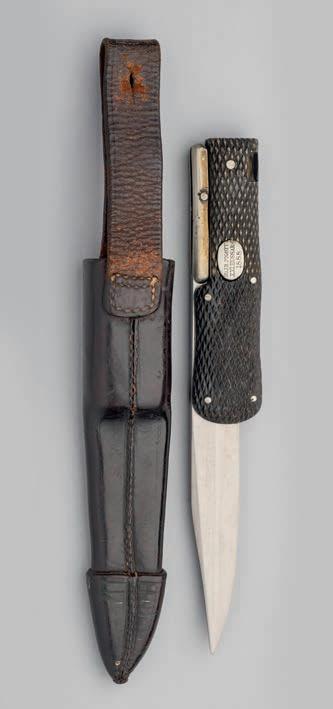
Literature
David Hayden-Wright, The Heritage of English Knives, Atglen, Pennsylvania, 2008, p. 97.

Probably made for presentation by George, later George V, when Prince of Wales during his tour of India in 1905-6. £1,000-1,500
751
A HUNTING KNIFE, COOPER & CO. 58 PICCADILY AND ANOTHER, B.B.WELLS, 431 STRAND, LATE 19TH CENTURY the first with folding locking blade signed at the ricasso, chequered horn scales and German silver mounts; the second with signed fixed blade formed with a clipped point, and chequered horn scales, in its leather scabbard with loop, the first: 23.0 cm closed (2)
Literature
David Hayden-Wright, The Heritage of English Knives, Atglen, Pennsylvania, 2008, p. 216.
£300-350
750
See page iii for Buyer’s Premium and other charges 98
749
751
752
A LARGE BOWIE KNIFE, J. DREW & SON, 33 & 37 PICCADILLY CIRCUS, W AND 156 LEADENHALL ST, EC, LATE 19TH CENTURY
with single-edged burnished blade formed with a clipped-back point, false swage, a long fuller on each face and stamped ‘Explorer’ on one face, rectangular ricasso struck with the maker’s details, German silver guard with short recurved quillons and integral ferrule, chequered ebonised pistol grip, and pierced German silver pommel, in its leather scabbard with sprung German silver safety clip (stretched), 30.5 cm blade
Literature
David Hayden-Wright, The Heritage of English Knives, Atglen, Pennsylvania, 2008, p. 277.
Drew and Sons are recorded as manufacturers of leather goods, picnic baskets and silversmiths at 33 Piccadilly Circus (1887-1914) and 156 Leadenhall Street (1888-1914).

£1,000-1,200
753
A FIGHTING KNIFE, HILL & SON, 4 HAYMARKET, LONDON, LATE 19TH CENTURY


with robust blade formed with a clippedback point, signed ricasso, chequered grip over milled brass fillets, and fitted with a spring finger-guard at the base in its leather scabbard with belt loop, 15.0 cm blade
Literature
David Hayden-Wright, The Heritage of English Knives, Atglen, Pennsylvania, 2008, p. 216.
£200-250
754
A RARE FOLDING HUNTING LANCEKNIFE, KOOYSTRA, 69 OXFORD STREET, MID-19TH CENTURY

with broad spear-point locking blade stamped ‘Kooystra, 69 Oxford St.’ at the ricasso, German silver covered locking bar, iron fillets with German silver mount at the top, natural staghorn scales applied with a German silver escutcheon on each side respectively engraved with the owner’s coat-of-arms and crest, the latter surmounting the initials ‘W.T.L.’ and the base with laterally pierced cylindrical iron mount, complete with its leather case, 32.7 cm (closed)
Literature
David Hayden-Wright, The Heritage of English Knives, Atglen, Pennsylvania, 2008, p. 90.
The arms and crest are those of the Langrishe Baronets of Knocktopher Abbey, County Kilkenny, Ireland.
J. D. Kooystra is recorded working as a cutler at this address in Johnstone’s London Commercial Guide of 1818.
£1,000-1,200
752
753
99
754
755
A LARGE BOWIE KNIFE, LUND, FLEET ST, LONDON, CIRCA 1870 with heavy single-edged blade formed with a clipped-back point, rectangular ricasso struck with the maker’s name, oval iron guard drawn-out on each side to a short quillon, copper alloy cap pommel, and natural staghorn grip, in its tooled leather scabbard with shaped German silver locket and chape each engraved with three lines and the former with a button for suspension, 30.7 cm blade

Literature
David Hayden-Wright, The Heritage of English Knives, Atglen, Pennsylvania, 2008, p. 276.
William Lund is recorded as a cutler and dressing case maker at 24 Fleet Street in 1835 having apprenticed to William Anderson, a cutler and razor manufacturer at the same address. Following his death in 1872, his son Charles continued the business as William Lund & Son.
£1,000-1,200
756
A SMALL BOWIE KNIFE, LUND, FLEET ST, LONDON, CIRCA 1880 with single-edged blade formed with a clipped-back point, rectangular ricasso struck with the maker’s name, oval iron guard drawn-out on each side to a short quillon, copper alloy cap pommel, and natural staghorn grip, in its leather scabbard with shaped German silver locket and chape each engraved with three lines, the former with a button for suspension on the front and a signed spring clip on the inside, 13.0 cm blade
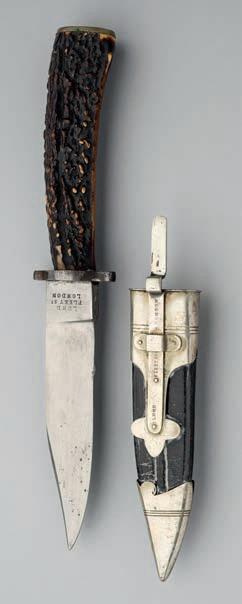
Literature
David Hayden-Wright, The Heritage of English Knives, Atglen, Pennsylvania, 2008, p. 276.

See footnote to lot 755.
£300-400
757
A MOTHER-OF-PEARL MOUNTED MANICURE SET, MACDANIEL, OXFORD STREET, EARLY 20TH CENTURY AND A CASED PAIR OF FRENCH SCISSORS, 20TH CENTURY comprising signed scissors and two folding knives, matching corkscrew, tweezers, pick and button hook, a further pair of associated scissors, on a fitted tray contained within a matching case; the second of burnished steel, in their fitted case; together with a leather scabbard for a pair of scissors, three cased small blades with threaded hafts and a folding key spanner in burnished steel case, the first: 17.7 cm x 13.2 cm overall (5)
£200-250

See page iii for Buyer’s Premium and other charges
756 100
757 755
758
A BOWIE KNIFE, MORTON, 39 CHEAPSIDE, LONDON, LATE 19TH CENTURY

with single-edged burnished blade formed with a clipped-back point, a long fuller on each face and stamped ‘Explorer’ on one face, rectangular ricasso struck with the maker’s details, German silver guard with short quillons and integral ferrule, chequered ebonised pistol grip, and pierced German silver pommel, in its leather scabbard with sprung German silver safety clip, 20.4 cm blade
Literature
David Hayden-Wright, The Heritage of English Knives, Atglen, Pennsylvania, 2008, p. 277.
£500-700
A BOWIE KNIFE, PIGALL, LONDON, LATE 19TH CENTURY

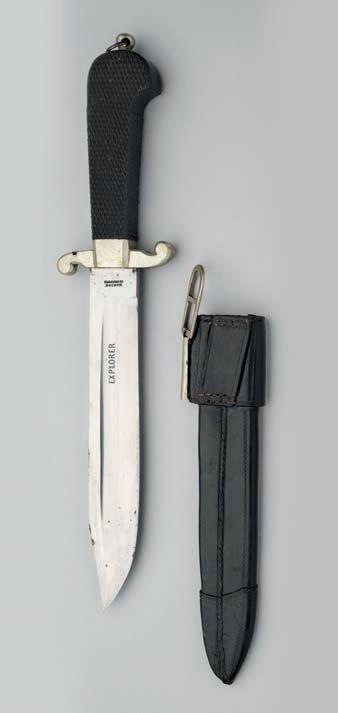
with single-edged blade formed with a clipped-back point and serrated back-edge, rectangular ricasso, German silver oval guard stamped with the maker’s name, and chequered ebony pistol grip, in its tooled leather scabbard, 19.5 cm blade
Literature
David Hayden-Wright, The Heritage of English Knives, Atglen, Pennsylvania, 2008, p. 272.
£150-200
760
A HUNTING DAGGER S. W. SILVER & CO, CORNHILL, OLD BOND STREET AND LEADENHALL STREET, LONDON, LATE 19TH CENTURY

with broad blade of flattened-diamond section, signed on one face, rectangular ricasso, oval steel guard pierced for the spring-catch, milled copper alloy fillets, shaped natural staghorn scales retained by five rivets, and vacant German silver escutcheon, in its leather scabbard with spring-catch and belt loop, 25.2 cm blade
Literature
David Hayden-Wright, The Heritage of English Knives, Atglen, Pennsylvania, 2008, p. 298.
Stephen Winkworth Silver & Co was founded in 1823 and are recorded at 66 and 67 Cornhill in 1848. They supplied clothing to the military and travellers as well as furniture and later sporting goods. By 1900 they had branches in Liverpool, Bradford, Birmingham, Sheffield, Cardiff, Bristol, Manchester, Newcastle, Portsmouth, Glasgow, Belfast and Dublin and works at Silvertown and at PersanBeaumont, France.
£800-1,200
~ 759
758 759 760 101
761
A FIGHTING KNIFE, S. W. SILVER & CO., CORNHILL, LONDON, CIRCA 1880 with robust Caucasian style broad blade of flattened-diamond section formed with a long slender off-set fuller on each face, rectangular ricasso signed on each face, German silver elliptical guard grooved on one face to accommodate a retaining clip, and finely chequered horn scales retained by six rivets, in its German silver-mounted leather-covered wooden scabbard, the chape engraved with three lines and with bud-shaped finial, locket engraved en suite, with a button for suspension and signed in a panel at the front (spring retaining clip missing), 22.7 cm blade

See footnote to lot 760.
£700-1,000
762
A SMALL AXE, S. W. SILVER & CO., LONDON, LATE 19TH/EARLY 20TH CENTURY with curved axe-blade formed with a sharp leading edge and struck with the maker’s details on one face, tapering rear pean, iron haft with moulded neck, fitted with a pair of tapering rounded hardwood panels with chequered grips over the lower portion and pierced at the base, complete with its leather cover embossed with the maker’s details and with two belt loops, 39.7 cm

Literature
David Hayden-Wright, The Heritage of English Knives, Atglen, Pennsylvania, 2008, p. 62.
See footnote to lot 760.
£200-250
763
A MILITARY FOLDING LOCK KNIFE, S. W. SILVER & CO., CORNHILL, LONDON, CIRCA 1880-90 with folding locking blade stamped with the maker’s details at the ricasso, formed with a clipped-back point, chequered scales, German silver blade locking stud, in its leather scabbard with spring release, 22.3 cm blade

Literature
David Hayden-Wright, The Heritage of English Knives, Atglen, Pennsylvania, 2008, p. 221.

See footnote to lot 760.
£200-250
761 762
See page iii for Buyer’s Premium and other charges 102
763
764
A MASSIVE BOWIE KNIFE, SIMPSON, 55 STRAND, LONDON, THIRD QUARTER OF THE 19TH CENTURY with heavy single-edged blade formed with a clipped-back point, rounded backedge and a right angular groove at the forte on each face, rectangular ricasso stamped with the crowned maker’s details on one face, iron cross-guard with bevelled edges, cap pommel en suite, and natural staghorn scales, in its fishskincovered wooden scabbard with German silver locket and chape with shaped borders, the former with a button for a frog, 29.0 cm blade
Literature
David Hayden-Wright, The Heritage of English Knives, Atglen, Pennsylvania, 2008, p. 275.
Henry Simpson is recorded at 55 Strand London around 1863.

£700-900
765
A FOLDING LOCK KNIFE FOR THE AMERICAN MARKET, SIMPSON, CIRCA 1860-70 with double-edged folding sprung locking blade struck ‘Simpson’ at the forte, German silver cross-piece cast with scrolls in low relief, German silver horsehead pommel seated on a cannon, milled copper allot fillets, and natural staghorn scales with German silver release stud locked by a small sliding bolt, 15.5 cm closed
Provenance
Stated to have been obtained from the great grandson of the original owner who emigrated to America during the gold rush and was presented with this knife by a prospector.
Literature
David Hayden-Wright, The Heritage of English Knives, Atglen, Pennsylvania, 2008, p. 240.
See footnote to lot 764.
£400-600
766
A DIRK, SIMPSON, 55 STRAND, THIRD QUARTER OF THE 19TH CENTURY with robust blade of tapering-diamond section, rectangular ricasso struck with a crown and the maker’s name, iron guard, natural staghorn grip, and German silver pommel cap, in its leather scabbard with German silver chape, 11.0 cm blade

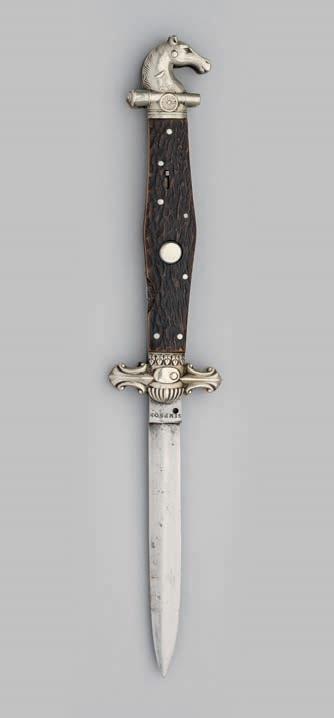

Literature
David Hayden-Wright, The Heritage of English Knives, Atglen, Pennsylvania, 2008, p. 275.
See footnote to lot 764.
£150-200
764 765 766 103
767
A RARE SILVER-MOUTED FIXED-BLADE WINGFIELD KNIFE FOR PRESENTATION BY ALBERT EDWARD, PRINCE OF WALES AND LATER KING EDWARD VII (1841-1910), THORNHILL, LONDON, 1875 WITH ASSOCIATED SILVER-MOUNTED BELT, LONDON, 1884 with fixed blade (polished) with clipped-back point and filed backedge, struck with the maker’s details, ‘Wingfield Knife’ and ‘VR’ divided by a crown, with four folding elements including corkscrew, button hook and awl, further accessories including tweezers, pincers, scissors and pricker concealed in the German silver pommel, chequered horn scales, in its silver-mounted leather scabbard with marks of Thomas Johnson, the locket with the initials ‘AE’ for Albert Edward divided by the crowned Prince of Wales feathers within the collar of the Most Noble Order of the Garter, complete with associated silver-mounted leather belt formed in five sections, with a clip for attachment, and the tip stamped on the inside ‘Thornhill & Co., 144 Bond Street, London’ 22.0 cm overall (the knife)
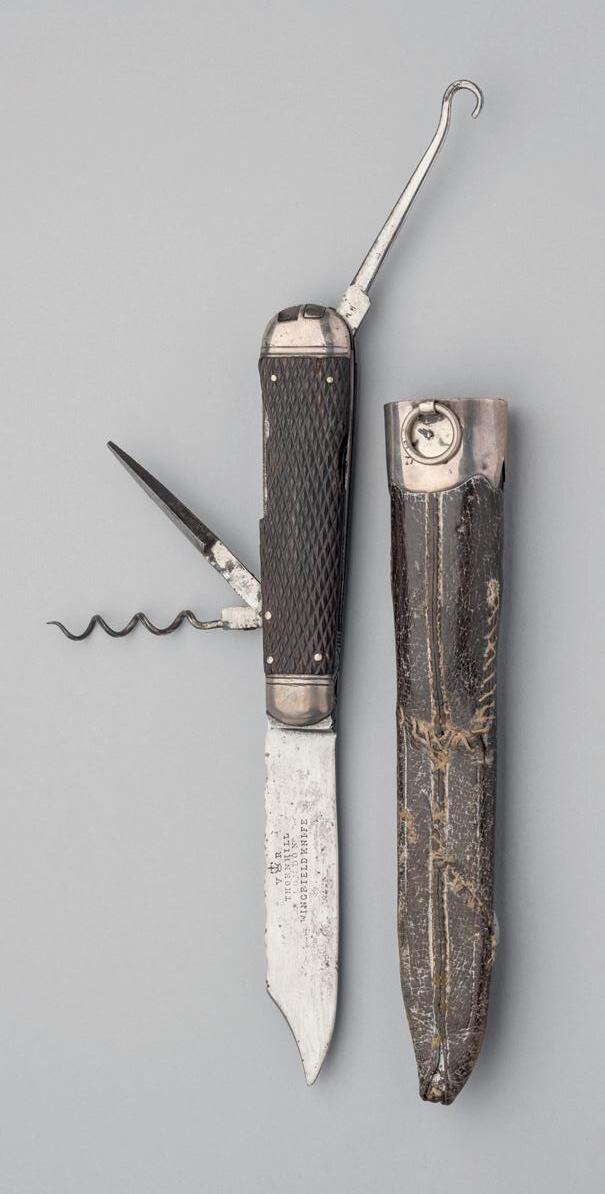
Literature
David Hayden-Wright, The Heritage of English Knives, Atglen, Pennsylvania, 2008, p. 94-5.
Probably made for presentation by Albert Edward, later Edward VII, when Prince of Wales during his tour of India in 1875-6. Thornhill & Co. are recorded 1820-1912. This well-known firm exhibited at the Great Exhibition of 1851, the Paris Exhibition in 1878, and the Sportsman’s Exhibition in Islington in 1882. For a full history see Culme 1987, pp. 448-9.
£800-1,000
768
A RARE SILVER-MOUTED FIXED-BLADE WINGFIELD KNIFE FOR PRESENTATION BY ALBERT EDWARD, PRINCE OF WALES AND LATER KING EDWARD VII (1841-1910), THORNHILL, LONDON, 1875 with fixed blade with clipped-back point and filed back-edge, struck with the maker’s details, ‘Wingfield Knife’ and ‘VR’ divided by a crown, with four folding elements including corkscrew, button hook and awl, further accessories including tweezers, pincers, scissors and pricker concealed in the German silver pommel, chequered horn scales, in its silver-mounted leather scabbard with marks of Thomas Johnson, the locket with the initials ‘AE’ for Albert Edward divided by the crowned Prince of Wales feathers within the collar of the Most Noble Order of the Garter, 22.0 cm overall (the knife)
Literature
David Hayden-Wright, The Heritage of English Knives, Atglen, Pennsylvania, 2008, p. 94-5.

Probably made for presentation by Albert Edward, later Edward VII, when Prince of Wales during his tour of India in 1875-6.
See footnote to lot 767.
£800-1,000
769
A SILVER-MOUTED FIXED-BLADE WINGFIELD KNIFE, THORNHILL, LONDON, CHESTER 1881 with fixed blade with clipped-back point and filed back-edge, struck with the maker’s details, ‘Wingfield Knife’ and ‘VR’ divided by a crown, with four folding elements including corkscrew, button hook and awl, chequered horn scales, silver pommel and ferrule, concealed tweezers with lancet, scissors and pricker (pincers missing), in its leather scabbard with silver locket with ring (chape missing), 21.2 cm overall (the knife)

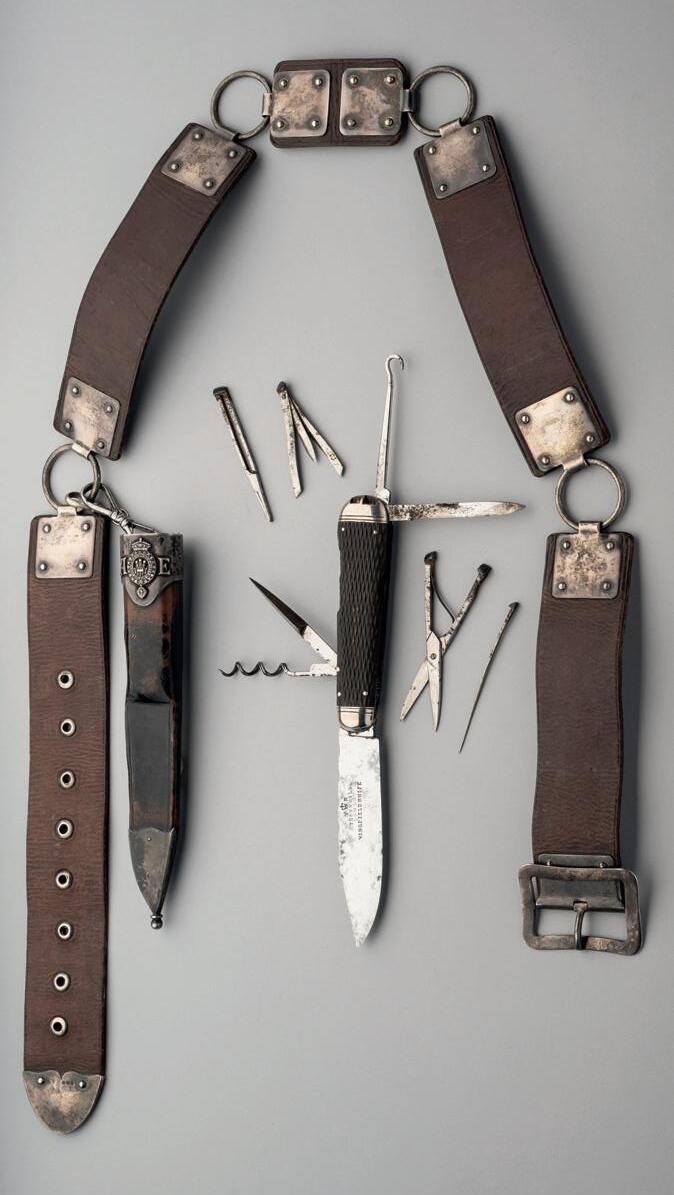
Literature
David Hayden-Wright, The Heritage of English Knives, Atglen, Pennsylvania, 2008, p. 218.
See footnote to lot 767.
£300-350
767 768 769 See page iii for Buyer’s Premium and other charges 104
A BOWIE KNIFE, THORNHILL, LONDON, LATE 19TH CENTURY with broad blade formed with a clipped-back point, struck ‘Ellis Knife’ on one face, rectangular ricasso struck with the maker’s details, the royal letters ‘VR’ divided by a crown on one face and with a diamond-shaped registration mark on the other, shaped burnished steel guard with an aperture engaging a retaining catch on the scabbard on one side, chequered grips retained by six rivets, concealed tweezers with lancet and pricker, in its leather scabbard with belt loop, 19.5 cm blade

Literature
David Hayden-Wright, The Heritage of English Knives, Atglen, Pennsylvania, 2008, p. 272.
See footnote to lot 767.
£500-700
771
A SILVER-MOUNTED FIXED-BLADE COMPANION KNIFE, THORNHILL, LONDON, 1874, PROBABLY THOMAS JOHNSON with clip-point blade stamped ‘VR’ divided by a crown, the maker’s details and ‘Wingfield Knife’, with folding small knife, button hook, corkscrew, awl incorporating a file, concealed scissors, pick, pincers, and tweezers with lancet, silver scales chased foliage inhabited by wild birds, 13.4 cm overall
Literature
David Hayden-Wright, The Heritage of English Knives, Atglen, Pennsylvania, 2008, p.84.

See footnote to lot 767.
£400-500
772
A CAMPAIGN KNIFE INSCRIBED TO C. W. DUNCOMBE, 1ST LIFEGUARDS, THORNHILL, LONDON, MID-19TH CENTURY with folding locking main blade signed at the ricasso, button hook, leather borer, and corkscrew, chequered horn scales with concealed ruler, scissors and combined tweezers and lancet, German silver loop and inscribed escutcheon, 15.0 cm (closed)


Literature
David Hayden-Wright, The Heritage of English Knives, Atglen, Pennsylvania, 2008, p. 214.
See footnote to lot 767.
£350-450
770
770 771 772 105
773
A FIGHTING KNIFE, W. THORNHILL & CO., LONDON, LATE 19TH CENTURY


with polished blade of flattened-diamond section, rectangular ricasso stamped with the maker’s details and the royal initials ‘VR’ divided by a crown, burnished steel guard with a pair of short quillons, German silver ferrule, and finely chequered moulded grip, in its pigskin scabbard with belt loop, 23.2 cm blade

See footnote to lot 767.
£400-500
774
THE GRAHAM KNIFE, W.THORNHILL & CO., LONDON LATE 19TH CENTURY AND A MAGAZINE KNIFE
the first with polished blade stamped with the maker’s details, formed with a clipped-back point and scalloped back-edge, brass fillets and chequered grips, in its scabbard; the second with copper alloy blade marked ‘BF Ltd 1944’, turned wooden grip, with RAF label inscribed ‘MK2’, the first: 12.5 cm (2)
Literature
David Hayden-Wright, The Heritage of English Knives, Atglen, Pennsylvania, 2008, p. 225. See footnote to lot 767.
£150-200
775
A SMALL AXE, THORNHILL, LONDON, LAST QUARTER OF THE 19TH CENTURY with curved axe-blade formed with a sharp leading edge and struck with the maker’s details and ‘VR’ divided by a crown on one face, moulded rear pean with the letters ‘CBW’ for branding, iron haft with moulded neck, fitted with a pair of tapering rounded hardwood panels with chequered grips over the lower portion and pierced at the base, complete with its leather cover with belt loop,33.5 cm
See footnote to lot 767.
£200-300
776
A SMALL AXE, THORNHILL, LONDON, LAST QUARTER OF THE 19TH CENTURY with curved axe-blade formed with a sharp leading edge and delicately scalloped backedge, struck with the maker’s details and ‘VR’ divided by a crown on one face, tapering moulded rear pean with the initials ‘AHW’ conjoined for branding, iron haft with moulded neck en suite with the pean, fitted with a pair of tapering rounded hardwood panels with finely chequered grips over the lower portion, 35.0 cm

Literature
David Hayden-Wright, The Heritage of English Knives, Atglen, Pennsylvania, 2008, p. 59. Axes of this type were probably carried by head gamekeepers and other senior staff on rural estates.

See footnote to lot 767.
£200-250
773 774 775 776 See page iii for Buyer’s Premium and other charges 106
778
777
A SMALL AXE, THORNHILL, LONDON, LAST QUARTER OF THE 19TH CENTURY with curved axe-blade formed with a sharp leading edge and struck with the maker’s details and ‘VR’ divided by a crown on one face, tapering rear pean, iron haft with moulded neck, fitted on each face with a pair of tapering rounded hardwood panels with chequered grips over the lower portion and pierced at the base, complete with its leather cover with belt loop (strap incomplete) 28.0 cm


Literature
David Hayden-Wright, The Heritage of English Knives, Atglen, Pennsylvania, 2008, p. 61.
See footnote to lot 767.
£200-250
778
A SMALL AXE, THORNHILL, LONDON, LAST QUARTER OF THE 19TH CENTURY with curved axe-blade formed with a sharp leading edge and struck with the maker’s details and ‘VR’ divided by a crown on one face (light surface rust), tapering rear pean, iron haft with moulded neck and basal terminal, incorporating a long signed folding saw-blade, fitted with a pair of tapering rounded hardwood panels with chequered grips over the lower portion, complete with its leather cover with belt loop (strap incomplete) 28.0 cm
Literature
David Hayden-Wright, The Heritage of English Knives, Atglen, Pennsylvania, 2008, p. 61.

See footnote to lot 767.
£200-250
779
779
A SMALL AXE, THORNHILL, LONDON, LAST QUARTER OF THE 19TH CENTURY with curved axe-blade formed with a sharp leading edge and struck with the maker’s details and ‘VR’ divided by a crown on one face, tapering moulded rear pean with the letter ‘R’ beneath an Earl’s coronet for branding, iron haft with moulded neck and fitted with a pair of tapering rounded hardwood panels with finely chequered grips over the lower portion, 30.5 cm
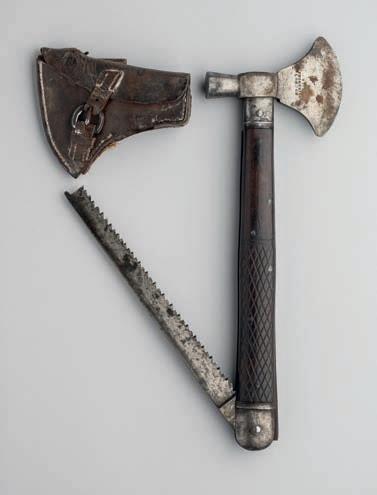
Literature
David Hayden-Wright, The Heritage of English Knives, Atglen, Pennsylvania, 2008, p. 59.
See footnote to lot 767.
£180-220
780
A RARE PAIR OF BIRCHAM PATENT DAGGER SCISSORS, THORNHILL, LONDON, CIRCA 1876 with bright blades of triangular-section, stamped ‘The Bircham Patent Dagger scissors’ on the inner face, stamped ‘Thornhill’ at the forte on one face and with patent kite mark for 29th October 1873 on the other, straight quillons with globular terminals, divided chequered grips with a spring in the centre, in original silver-mounted leather scabbard, 14.7 cm overall

Literature
David Hayden-Wright, The Heritage of English Knives, Atglen, Pennsylvania, 2008, p. 168.
See footnote to lot 767.
£600-800
777
780 107
781
AN UNUSUAL DAGGER, UNDERWOOD, 56 HAYMARKET, LONDON, EARLY 20TH CENTURY with broad blade flaring towards the tip and formed with a swaged back-edge, signed rectangular ricasso struck with the Royal letters ‘ER’ divided by a crown, German silver elliptical guard, and natural staghorn scales retained by six German silver rivets in its leather scabbard with belt loop and retaining strap, 20.7 cm blade
Literature
David Hayden-Wright, The Heritage of English Knives, Atglen, Pennsylvania, 2008, p. 285.
Henry Thomas Underwood is recorded at 56 Haymarket between 1822 until his death in 1860. Knives continued to be marked ‘Underwood’ until 1925 when the company ceased trading.

£800-1,000
782
A HUNTING KNIFE, UNDERWOOD, 56 HAYMARKET, LONDON, LATE 19TH CENTURY with signed blade formed with a clipped-back point, chequered horn scales with concealed tweezers and German silver escutcheon inscribed ‘Earl of Caledon’, in its leather scabbard with white metal mounts, 12.2 cm blade
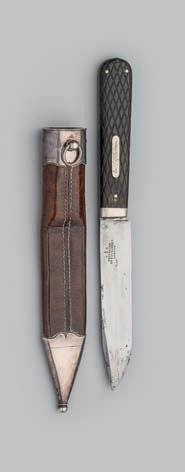
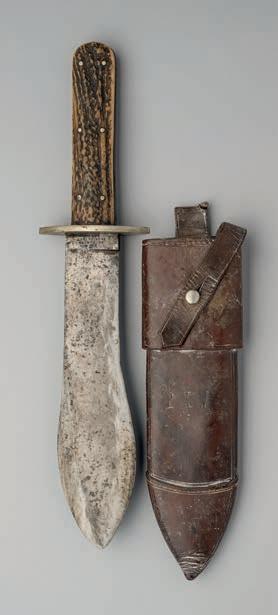
Literature
David Hayden-Wright, The Heritage of English Knives, Atglen, Pennsylvania, 2008, p. 216.
See footnote to lot 781.
£250-350
783
A SMALL AXE, UNDERWOOD, 56 HAYMARKET, LONDON, LAST QUARTER OF THE 19TH CENTURY
with curved axe-blade formed with a sharp leading edge and struck with the maker’s details on one face, tapering rear pean, iron haft with moulded neck, fitted with a pair of tapering rounded hardwood panels with chequered grips over the lower portion and pierced at the base, complete with its leather cover with belt loop, 33.5 cm
See footnote to lot 781.
£200-250
784
A SMALL AXE, UNDERWOOD, LONDON, LATE 19TH/EARLY 20TH CENTURY with wedge-shaped oblong head struck with the maker’s details, tapering rear pean with flat face, iron haft incorporating a long folding saw blade, fitted on each side with rounded hardwood panels and chequered at the base, 25.7 cm
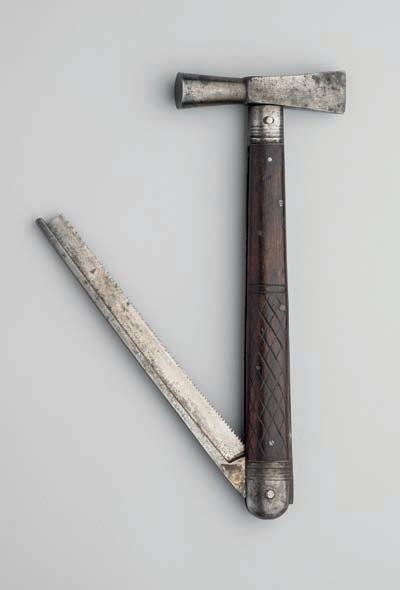

Literature
David Hayden-Wright, The Heritage of English Knives, Atglen, Pennsylvania, 2008, p. 60.
See footnote to lot 781.
£180-220
781 782 783
See page iii for Buyer’s Premium and other charges 108
784
785
A FOLDING KNIFE SAW, UNDERWOOD, LONDON AND A POCKET KNIFE, GEORGE GILL & SONS, LATE 19TH/20TH CENTURY the first with signed folding saw-blade, and figured hardwood scales; the second with six folding elements including awl and corkscrew (one blade associated) and natural staghorn scales with German silver escutcheon, the first: 15.9 cm (closed) (2)

Literature
David Hayden-Wright, The Heritage of English Knives, Atglen, Pennsylvania, 2008, p. 113.
£150-200
786
A COACHMAN’S KNIFE, WILKINSON, LONDON AND SHEFFIELD, LATE 19TH CENTURY
with eight folding elements including signed blades, farrier’s hook, scoop borer, corkscrew and cartridge extractor, copper alloy fillets, nickel silver body stamped ‘Par-a-gon’ on each face and loop, 12.7 cm (closed)

Literature
David Hayden-Wright, The Heritage of English Knives, Atglen, Pennsylvania, 2008, p. 155.
£200-250
785
786
787
A BOWIE KNIFE, WILKINSON SWORD CO., EARLY 20TH CENTURY with single-edged blade formed with a clipped-back point, stamped ‘Celebrated American Hunting Knife’ and with a long slender fuller on one face, recessed rectangular ricasso signed by the maker on the reverse, German silver guard, chequered scales retained by five rivets, in its leather scabbard with belt loop, 23.0 cm blade

Literature
David Hayden-Wright, The Heritage of English Knives, Atglen, Pennsylvania, 2008, p. 278.
£1,000-1,500
788
A BOWIE KNIFE, WILKINSON, LONDON, EARLY 20TH CENTURY with robust blade formed with a clipped-back point, etched with the maker’s details, Royal warrants to the King and Prince of Wales, and ‘Finest sword steel England’, German silver guard, natural staghorn scales retained by five rivets, in its scabbard, 14.8 cm blade


Literature
David Hayden-Wright, The Heritage of English Knives, Atglen, Pennsylvania, 2008, p. 272.
£150-200
787
788
109
789
A RARE RBD HUNTING KNIFE NO. 2, HENRY WILKINSON, PALL MALL, LATE 19TH CENTURY
with heavy broad blade formed with a clipped-back point and false swage, straight figure-of-eight shaped plated iron cross-guard and cap pommel, and natural staghorn grip, in its wooden scabbard with tooled leather covering and spring release catch, 25.2 cm blade

Literature
David Hayden-Wright, The Heritage of English Knives, Atglen, Pennsylvania, 2008, p. 233.
£1,500-2,000
790
A RARE RBD HUNTING KNIFE NO. 1, WILKINSON, PALL MALL, LATE 19TH CENTURY
with broad blade formed with a clippedback point and false swage, straight figure-of-eight shaped plated iron crossguard (pommel missing), and natural staghorn grip, in its wooden scabbard with tooled leather covering and spring release catch, complete with leather frog with belt loop, 17.5 cm blade
Literature
David Hayden-Wright, The Heritage of English Knives, Atglen, Pennsylvania, 2008, p. 232.
£1,000-1,200
791
A ‘SHAKESPEARE’ KNIFE, WILKINSON, PALL MALL, EARLY 20TH CENTURY with broad double-edged blade with traces of etched maker’s inscription, oval steel guard, chequered two piece grips, in its wooden scabbard with tooled leather covering, spring-clip and frog with belt loop, 14.7 cm blade



Literature
David Hayden-Wright, The Heritage of English Knives, Atglen, Pennsylvania, 2008, p. 234.
£700-900
END OF SALE
789 790 791 See page iii for Buyer’s Premium and other charges 110
Antique Arms, Armour & Militaria
28th June 2023

Antique Arms, Armour & Militaria
6th December 2023




